Good evening, ladies and gentlemen. This is Miss Cassette, speaking to you from the Field Club Historic Neighborhood. I am told they used to hold magic shows, called Mystery Seances, at 3316 Center Street in the old days. The Field Club homeowners were magicians–a husband and wife team. So skilled and innovative in their art, people traveled from all over the world to observe first-hand the spellwork of David P. Abbott and wife/assistant, Fannie Abbott, in their House of Mystery. Expert wonder workers and the uninitiated alike were ushered into the large Craftsman Bungalow for invite-only, midnight parlor gatherings, often in the colder Midwestern months, as these were said to be Magician Abbott’s preferred conditions. The legendary shows went on into the wee hours. The secret is that 3316 Center Street was a central player of the cast in these Mystery Seances. In fact, she was built for every facility of the show, at every corner and in the walls. Silk magnet wires, hidden springs, sending and receiving coils on the floor, tiny, unnoticed hooks nestled in her library columns and within eccentric, exotic, worldly furnishings, early horn speakers were not seen, a woman much like an early switchboard operator behind a curtain, masked men hiding beyond her glass pantry door and rumors of a hidden, magic laboratory were just hints of her peculiar attributes.
The ticking sound you hear is the vibration of detective clockwork.
Listening to an interview many moons ago, I heard the often-thought silent Teller, of famous magician duo Penn & Teller, talking about an amateur Omaha magician, not well known to most people. I had never heard of this David P. Abbott. Of course, my ears perked up, knowing I needed to investigate this mystery man and research his house. I dug in. What a strange kinship that the long-deceased magician named his Midtown home House of Mystery and that I researched houses in the context of Mysteries of Omaha. I was instantly drawn to him. Like so many incredible people who have lived in Omaha, quietly honing their craft unbeknownst to their neighbors, David P. Abbott was a magician’s magician—known internationally and yet unrecognizable in his hometown. This curiosity happens with such regularity that the stars point to Friendly-But-Mind-Your-Own-Business-Omaha as the perfect place to hatch a plan. (There are other explanations but none as flattering.) I properly filed the Abbott name and my brief examination into yet another Mystery Folder. It wasn’t until this spring that I pitched my Abbott House Investigation to my publisher as a potential chapter in my next book. Not three weeks later did my friend, Andrea Butkiewicz Howard, reach out to me. Unaware, she informed the 3316 Center Street house was about to go on the market, that it was once a magician’s home, that the current owner was 97 years old and that he had a lot to tell me, if I might be interested in covering the story. Would I? I was floored! The coincidence in and of itself was magical.

So I was off and all other snoop-abouts were shooed to remote burners. I’ve promised good patient folks their cases and I will make good but we’ve many things to attend to on this night’s investigation.
For one, this historic 3316 Center Street property will soon be up for sale.
Real estate listing agent: Barb Zorn
Her phone number: 402-378-2976.
Email: barb@rogauthentic.com.
3316 Center will have an Open House on Thursday, July 4th at 11 am to 12:30 pm.
**Addendum of July 2, 2024. The house is officially up for sale. Here is the link to the real estate listing: 3316 Center Street homes.com
I will plan to include helpful architectural information for those wise wanderers who are here on that particular real estate mission. Bear in mind, we detectives are here for our own obsessive purposes and that is to gather all of the facts in the case of glorious Miss 3316 Center Street. In my research I found local articles and books that have been written of the magician and his house. My aim was to uncover new information and not rehash the heavy-handed clues of this, albeit remarkable, storyline, with focus on the house and how and where and why it came to be. We’re fortunate in having a number of distinguished guests in the detective office and in our audience tonight, whom I will introduce to you–strange and wonderful historic characters I met along the path. Maps, aerials, plats, directories, historic photographs, antiquated files, library visits, interviews– this investigation will surely be ongoing and filed under the category of Deep Exhaustive Dig. This isn’t a TikTok video, darlings. If you are new to the crowd, you just might find an unaccustomed intensity. You should not be surprised on occasions where my narrative will seem to stray as that is for the pure folly of my likeminded architectural scavengers. Rest assured, I do eventually right myself.
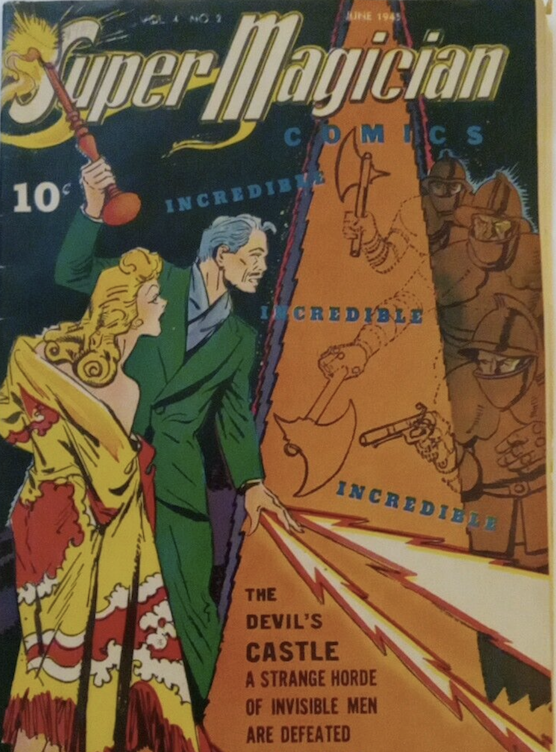
And now a word from our sponsor.
Mr. Cross: “Each week at this hour, Peter Lorre brings us the excitement of the great stories of the strange and unusual – of dark and compelling masterpieces culled from the four corners of world literature. ‘Mystery in the Air’…starring Peter Lorre, brought to you by Camel Cigarettes!”
MUSIC
“From the Bombay Black Mirror Room in the Hotel Fontenelle at 18th and Douglas Streets, we bring you the music of Ramón Raquello and his orchestra. With a touch of the Spanish, Ramón Raquello leads off with ‘La Cumparsita.'”
CURTAIN UP
(APPLAUSE)
Mr. Cross: “Experience is the Best Teacher! Try a Camel–let your own experience tell you why more people are smoking Camels than ever before! Yes…let your ‘T-Zone’ experience what it means to enjoy Camel’s choice, superbly blended tobaccos. You know, your ‘T-Zone’…that’s T for Taste and T for Throat…is your true proving ground for any cigarette. So try a Camel. Discover whether that rich, full Camel flavor doesn’t just hit the spot with your Taste… whether that cool Camel mildness doesn’t get along beautifully with your Throat. See if you too don’t say…’Camels suit my T-Zone to a T!'”

1947 radio show and 1947 Camel print advertisement.
The Hunt
3316 Center Street was built in 1913. The home is within the Field Club Historic District. Thankfully the City Planning Department Historic Preservation Department’s Field Club Neighborhood architectural records are as obsessive and meticulous as we are at the detective’s office. Shelley McCafferty, and Trina Westman before her, have been especially helpful with mapping and resources. Because of the city’s files, my initial work was made much easier. Of course, I double checked their facts, because I do get stalkish about things. I did find inconsistencies along the way but that only motivated my coffee intake and kept my eyes skinned. This article represents my most comprehensive analysis of historical data, field notes and personal anecdotes collected. Undoubtedly, I will persist in augmenting this investigation with further material as it becomes available from individuals, like you, who contribute more precise data and other unique personal experiences. If I haven’t stated it before, I am grateful for these accurate resources, your experiential knowledge and the contributions of prior journalists and scholars of the past. I express my gratitude to you.
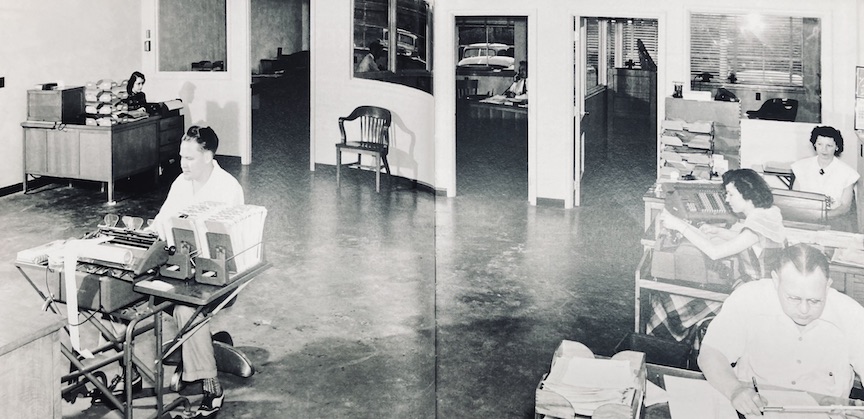
Here at the Cassette Detective Agency, we take great satisfaction in being Infamously Unknown. We have a strong desire to be anonymous for it allows us to do our best unidentified work.
Let us begin tonight’s stake out in full. May I suggest a flashlight, a nice drinkey, a summer coverlet or a snoring Newfoundland on your porch glider? Just as I have every time I come face to face with the big, beautiful girl that is 3316 Center Street, I beam, “Well now, let’s have a look at you!” She’s just a hop and a skip up from Hanscom Park.
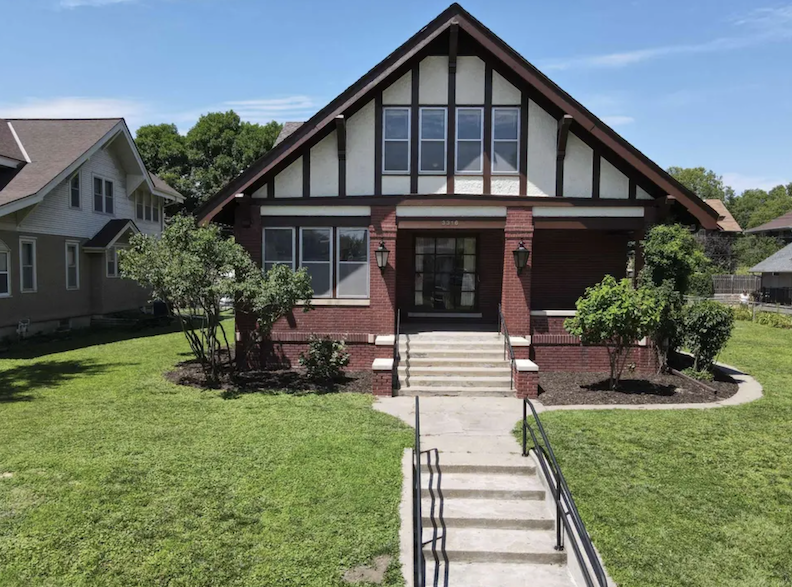
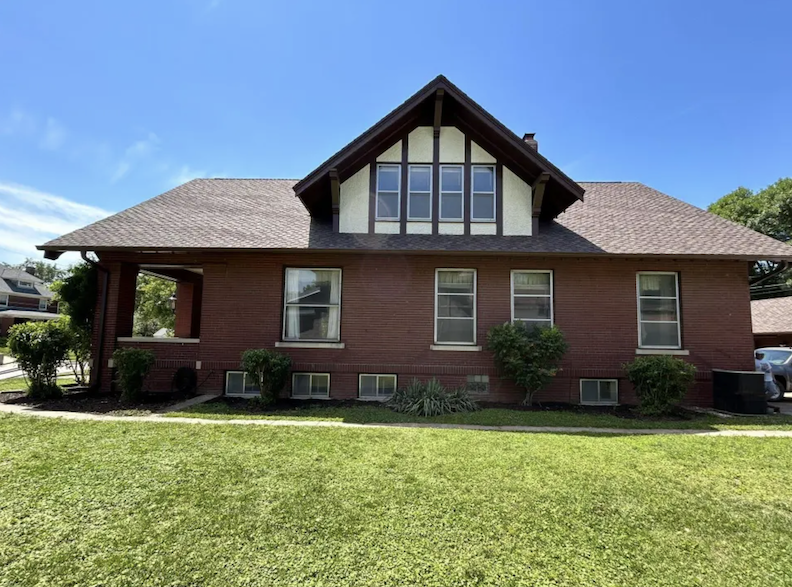
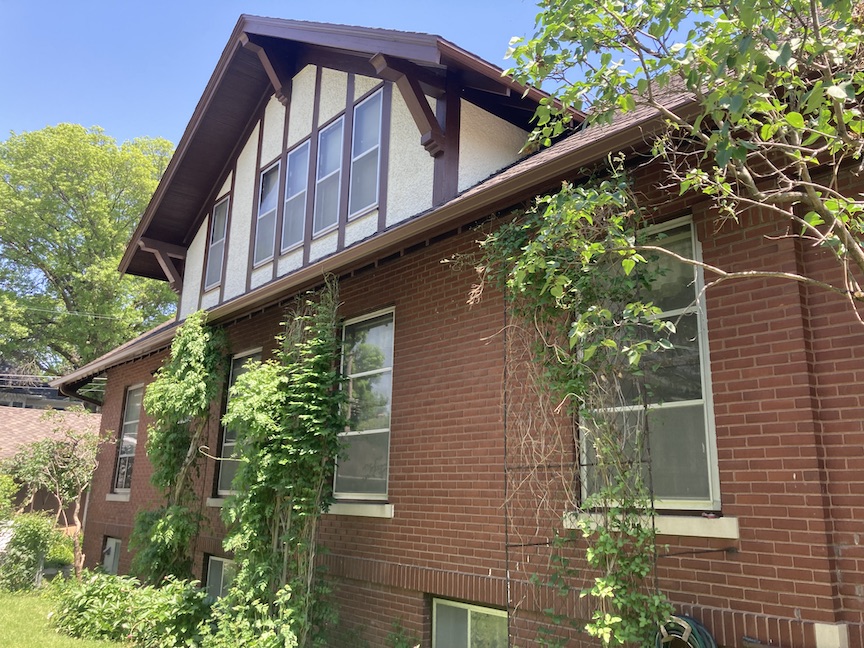
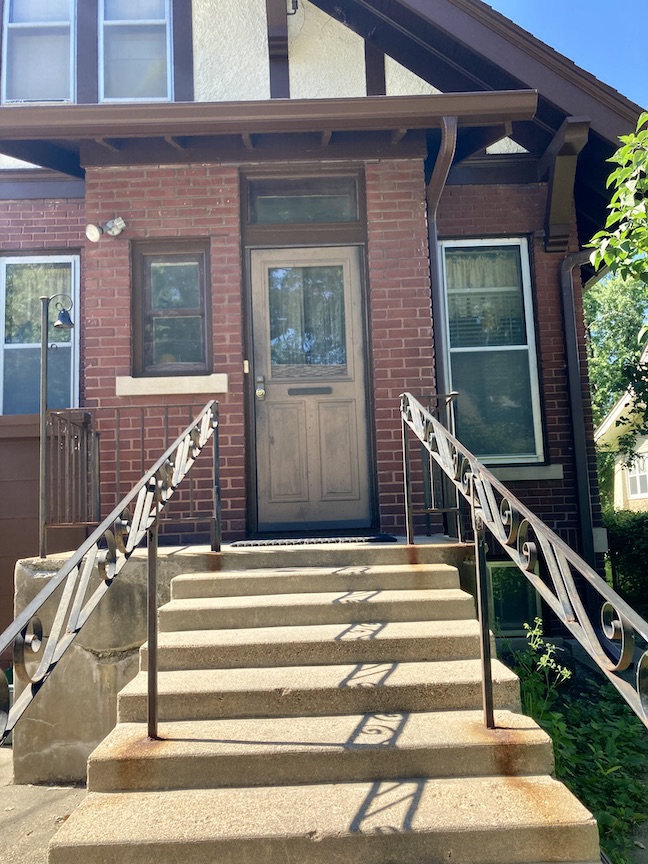
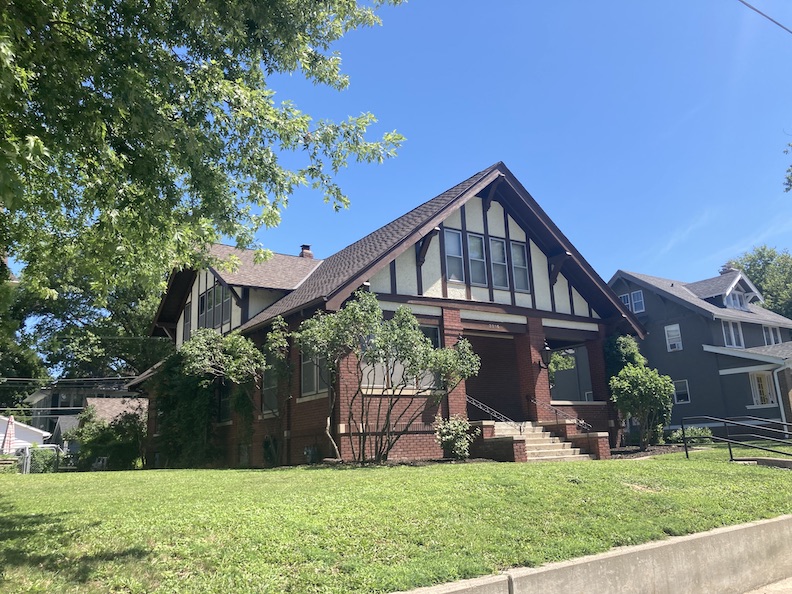
3316 Center Street. Lovingly maintained and doted over by the Carl and Lenora Schrat family since 1966.
The Neighborhood
Located about three miles south and west of Omaha’s central business area, the Field Club Historic District covers an area of about sixteen square blocks.”Roughly bounded by Pacific Street, 32nd Avenue, Center Street, and 36th Street, the neighborhood was placed on the National Register of Historic Places as a historic district on November 15, 2000.” I consulted the wonderful writing and research of Melissa Dirr Gengler and Jill Ebers Dolberg, then of the State Historic Preservation Office, in their National Register of Historic Places Registration Form (10/10/2000) for the Field Club Historic District. I understand that, although not mentioned in the report, Edward J. Quinn contributed substantially to the research. Melissa Dirr Gengler gave permission to cite their nomination. The Field Club neighborhood is made up of around 328 houses, most of which are single-family homes, inhabited by their owners. The well known Field Club road, serving as the formal entrance to the neighborhood, Woolworth Boulevard, is a glorious east to west promenade featuring beautiful gardens down the middle. Some of Omaha’s most striking houses are arranged on either side of the boulevard and their Field Club Fourth of July Parade route traces the charming ellipse— long a Cassette Household favorite holiday event. The Field Club Homeowners League tends the parklike setting. Honestly, any road you wander down will provide new enchantment.
Omaha Field Club, a private social club, was established in 1898, but it was not officially named as such until 1901.

Omaha: A Guide to the City and Environs, written and compiled in 1935-1939 by the Works Progress Administration reported Omaha Field Club leased 120 acres from the County Poor Farm. Furthermore, taken from the Omaha Evening Bee of 1879: “In 1859 Douglas County bought 160 acres, now known as the Poor Farm, and ten acres of timber land beside, of a man named Chapman, for $6,000.” A later article from the Bee discussed the burial of the deceased County Poor Farm tenants: “The remains will be buried in the pauper’s burial ground, on the county pauper farm, the only place in the neighborhood of this city where the body of a pauper can find a resting place.” It is interesting to consider where exactly this cemetery was located. Is it now part of the Field Club golf course or in a neighborhood? That is a for a later investigation and I cannot wait. In 1931, a significant number of “the aged poor” were sent to Clearview Home, which, according to the Omaha Bee-News was located “sixteen miles west of Omaha on Maple Street.” Father of Miss Cassette described Clearview Home as being surrounded by farms, “as far out west as Boystown and a straight shot north.”
The Field Club has consistently been located on the western boundary of its namesake neighborhood and Hanscom Park edges a portion of the eastern perimeter. I mention these adjacent grounds because I have always felt that these two large green spaces set the quiet, graceful tone of the Field Club neighborhood, almost like a clean air chamber. To walk the loop of the boulevard on a summer evening is to experience a gust of fresh, cool air. Have you noticed this phenomenon?
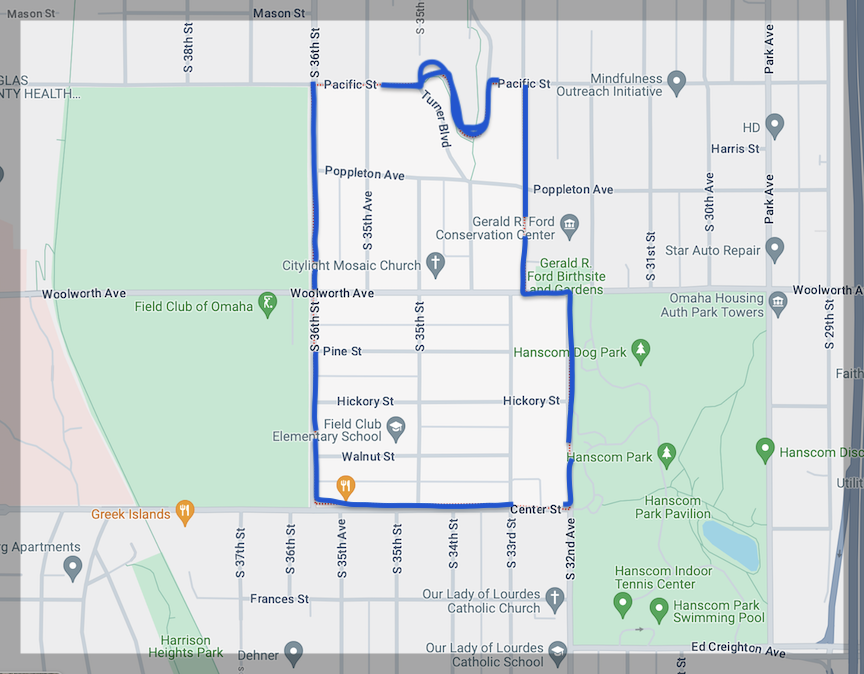
Google Map. I outlined the Field Club neighborhood in blue.
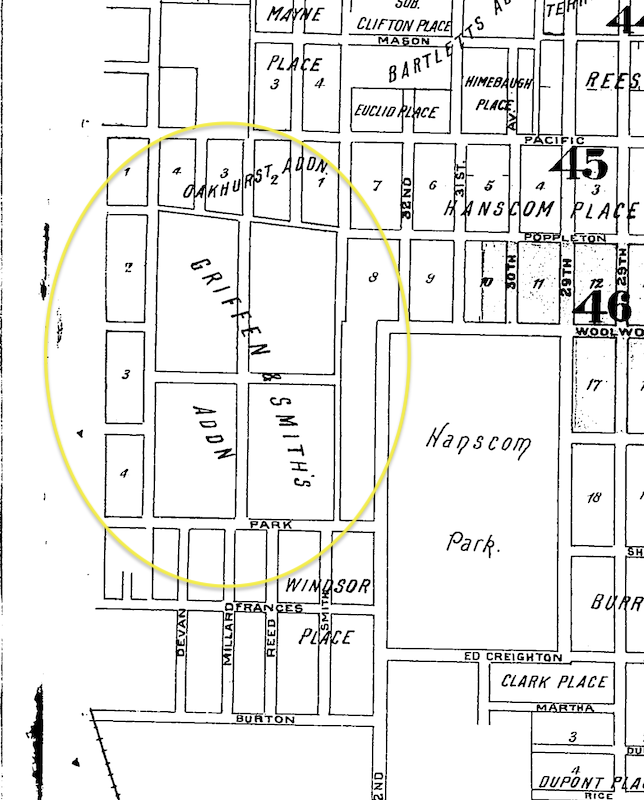
1890 Sanborn Map lent by Shelley McCafferty from the City Planning Department. Top of the image is north; bottom of the image is south. I apologize that the mapmakers didn’t include more of the burgeoning Field Club Neighborhood to the west; their draft just cuts off. If you orient yourself to Hanscom Park, which borders the eastern side of the Field Club neighborhood on 32nd Street, you can see that Center Street was not called Center Street back in 1890. It appears, at least on this map, as “Park.”
The following Field Club neighborhood information was gathered from the writing and research of Melissa Dirr Gengler and Jill Ebers Dolberg of the State Historic Preservation Office in their National Register of Historic Places Registration Form (10/10/2000) for the Field Club Historic District. Mr. Edward J. Quinn contributed to their research, as well. The historic district is categorized into three main epochs of building, each representing its distinct architectural and cultural phases. The establishment of the Field Club neighborhood in the 1880s began when prominent residents of Omaha saw that the construction of streetcar lines would allow them to move from the city center to the newly built residential areas, where they could embrace the Queen Anne and Victorian architectural styles that were fashionable at the time. A significant number of the early residences in the area were oriented around Hanscom Park. The neighborhood underwent a significant increase in construction during the period from roughly 1910 to the early 1920s. This was mostly due to the relocation of high-ranking executives from the livestock exchange industry in South Omaha, who were drawn to the area. Following the Second World War, there was a surge in demand for housing, particularly for the last available parcels in the Field Club when the neighborhood was fully developed. I did find some wonderful homes actually built during the war that I adore, described later. These different phases of growth highlight periods of architectural and construction styles throughout the area, with many of the newer houses showcasing simple, traditional designs and various interpretations of the classic American Foursquare style.
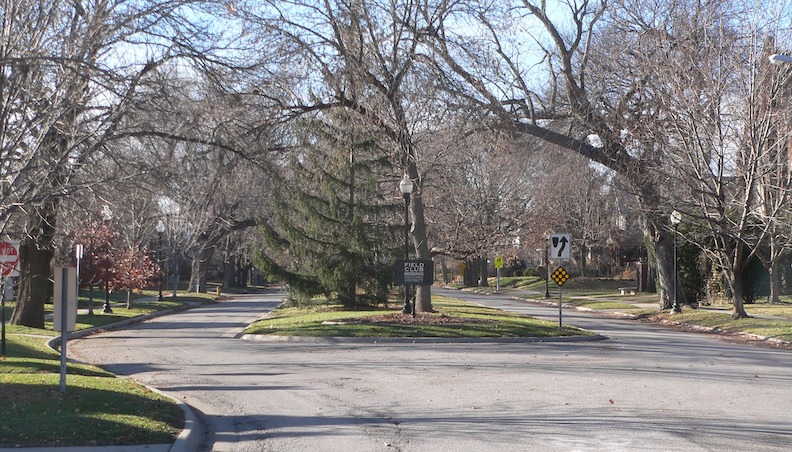
Woolworth Avenue. Camera is facing westward from about Turner Boulevard. The area shown is part of the Field Club Historic District, listed in the National Register of Historic Places. 2015. Photograph borrowed from Ammodramus. Obviously this image was taken at a colder time of year. Detectives, you must see how it looks this time of year–so lush and green with all of the rain we’ve had.
If we magnify, 3316 Center Street was specifically built in the Fieldcrest Addition with assigned situs address: Lot 18, Block 2, Lot 17 & W ½ 75X 133.81. The Fieldcrest Addition, sometimes spelled Field Crest, is a development within the larger Field Club neighborhood. Of interest, the 3316 Center parcel includes both Lot 18 and the western portion of Lot 17, to be discussed later.
Love the area and want to get lost? Check out these older investigations:
Mysteries of Omaha: 3214 Center Street
Mysteries of Omaha: The Witch of Hanscom Park
Closer to 1916 South 32nd Avenue
The Addition
Back in 1901, the Sanborn Map (shown below) displayed the area before the Fieldcrest subdivision was planned. It revealed that this area was initially being developed as Griffen and Smith’s Addition. (At times it was spelled Griffin & Smith). This Griffen and Smith’s subdivision is also depicted in the above 1890 Sanborn Map. In 1901, 3406 Center Street (then called 3406 Lincoln Avenue) was the only house on the block between 33rd and 35th Streets. This 3406 Center Street property (red arrow) is no longer standing and curiously, this address is obsolete. Griffen and Smith’s Addition does exist and is located a few blocks to the north within Field Club. Griffen and Smith’s Addition was platted in 1869. I discovered a bizarre collection of Douglas County records that had been uploaded ((thank the now departed maiden librarian goddesses and all fastidious county employees since passed)) from 72 boxes, 1,780 reels of microfilm, 224 volumes in total. Through this mountain I bored to find Fieldcrest Subdivision was platted much later in 1912, comprised of the previous Blocks 9 and 12 of Griffen & Smith’s Addition.
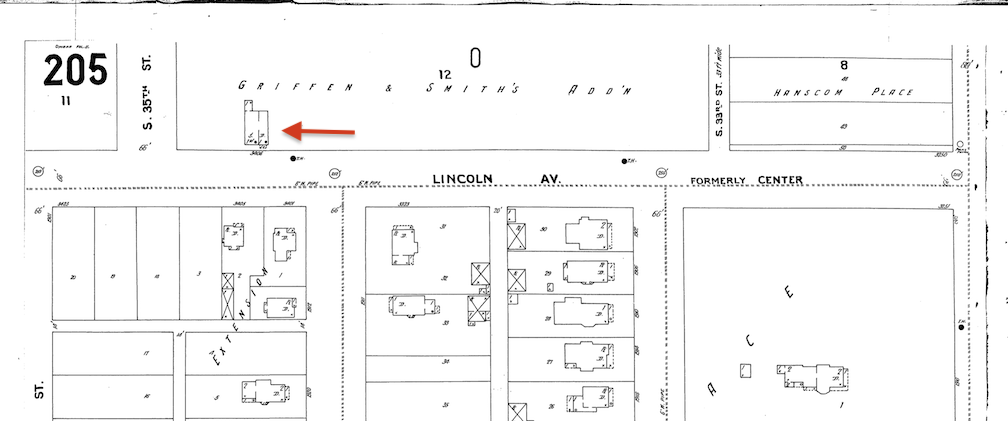
1901 Sanborn Map lent by Shelley McCafferty from the City Planning Department. Top of map is north, bottom is south. Hanscom Park is to the right (east) just out of range of the drawing. Image depicts Center Street, between 33rd Street and 35th Street.
Norris & Norris were the realtor-developers behind Fieldcrest Addition (evidently used accidentally or interchangeably with Field Crest). By 1910 I noticed W. C. Norris, or William C. Norris, of Norris & Martin Real Estate, had started buying up lots and building houses in town. His “Norwood” house, a gorgeous three-acre estate in Florence was a modern shingle with a large screened-in veranda. It appeared as a new level of notoriety. With the publicity surrounding Norris’ “Norwood” residence, I was not surprised to discover amendments of incorporation for the Norris & Martin company. The name changed to Norris & Norris, capital stock increased to $50,000 in August of 1912. The Daily Record showed court report that William C. Norris was president and Edward B. Norris was secretary of the new firm, housed at the 400 Bee Building in downtown Omaha.
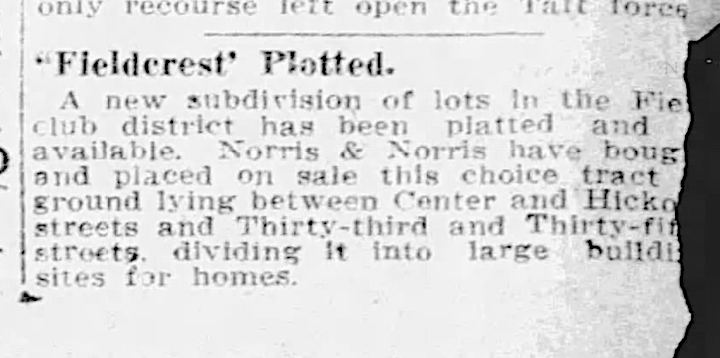
September 26, 1912. Evening World-Herald announced the platting of Fieldcrest addition.
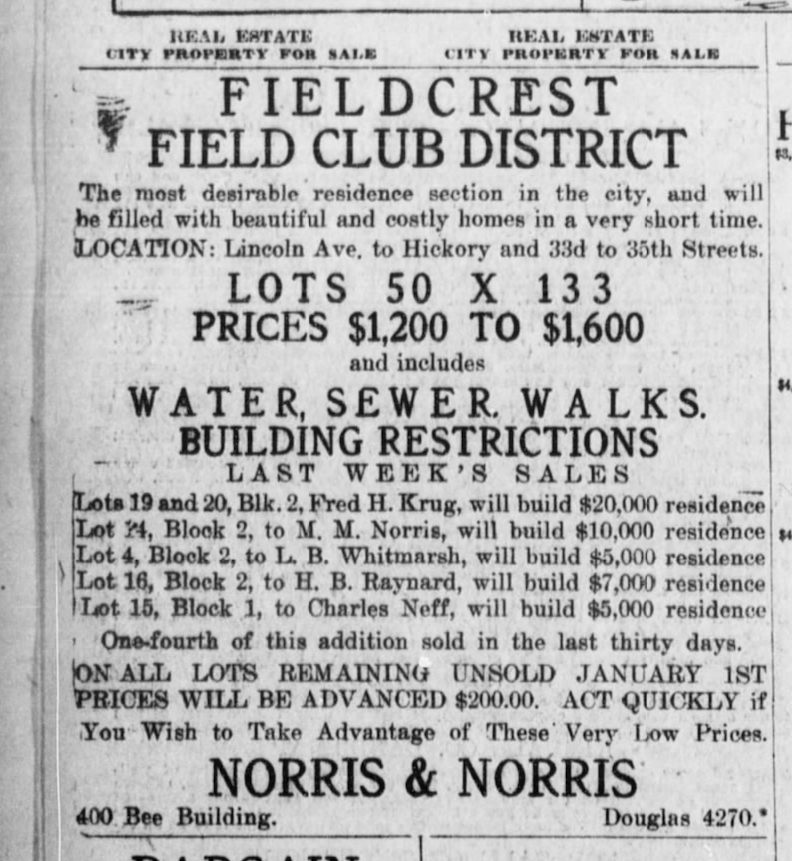
1912. Omaha Daily Bee. Fieldcrest perimeters: Lincoln Avenue (Center Street) to Hickory, 33rd Street to 35th Streets. “The most desirable residence section in the city and will be filled with beautiful and costly homes in a very short time.” Note the Omaha famous, Fred H. Krug house built for a pretty penny on two lots.
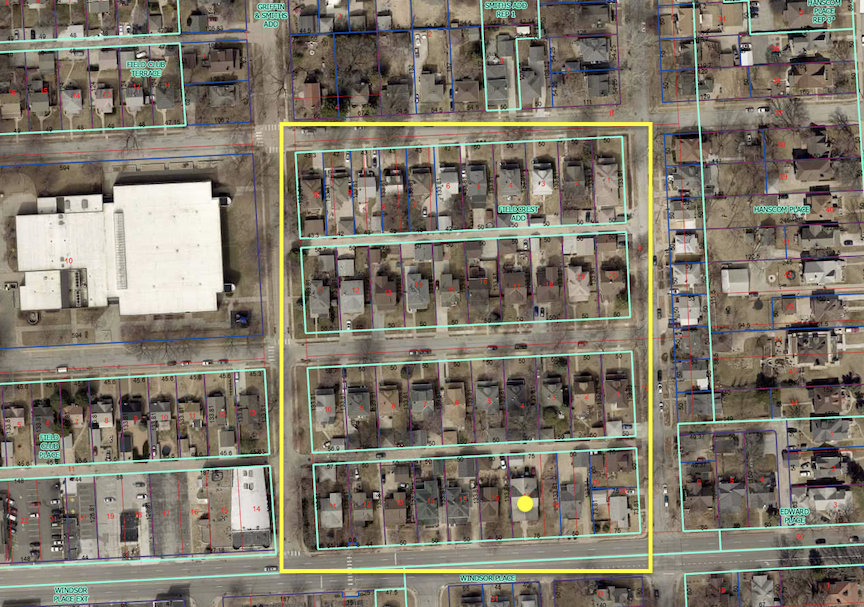
Current map of Norris & Norris’ Fieldcrest Addition. Aerial image borrowed from the Douglas County Assessor site. I outlined the plat in yellow. A yellow dot is on the 3316 Center Street house. Top of the photo is North. Bottom of the photo is South. Center Street angles slightly along the bottom of image.
Friends, we are getting awfully close to the time period that David P. and Fannie Abbott built their 3316 Center Street Craftsman. Let’s introduce the original owners, so we can come to understand the hows, the whys and the significance of the timeline leading to 3316 Center’s construction date (her birthdate) in the Field Club neighborhood. If you are here for architecture alone, we will not be offended if you skip ahead to the header The Fieldcrest Lots.
We will commence with Mr. Abbott…
Early Life of David P. Abbott
Although almost all members of David P. Abbott’s family are buried in Omaha’s Westlawn-Hillcrest Memorial Park, the Abbotts were not an Omaha family. Patriarch was Father George A. Abbott, born in Indiana in 1838; his family later moved to Andrew County in Missouri. Mother Sarah Frances Daily, called “Fannie” and “Fancy” throughout her life, was also born in Indiana. She was daughter of Judge Samuel Gates Daily. George and Fannie married in 1860 (some accounts say 1861) near Savannah, Missouri. The Abbott couple then moved to their homestead, an unpopulated area, on a farm east of Falls City, Nebraska, in about 1862.

In their older years, on the occasion of their Golden Wedding Anniversary. Mr. and Mrs. G. A. Abbott. December 25, 1910. Omaha World-Herald.
G. A. Abbott became one of Richardson County’s best-known pioneers, regarded as both a Populist and Democratic politician, a “vigorous writer” of both prose and verse, and a “very public spirited man,” “very radical in his expressions of opinions.”
Nine children were born to the Abbotts on their remote farm, seven lived to adulthood. I have included the daughters’ married names.
David Phelps Abbott
Ada Lee Abbott Humphrey
George Francis Abbott
Julian “June” Asahel Abbott
Mabel Abbott Robbins
Daisy L. Abbott Stanton
Alice Abbott Roe
Early Performance
David Phelps Abbott, our magician of focus, was the oldest child from this outspoken politician and the judge’s daughter union. Born in 1863, is it any wonder that David inherited a curious, hungry mind, scrutinizing, watchful eyes, confidence, and was able to think and speak on his feet? “Davey,” as he was called as a tot, was capable, ready. At the age of 8, David and his beloved sister, Ada, then 6, were taken by their father to see a magician in Falls City. David had keenly watched from the audience and figured out the mystery traveler’s tricks. The sibling duo then supposedly reenacted the tricks at home to their amazed father, who spread word to the neighbors far and wide. This was young David’s initiation to magic, showmanship and perhaps, power. David attended school in Falls City where it was rumored within nine months had studied and mastered elementary and higher algebra, plane and solid geometry. He also excelled in science. David’s talents expanded to music, and he learned piano, oboe, guitar and clarinet, later teaching music in Falls City after high school graduation.

The dedication inside Behind the Scenes with Mediums, one of David P. Abbott’s books, gives his favorite, little sister, Ada, a nod, as he would continue to do throughout his life. Ada was David’s first magician’s assistant and much adored.
I traced David Phelps Abbott’s “spirit medium” performance inception to about 1884 (“Dave” would have been in his early 20s), this formulation after performing simple tricks for family and friends throughout childhood. It is thought that he took an unadorned show on the road, playing in small towns until he had gained a working knowledge of magic and an appreciation of that art. I found him passing through his parents’ hometown in Missouri in a vaudeville show. It is interesting to mull over if Abbott possibly considered becoming a professional magician at this point in time. One can assume he did make a little pocket change on these early ventures. I used the word formulation in Abbott’s magical study because the more I read, I learned he was developing and preparing for something far greater than a chance on a variety show stage.

Portrait of a younger David. Image by Big Urn.
Nuptials
David Abbott met and married Fannie E. Miller in Beatrice, Nebraska in 1887, where her family was from. Miss Fannie was born in 1868 to Uriah W. Miller and Hannah Meyers Miller.
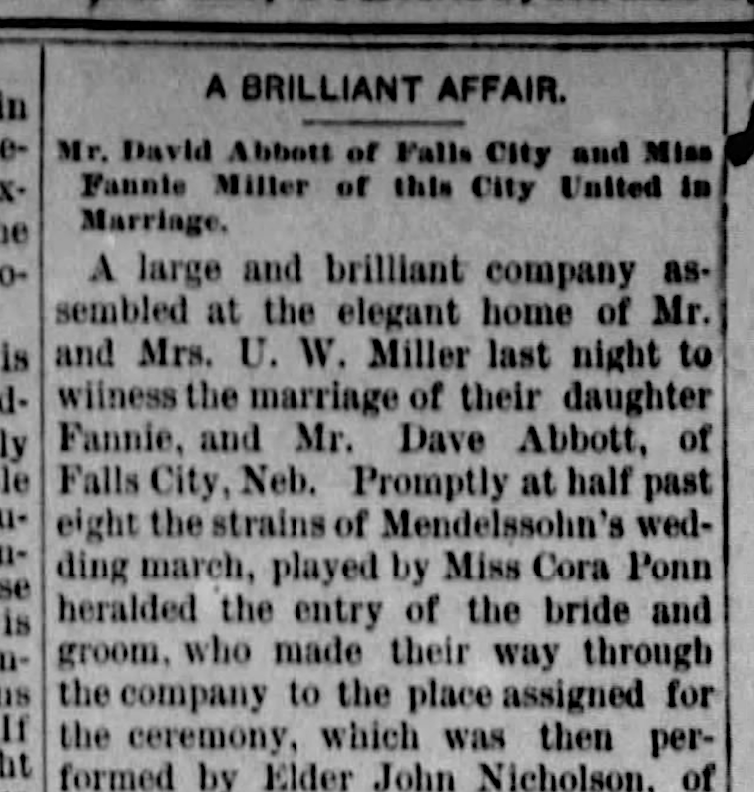
From The Beatrice Daily Express. Beatrice, Nebraska Tuesday, April 05, 1887. One hundred guests were present and there “was a large list of gifts.”
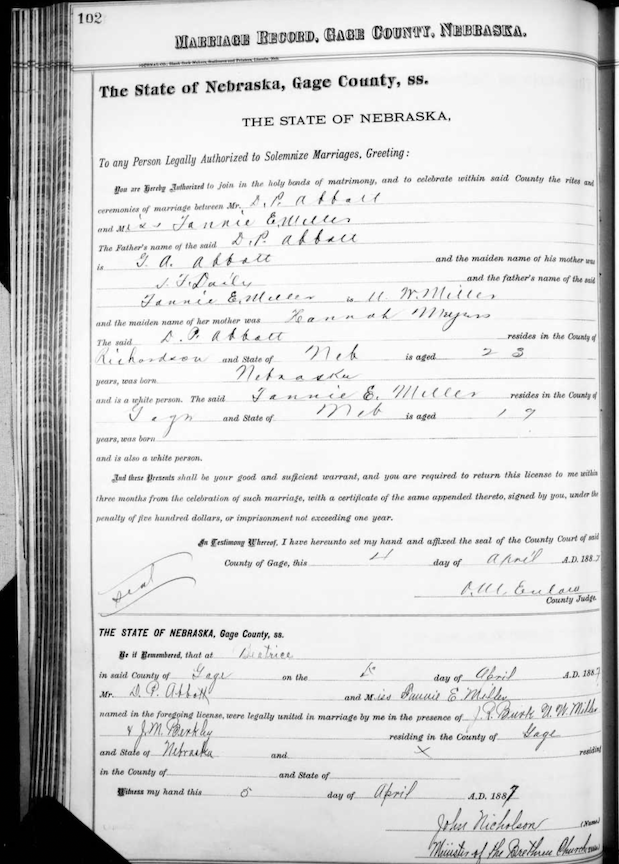
Gage County, Nebraska wedding certificate. David was 23 years of age and Fannie was 19 when they married on April 4, 1887.
The Problems of the Abbott Boys
In time the couple moved to Lincoln, Nebraska. My first indication of David Abbott’s professional career came when I discovered the Abbott Brothers Loan Company incorporated with a capital stock of $25,000 back in 1893 in Lincoln, Nebraska. George F., Julian A. and David P. Abbott filed articles and from then until his death, David Abbott made his money as a loan agent.
The Abbott Brothers were in court off and on, sometimes of a scandalous nature–perhaps a fastening due to the moneylender operation. When the 1894 case against Mrs. Ella Hutchins of 1935 Q Street in Lincoln rose to charges of prostitution, it was hard to make out the truth. Were the Abbotts involved because of their chattel loan business or for personal connection? “It is stated that the Abbott boys are incensed against the woman because she sometimes since threatened to injure the character of one of them.” David would swear to Mrs. Hutchins keeping a “house of proposition,” which caused her arrest and arrival in court. Hutchins’ counter storyline would infer George Abbott of “attempted rape.” It was speculated in the papers that both Ella Hutchins’ claim against George Abbott attempting rape and David Abbott’s claim against Mrs. Hutchins being a prostitute were very possibly true. Both parties agreed to cessation of their charges, probably because all names involved had been sullied. It was a very public display and challenging to read, by today’s standards.
A revealing story highlighting the Abbott skill and boldness involved brothers David and George again, both members of the Nebraska State Band. The two filed a lawsuit in 1894 against Mr. A. O. Zeimer, their band director, for not paying them their salaries for a series of Sunday Night Sacred Concerts given in that same year. The band association’s defense was that the earnings were to be divided among the players and that there were no actual earnings to divide. The band’s further argument was that David Abbott was indebted to them for $19 worth of tickets sold and not accounted for in the treasury. Ewwww. With headlines like “The Abbotts Again- Are Placed in a Bad Light by the Old State Band” had me wondering the truth of the matter. The suit went on until 1896. And from the York paper: “The Abbott boys, well known among sporting circles in York, are in trouble again…” The previous articles having mentioned prostitutuion made me question the York paper’s use of the phrase “sporting circles.” Daring? Slyness?
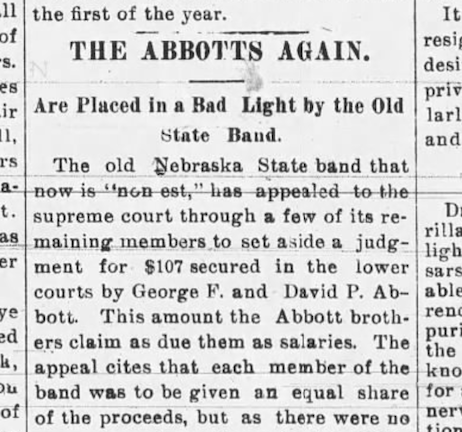
1896. Lincoln Evening Call.
Technical Shows
In 1896, David Abbott was also providing “stereopticon entertainment” at no cost to the audience. One such show was at the Y. M. C. A. In essence, stereopticons were slide projectors—interestingly dubbed “magic lanterns”—that fused two images to produce a three-dimensional impression that caused one image to blend into another. Stereopticons were a common way to learn and entertain before the invention of motion films. It is interesting to think of a younger David enjoying being in front of an audience as well as new technology.
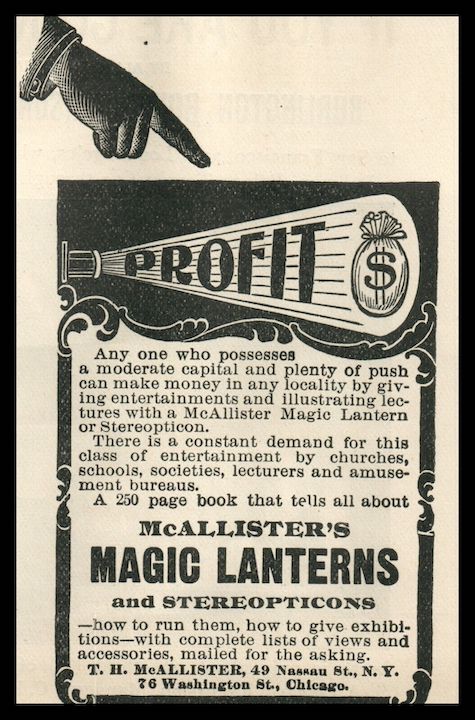
The McAllister Magic Lantern Stereopticon Photograph Projector. 1896.
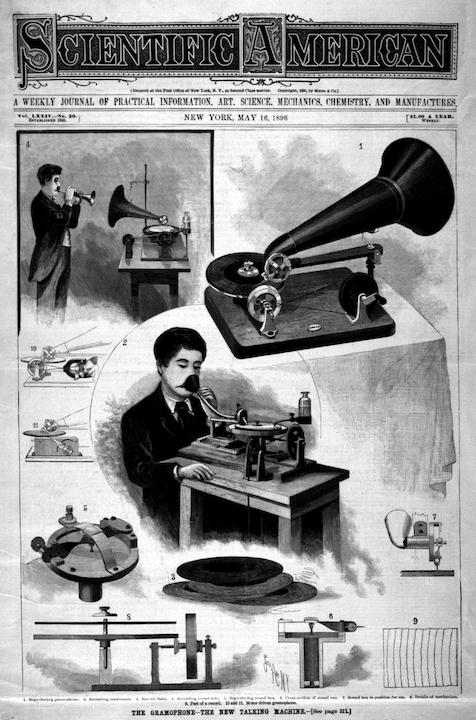
Before moving to Omaha, David and Fannie were giving shows featuring “phonograph and stereopticon entertainment” to audiences. I read about performances at church, fraternal organizations and concert halls. Abbott was said to “have expended nearly two thousand dollars in apparatus and paraphernalia and he can give an exhibition of such a varied nature that he can satisfy any audience.” Lest you think Magician Abbott was merely an early d.j., he had used some newfound attachment to create a different sound in performance. Something about a double-bell. “About twenty-five invited guests were present to hear the concert given by Mr. Abbott’s double-bell perfecting phonograph, and to say that it was a musical treat is but mildly putting it (…) on account of the double bell attachment the sound produced is about fourteen times stronger than that of an ordinary phonograph. (…) As Mr. Abbott and wife are en route for the west to give a series of entertainments it is quite likely that they may return and give a performance at the Paddock opera house in the near future.” Abbott’s phonograph with double-bell attachment was said to be “the largest of its kind in the world,” whatever that kind actually was. I had to eventually abort mission as we do have so many things to attend to in this investigation.
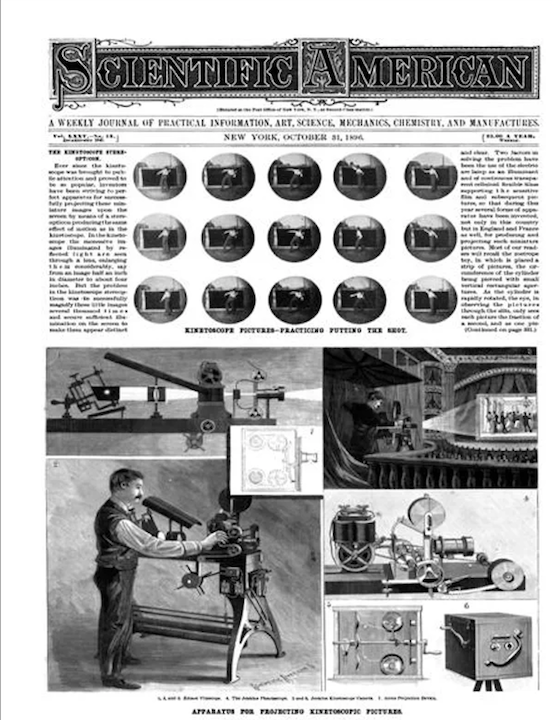
Scientific American Magazine. October 1896. Volume 75, Issue 18. Featuring the stereopticon that David P. Abbott was featuring in his early shows.
Two things that I was not expecting in my research phase of David Abbott shed light on his vast interests. He had saved and acquired much real estate early in life. He was quite planful and goal oriented. When gold was discovered throughout Falls City in 1897, David Abbott, then living in Lincoln, returned to town “to look after his property interests,” no doubt, panning for gold on his lots. In 1897 Abbott “achieved fame by the invention of a powerful bicycle lamp that burns acetylene gas.” I have not looked further into the latter claim, but I am inclined to believe it after all the other Abbott master strokes.
It was in this time period that the newspapers began referring to David P. Abbott as a professor, i.e., Professor David Abbott.
Great Expectations
Some reports log the Abbott Brothers in the loan business down in Lincoln for about ten years; then there is a cold trail leading to Kansas City, followed shortly by arrival to Omaha. I did eventually find David and Fannie packing up for a move to Kansas City at the end of December of 1897, but by 1899 the Abbotts had returned to Falls City, Nebraska. This exact timing doesn’t exactly track as the Omaha Daily Bee announced in January of 1901 that articles of incorporation for the People’s Loan Company (in Omaha) were filed. The incorporators were listed as J. R. Clawson, David P. Abbott and M. Robbins with capital stock of $5,000. (Was M. Robbins sister Mabel Abbott Robbins’ husband?) The incongruency could be explained by incorporation of their business in Omaha, while all or one living in Lincoln, or Kansas City for that matter.
I believe the People’s Loan business was on the Bushman block of downtown Omaha, because not long after, David Abbott ran an ad selling his half of a bowling alley business with contact info on the Bushman block. (I do enjoy thinking of him in the bowling alley biz.) Not much longer and brother George F. Abbott joined the People’s Loan Company fold–the firm changing downtown locations over the years. The Abbotts were in the business of lending money and for this reason, in some circles, David P. Abbott was known as a “real estate man.” I did find David and Fannie making some property investments.
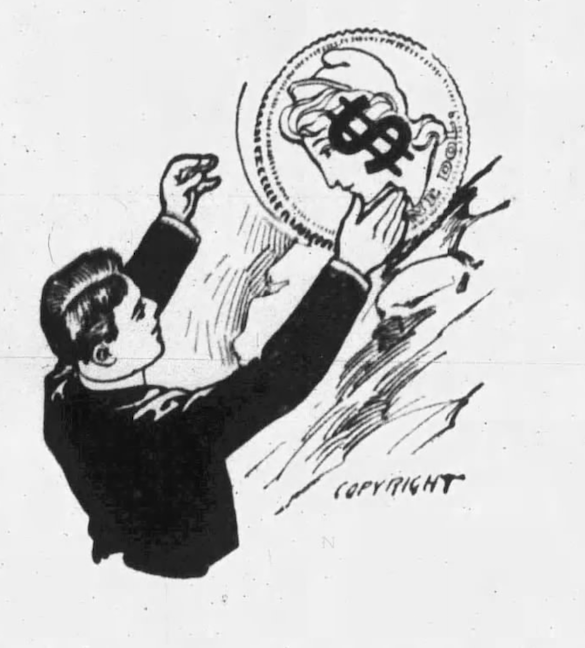
Early 1900s illustration for an Omaha savings and loan. Not of David P. Abbott, but it felt magical.
The Abbott’s First Home
New to Omaha, David and Fannie Abbott made an excellent choice in their decision to live at 2568 St. Mary’s Avenue, a residence no longer standing. Close to David’s work downtown and situated in a stylish part of town, this was a good location to operate from. It took a while to piece this one together. 2568 St. Mary’s Avenue was an eight room, well-furnished house, with alcoves, bay windows, hideaways and a large parlor—home to Omaha Famous druggist, Dr. N. A. Kuhn, son of the Old Omaha Famous Dr. J. N. Kuhn. This was the kind of family and the kind of large home that was always advertising for servant girls and other domestic help. I believe the Kuhns rented the house to the Abbotts for a short while, something that the well-heeled frequently did in those days. Be it travel abroad, visiting a sick auntie in another state or house hopping before a serious move, we have seen all of the well to do moves from our various stake outs. Then they were selling the house, potentially while the Abbotts were still renters. After the Abbotts moved around the corner, it appeared the Kuhns didn’t return to the house.
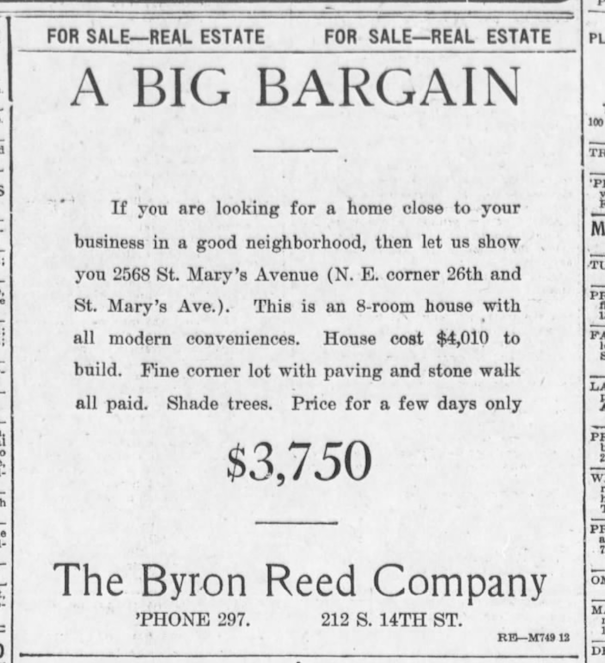
1905 Omaha Daily Bee.
2568 St. Mary’s Avenue, within walking distance of the Leavenworth streetcar, fully furnished and boasting of furnace heat, was easily transitioned to a boarding house by the later teens and 1920s. It continued to be advertised under the “rooms for rent” category into the 1940s. Of interest by the 1960s, 2566 St. Mary’s Avenue had become the Omaha Builder’s Exchange location and later was torn down.
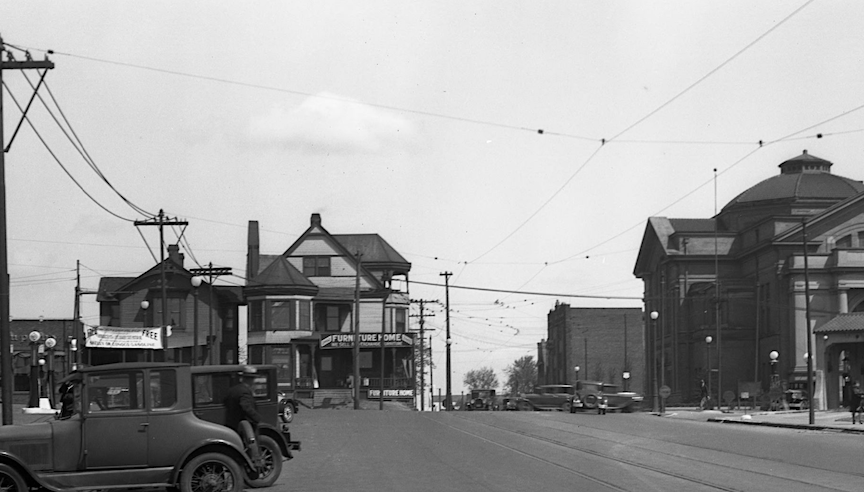
Photographer is at Jones Street facing north on 24th Street to St. Mary’s Avenue. Bostwick, Louis (1868-1943) and Frohardt, Homer (1885-1972). The Durham Museum. 1930. This is not precisely 2568 St. Mary’s Avenue. I only share this to illustrate the very large homes from this area, in this time period, that later became rooming houses. Sadly, many were run down and in subsequent years, most all were torn down. Opposite the behemoth house turned rooming house, on the northeast corner of 24th and St. Mary’s Avenue is the once glorious First Church of Christ Scientist (565 South 24th Street). It is still standing.
Want to get enveloped in this once posh part of town? Check out my previous investigations:
Mysteries of Omaha: 2226 Howard Street
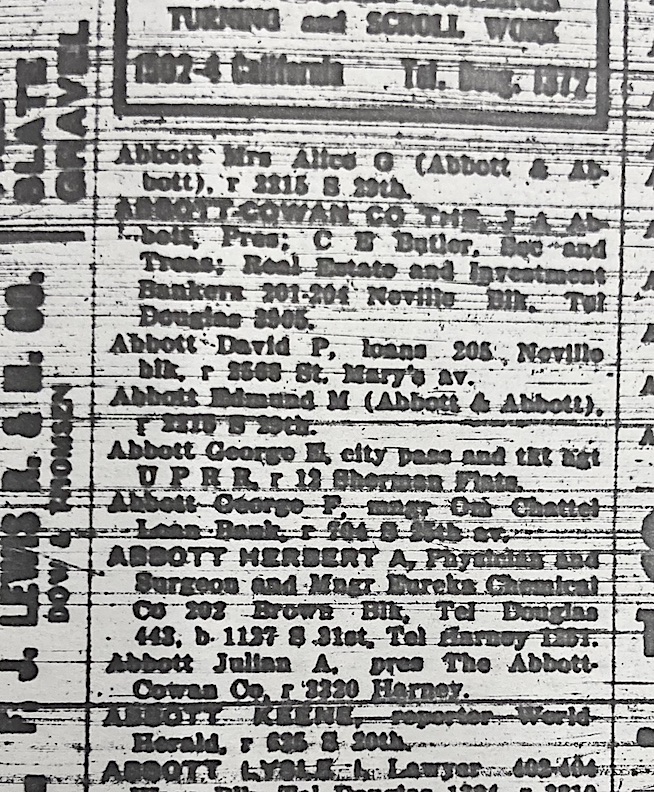
1906 City Directory: Abbott, David P. loans. 205 Neville blk, r 2568 St. Mary’s Avenue. Of interest–David P. Abbott is in the loans business, apparently under his own name out of the 205 Neville Block suite. Brother George F. Abbott (further down the page) is manager of the Omaha Chattel Loan Bank. Brother Julian A. Abbott is president of The Abbott Cowan Company, real estate and investment bankers, located at 201-204 Neville Block—with offices right next door to brother David.
Invention and Investigation
It was during the Abbott couple’s 2568 St. Mary’s Avenue years that David embarked on a deeper exploration. He entered the world of magic innovation and started researching, writing, and creating unique magical items and equipment for himself and prior masters. He started penning “scientific” pieces for The Open Court. The Open Court, a Chicago and London periodical, published one in 1905 titled Some Mediumistic Phenomena, in which Abbott revealed the devious techniques of a “materializing medium who fooled many Omaha people some years ago and carried away several thousand dollars in profits.” Abbott gained much respect for both his findings and the “care taken in the preparation of the article” because of his meticulously thought-out and illustrated explanation of this “spiritualistic trick.” Dr. Paul Carus, who published a significant number of Abbott’s essays and writings in his magazine, The Open Court, would continue to be a friend of Abbott’s through their lives.
After that encounter, Abbott was considered as “one of the best thinkers in the country along scientific lines.” But it was the time and money he invested in looking into the spiritualistic tricks of traveling mediums and clairvoyants, as well as his continued fixation with “exposing harmful frauds,” that also sparked a national fascination. Abbott gained additional favor because he was able to demonstrate these techniques skillfully and artistically to members of the general public as well as other shrewd, like-minded investigators. “He has ever permitted an auditor to go away with the idea that anything he has done is mysterious or supernatural.”
The first time I came across any reference of David P. Abbott’s interest in disproving mediums was in an article published in the World-Herald in July 1905. Upon arriving in Omaha to deliver several presentations, Professor James H. Hyslop “went immediately to the home of David P. Abbott, with whom he had conducted many interesting experiments along the lines of psychical research.” It was stated that Professor Hyslop’s “word was law” in the “American branch of the Society of Psychical Research.” Thereafter David Abbott quickly gained notoriety as a “spooks expert.” When publicly invited by Madame Palladino’s manager to visit the Italian spiritualistic medium’s séance in another part of the country, Mr. Abbott stated the Madame “has unusual powers of the supernormal, not supernatural nature. But I have investigated hundreds of so-called mediums, and everyone was a rank faker.” When pressed further, possibly as a publicity stunt, Abbott announced, “I will not visit the woman unless given a private séance under my own conditions, admitting of absolute and complete investigation of each manifestation, as I would be forced to explain or endorse her mysterious power.” The Madame and her manager would not allow for the private seance. From then on it was clear David P. Abbott had thrown down the gauntlet. “David P. Abbott is always to be found in the theater when a magician or a minder reader is booked. Many of Mr. Abbott’s leisure hours are spent in peering into these regions that are not explained by natural law.” For as keen and scathingly sharp Abbott’s unveilings could be, oddly various touring mediums’ challenges kept coming. I figured as P.T. Barnum once said, “There’s no such thing as bad publicity.”
David Abbott penned his book “Behind the Scenes with the Mediums” in 1907. The Open Court periodical that had printed his articles, published this book. It attracted criticism from some in the magic community for exposing crooked magical art techniques, but it gained popularity for its usefulness in stage magic instruction. Particularly focused on exposing the spirit medium, Abbott illuminated the art of sealed letter reading, materializing objects, among other medium scams.
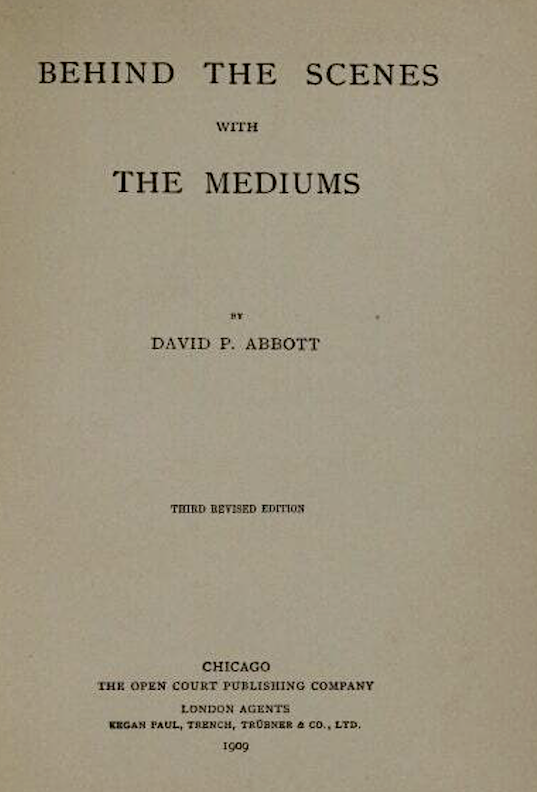
The third edition came out in 1909.
David P. Abbott’s writing is captivating and direct. If you would like a peek or if you’d like to read on, it will only help you see the man better. I’ve included this link to the Behind the Scenes with the Mediums online version through the Library of Congress. Another article followed quickly–Spirit Slate-Writing and Billet Tests (1907) was published in the Journal of the American Society for Psychical Research.
In these productive years, David had invented and demonstrated his Talking Teakettle around 1907. House of Mystery: the Magic Science of David P. Abbott edited by Teller/Karr give the specifics of these feats and I couldn’t hope to explain or interpret the gifts in this two volume set.
The way I conceived of it, David enjoyed the best of all worlds. He was involved in “scientific investigation,” probing spiritual mediums and magicians–particularly those claiming spiritism as the source of their skill. He was a public debunker. He was the good guy, pulling the rug out from under the hoaxters. This at a time when many good folks were gullible and easily outwitted. “He exposed use of hooks on the belts or cuffs of mediums. Small finger ring hooks and rubber suction pads used for lifting lighter objects.” His exposes were a public service but David was also highly imaginative and a masterful illusionist, by all accounts. His polished inventions played on perception and were as good, if not better than The Best in magic. The trick was he wasn’t fooling anyone that he was openly fooling them and he was so darn good at it. I believe David P. Abbott’s decision to not charge admission for his magic shows or for his public exposes might have been two-fold. There was no way around the ethical dilemma of exposing greedy frauds, if David, himself was going to make money from magic. Likewise forever remaining an amateur, with highly honed skills allowed him more freedom to only create cognitive experiments to his particular whims. These bragging rights (I did not find proof of him bragging, by the way) are what drew the famous magicians of the world as well as international celebrities into David’s charismatic circle.
Another perceived connection I made, and potentially I am way off with this one, it seemed that David was investigating and collecting experiences. Phenomenology was written about at the end of the 18th Century but really was explored in Edmund Husserl’s writings, which were coming out during the time that Abbott began his examinations. Phenomenology is a branch of philosophy that examines the nature of objectivity and reality, focusing on how they are subjectively perceived and experienced. The objective is to examine the inherent characteristics of consciousness without making any presumptions about the external reality. The goal is to depict phenomena as they are perceived by the individual and to delve into the interpretation and importance of personal experiences. Whether Abbott was formally studying phenomenology or not, he most certainly was a student of and sought to determine “the essential properties and structures of experience.”
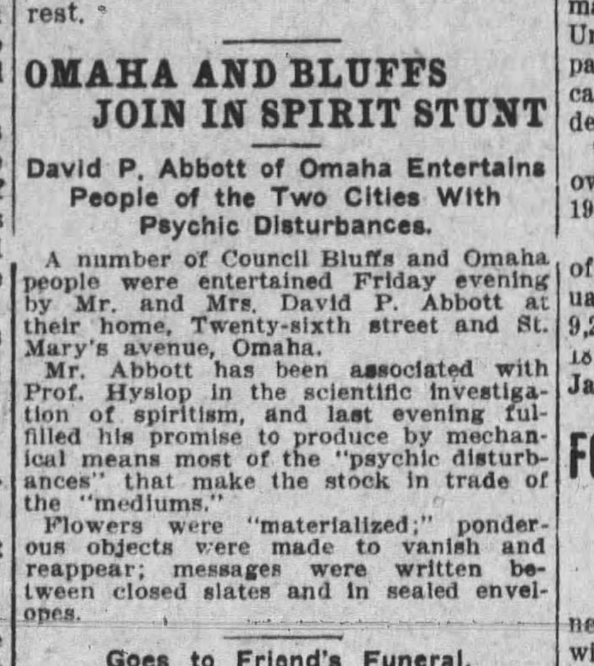
March of 1909. Omaha Daily News.
Another Move
In 1908 David published The Marvelous Creations of Joseffy, a 24-page “promotional” book about one of his favorite magicians and inventors, “Joseffy,” Josef P. Freud. Joseffy was an Austrian living in Chicago. Aside from all things magic, Abbott and Joseffy also shared a love of music, as Joseffy was a violinist and pianist. Mr. Abbott also included the renowned “Balsamo, the Talking Skull,” along with various other peculiar effects in the pamphlet. They enjoyed a friendship until death.
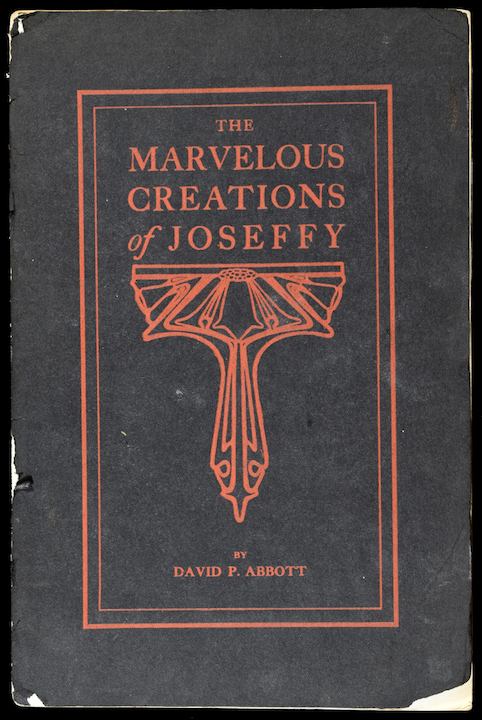

I secretly call him Pretty Eyes Joseffy. The marvelous creation was his bone structure.
In 1908’s The History of a Strange Case: A Study in Occultism, a slim 50-page book was published by The Open Court printing house. Mr. Abbott was only ever perplexed by a spiritual medium once. The Omahan wrote The Strange Case as an inquiry into the medium, Elizabeth Blake of Huntington, West Virginia. He suspicioned Mrs. Blake “spoke through her throat,” but he was unable to find out from where she got the information from her seances. I quite enjoy that Mr. Abbott left room for permittance: “I do not pretend to have occult dealings with the infinities and am willing to state that the mysteries I preform are largely skill and art but at times the psychic quality goes beyond me and I touch upon phenomenon that baffles me.” Unless he found the source of Mrs. Blake’s “information” at a later date, her abilities may have been filed in his special reserve of phenomenon.
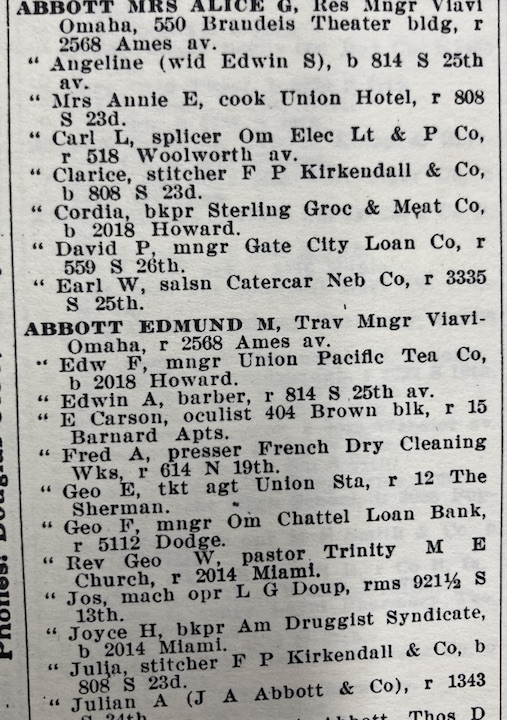
Omaha City Directory. The Abbotts lived at 559 South 26th Street until 1913. While at their second home, David Abbott was manager of Gate City Loan Company. Brother George F. was manager of the Omaha Chattel Loan Bank and Brother Julian A. was running the J. A. Abbott & Company, also a loan company.
By 1909 David and Fannie were performing in their home at 26th and St. Mary’s Avenue. I tracked down the address to 559 South 26th Street. 559 South 26th Street, similar to the Kuhn residence on St. Mary’s Avenue, was a large nine room house that would later be relegated to rooming house status. Previous to the early 1970s, I counted at least 12 large houses from the historic aerial photos on the South 26th Street block, just north of St. Mary’s Avenue that are now no longer. This whole area slowly transitioned the once posh behemoth mansions and large home into apartments and rental rooms preceding tear down for Lutheran Home apartments and services, that took over a lot of the block.
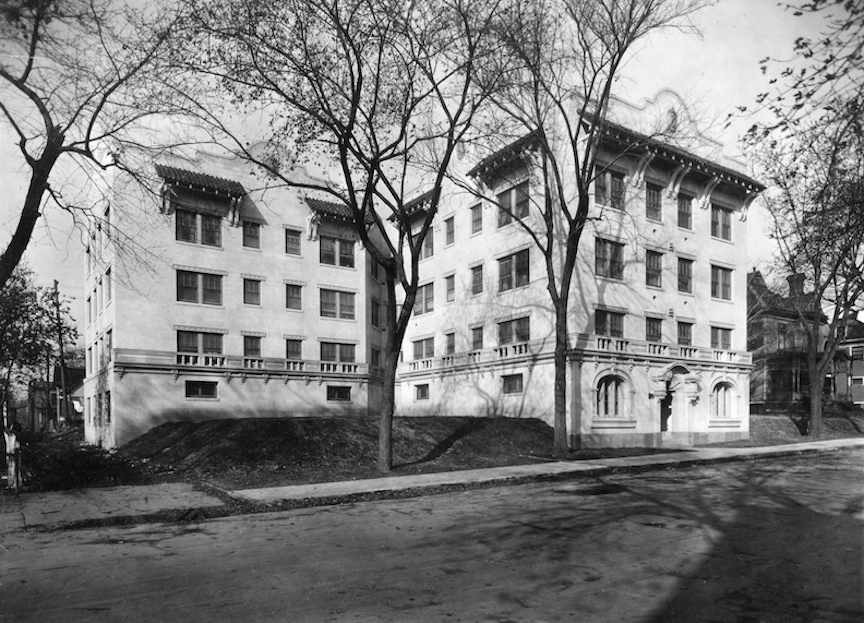
The La Morada Apartments, originally the Palmer Apartments at 554 South 26th Street. Bostwick, Louis (1868-1943) and Frohardt, Homer (1885-1972). The Durham Museum. 1921. This great apartment building still stands and one of the last original buildings on the block. The Abbott residence was across the street from La Morada Apartments, to the east. If you peek to the north of this apartment building (right side of photo) you can see the kind of homes that once lined these blocks. Gorgeous. In the early 2000s I lived a block to the west of this one and did not relish walking this block or many around the area, although I loved the older buildings.
After publication of the articles and his book, Abbott seldom, if ever performed anywhere other than at home. These unique late-night performances were invitation-only. As touched upon, he didn’t charge an entrance fee, and only suggested that his guests attempt to outsmart him. David P. Abbotts’ Talking Vase was developed in 1909, most likely in this 559 South 26th Street home.
I was interested to find that when David and Fannie weren’t coconspirators in magic, they were collecting real estate. The couple paid fourteen thousand dollars in June of 1909 to purchase of an apartment building at 24thand Landon Court from Mrs. Elizabeth M. McKeen. Elizabeth New McKeen was a leader in the social set, along with her husband William R. McKeen, Jr., inventor of the McKeen Motor Car and president of the McKeen Motor car company. The Mrs. was considered one of the most beautiful women of Omaha Society and was a published author. The McKeen pair went through a very public divorce when she claimed cruelty; it was later brought into court that she had danced with another gentleman in public. And then I believe the enraptured dancers might have wed. Scandal! No doubt the purchase of the McKeen apartment building was an investment and I found the Abbotts held onto this source of income through their lives.
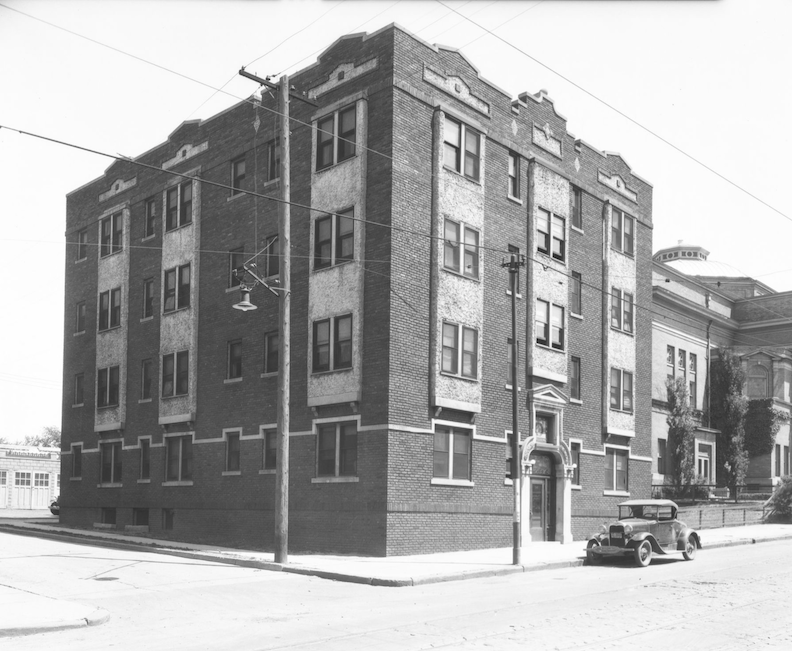
An exterior view of the Latona Apartments, located at 541 South 24th Street (24th and Landon Court). Bostwick, Louis (1868-1943) and Frohardt, Homer (1885-1972). The Durham Museum. 1935-06-25. The Latona is still standing and looking marvelous as ever. (Hold onto your purse and see below.) The Abbotts’ property had situs address of Lots 9 and 10 of Convent Place. Queerly, the once Latona apartment building is on a portion of those lots. Did the Abbotts own this building or another very near that is non-extant? I believe the latter is true. The city has 541 South 24th Street listed as being built in 1913, which doesn’t match up, but these dates with the city are incorrect on occasion.
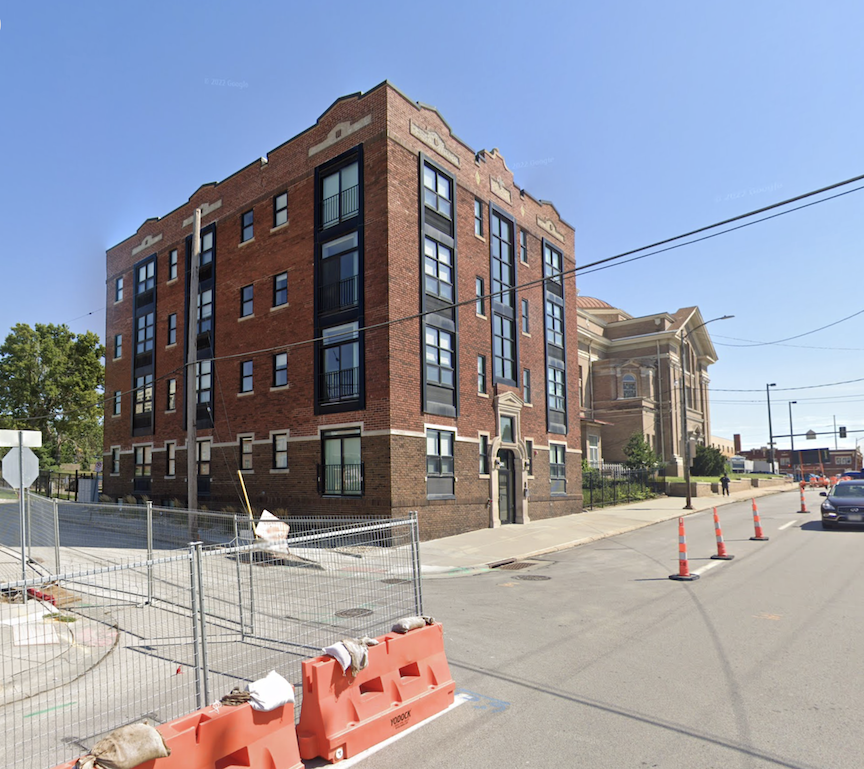
How 541 South 24th Street looked in 2022.
In January of 1912, David’s 69 year old mother, Sarah Frances Abbott, died of Bright’s Disease in the family home in Falls City, Nebraska. As reported in the Omaha Daily News, her funeral was to be held at David and Fannie’s home at 559 South 26th Street, her body being shipped by the Missouri Pacific. A home funeral was not unusual in those days but as will soon be revealed, the amount of funerals David would host became significant. The reference to Sarah Abbott as a “former Omahan” and her status as one of the pioneering ladies of Nebraska led me to believe that her burial in Omaha’s West Lawn cemetery was not particularly unusual. June, David and George were the only Abbott children living in Omaha at the time of her death.
The Fieldcrest Lots
In January of 1913, Elma R. Preisman purchased Lot 18, Block 2 of the Fieldcrest Addition from realtor-developer William C. Norris of Norris & Norris. This is the largest portion of the parcel that would later accommodate our 3316 Center obsession. But at this time, under Preisman’s name, it remained an empty lot. Not until Elma Ruth Miller Preisman’s death in 1950 would it come together. Mrs. Preisman was married to Omaha Famous William Abraham Preisman, a local pawnbroker and owner of the suspiciously named United States Pawn Shop and Clothing Store. The couple lived at 1446 North 20th Street and together, they acquired dozens of real estate lots in Omaha, sometimes under Elma’s name. Investments, one would guess.
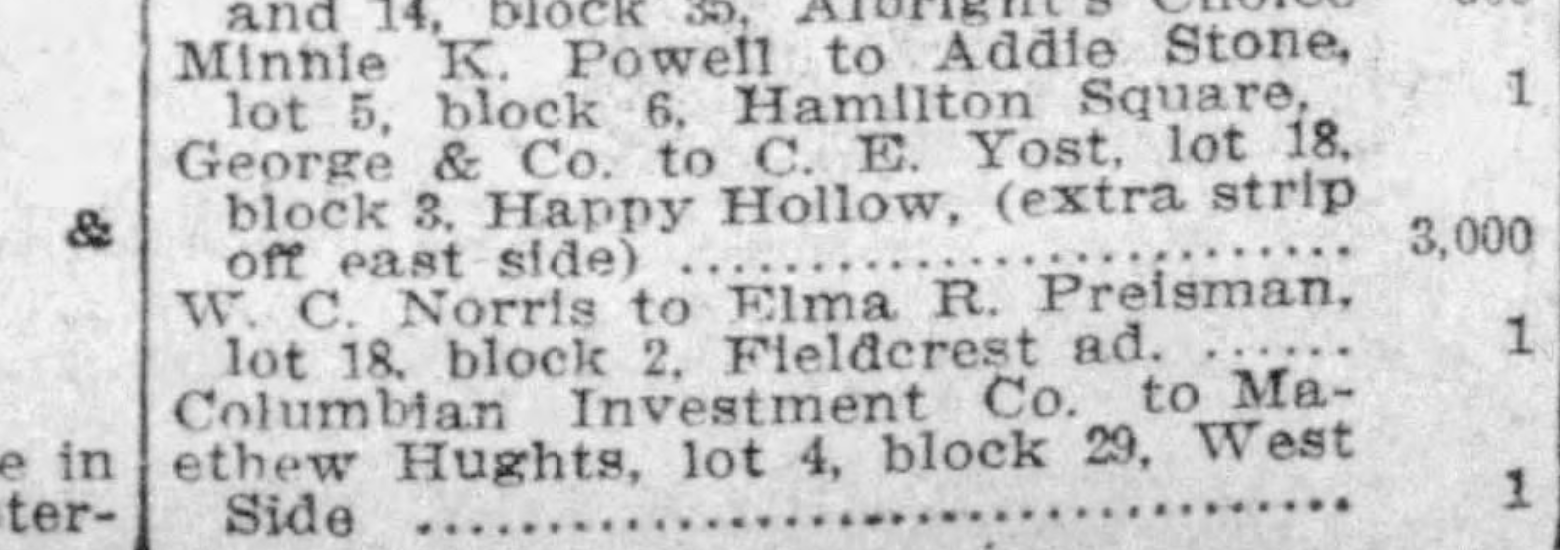
January 8, 1913. Omaha World-Herald.
By May of 1913, Fannie Abbott, David Abbott’s wife and co-fantasist, purchased the lot to the west of the Preismans’.
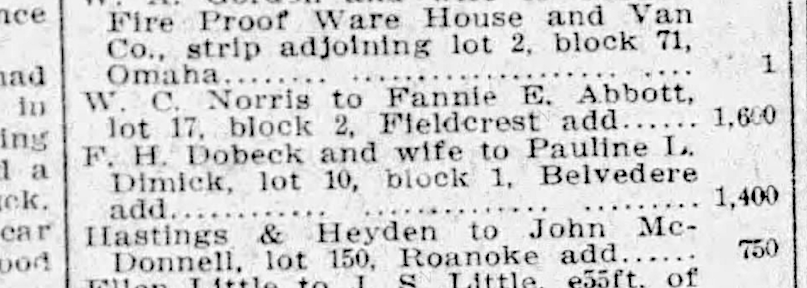
May of 1913. Omaha World-Herald. W. C. Norris sold Lot 17, block 2 in Fieldcrest to Mrs. Fannie E. Abbott.

Aerial of the current Fieldcrest lots along the north side of Center Street. Yellow circle encapsulates our area of focus. I only include this image to show that the parcel boundaries for 3316 Center changed over time. Lot 17 denoted by the tiny, red “17” over the house ends where the red line is to the east of the 3316 Center house; Lot 18 is a half empty lot and has the neighboring home to the east (3310 Center Street) on a portion of it. The turquoise rectangle delineates the area that would become the merged parcel, after the Abbotts eventually obtain a portion of the Preismans’ property. 3316 Center is legally defined as Fieldcrest Addition Lot 18 Block 2 Lot 17 & W ½ 75X 133.81.
1913, August 16, the Evening World-Herald announced D. P. Abbott was applying for a building permit for frame dwelling for lot 17, block 2. $3,500 on 3316 Lincoln Avenue.
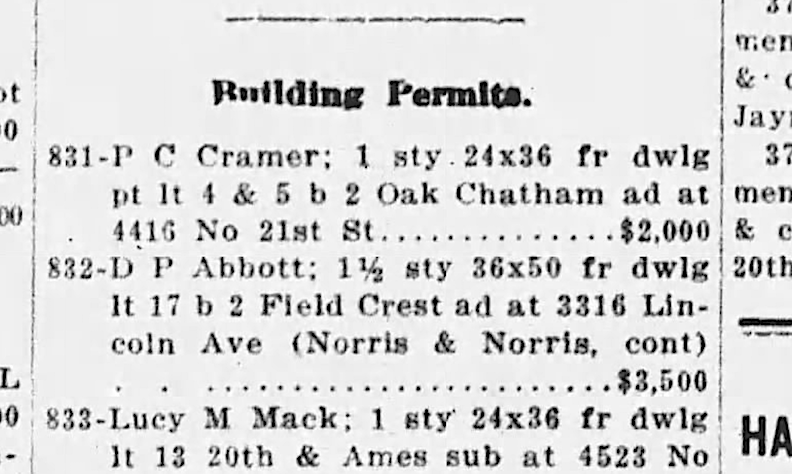
The Daily Record also made mention. August 16, 1913.
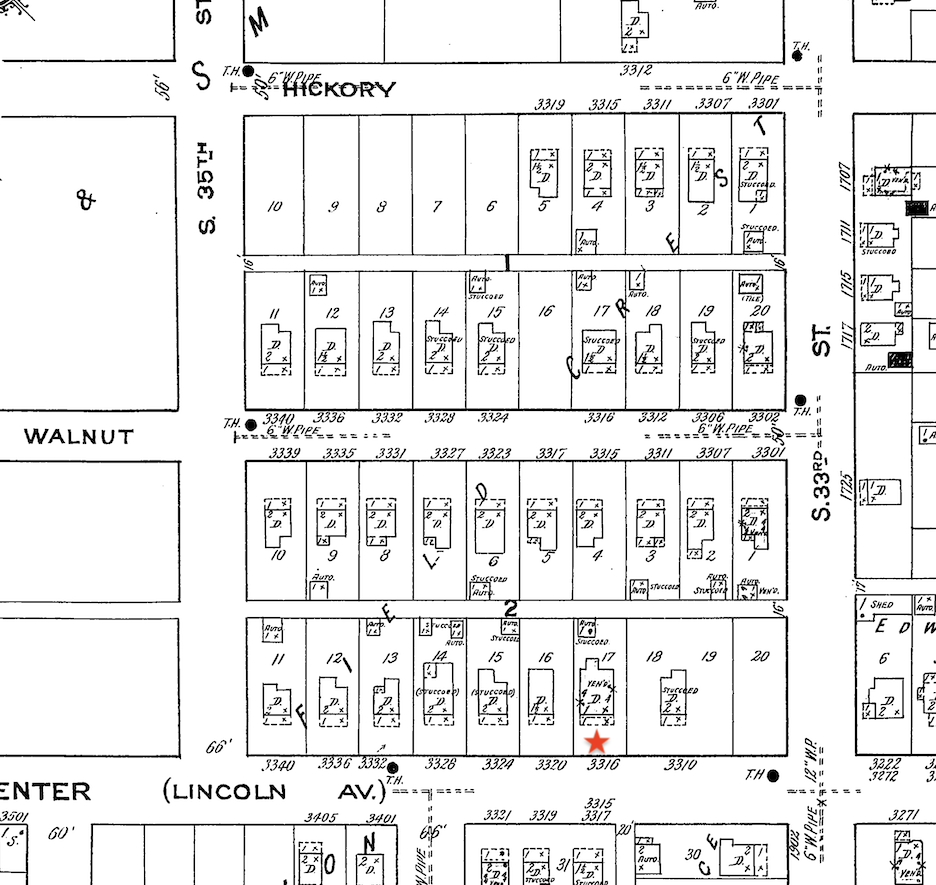
This 1918 Sanborn map more clearly defines the oddity of the 17, 18 and 19 lot disbursements. Interesting to note that the home to the east, 3310 Center, was built in the middle of lots 18 and 19. The western portion of lot 18 would later be added to the Abbott’s 3316 parcel. Red star denotes the 3316 Center Street parcel. This map shows the whole Fieldcrest Addition. Part of the marvel of this whole area is the nice, wide, paved, network of alleys. So functional. More later on alleys.
On the Surface
Undoubtedly, while the 3316 Center Street home was being built, David P. Abbott found a new prominence in Omaha.
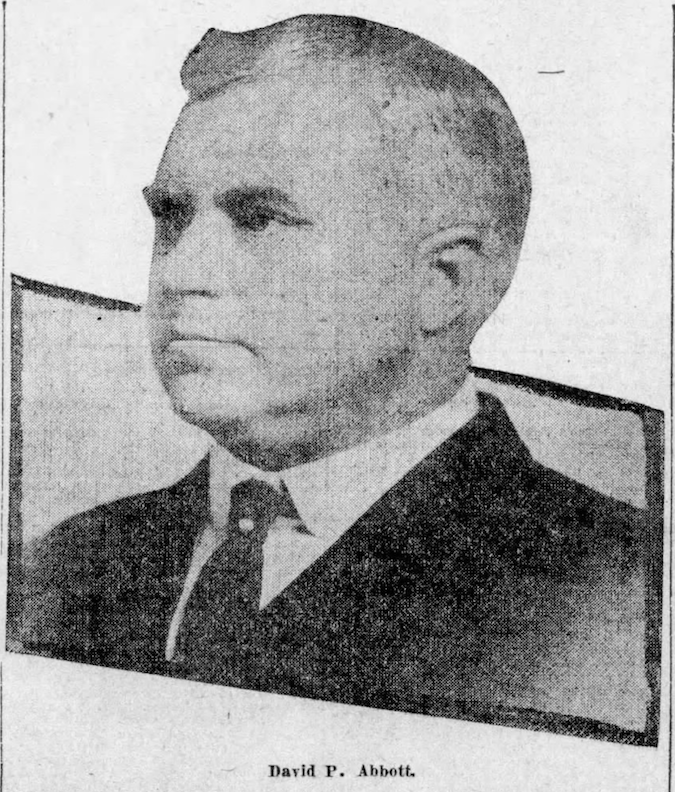
Omaha World-Herald photo. May of 1913. “The pleasure and obsession appeared to be exposing baffling tricks and finding that there was no spiritualist or conjurings involved in the trick. Offering clear explanation of the stunts that mystified the scientific world.” Mr. Abbott was manager of the Omaha Chattel Loan Bank, according to the Omaha City Directory of 1913.”
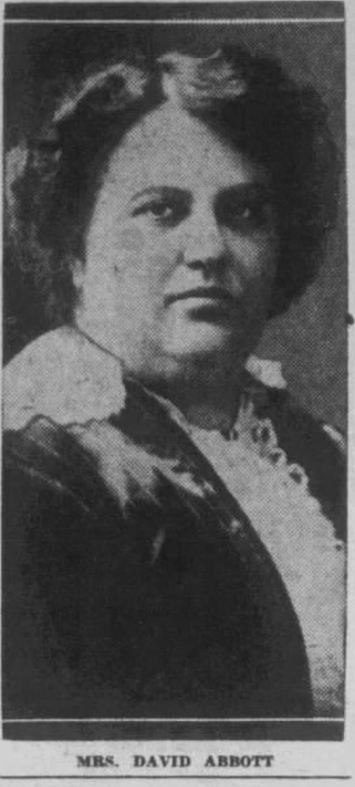
….and here’s Fannie Miller Abbott. I really like this photograph.
Omaha Daily News had this summary of the Abbotts: “He is an ordinary, comfortable looking man, inclined to stoutness with florid face, ample girth, short, fat hands that don’t look anything like those of a wonder worker; a good, broad smile, eyes with a twinkle of fun in them and tendency to shortness of breath under the stress of his work. Mrs. Abbott, who assists her husband on occasion, is just as ‘homey.’”
The Architect
Birger J. Kvenild was hired by the Abbotts to design their dream home. As we learned earlier, At this time, the Field Club area was seeing a second surge in popularity, and the Abbotts, no doubt, wanted to position themselves in this nice “West Omaha” neighborhood. I was surprised to learn that W. C. Norris, who sold the Abbotts their Fieldcrest land, had a hand in the Abbott house’s construction as well. That’s right, Norris & Norris built 3316 Center Street working from Kvenild’s design and conceivably his direction, considering Birger J. Kvenild’s experience as an engineer.
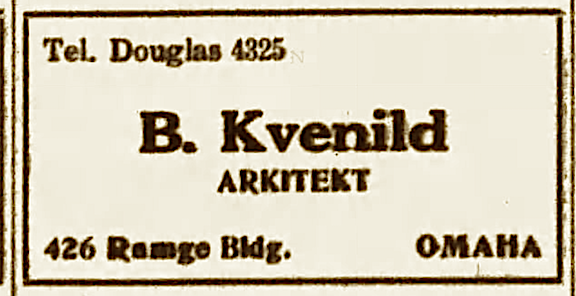
1915 advertisement.
Architect Kvenild was a compelling option. Born in Norway in 1879, Kvenild worked as an engineer, landscape artist, and architect, and the Ramge building in downtown Omaha served as his office. After finishing his education in Norway, he went on to study in Germany and England before traveling to America. He was working as a draftsman “with the elevation of railroad trackage” in Long Island and arrived in Omaha in about 1910. That November, I discovered him working as a draftsman for the municipal engineer, taking in $100 per month. Because of his training and background, Mr. Kvenild was expected to become the secretary of the newly formed city planning board by 1916. The annual salary for this post would be $2,500. Mrs. Margaret, often “Margit” T. Kvenild was born in Sweden and educated in Paris. The couple had sons, John and Robert.
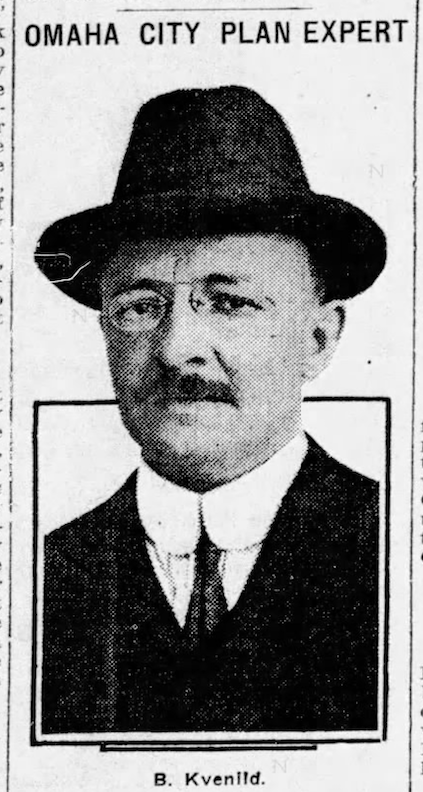
1916. Mr. Birger J. Kvenild became the Omaha City Planning Expert. One of Kvenild’s interesting contributions when he took his new job as secretary of the City Planning board was to prepare a map showing all 35,221 residences, 3,835 store buildings and 212 office buildings in Greater Omaha. He secured the data from the post office. “The mail carriers compiled the information from their routes.” Miss Cassette would sure like to see this historic hand drawn map, although probably long ago thrown on the fire.
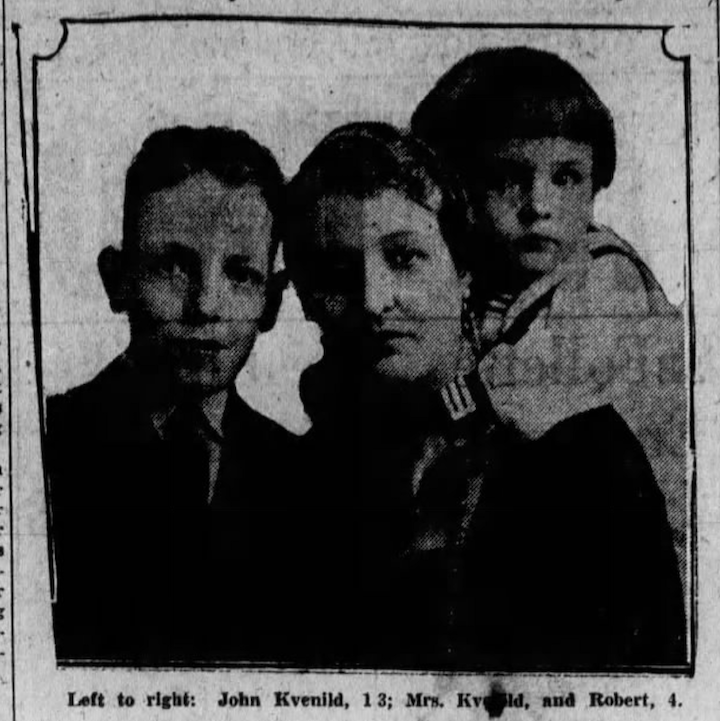
1924. Omaha Daily Bee. John and Robert Kvenild with their dear mother, Margit.
For approximately 40 years, Kvenild was employed as the architect for many of Omaha’s most exquisite homes. In the past few years, as Omaha architects and historic architecture have gained more attention, Kvenild has once again become something of a celebrity. I want there to be an ad campaign. Two beautiful women are having drinks and one leans in and whispers: “Do you have a Kvenild?” In 1911 Mr. Kvenild lived at 2206 South 32nd Avenue; his wife and son, John, had not yet joined him in Omaha. Robert was born years later.
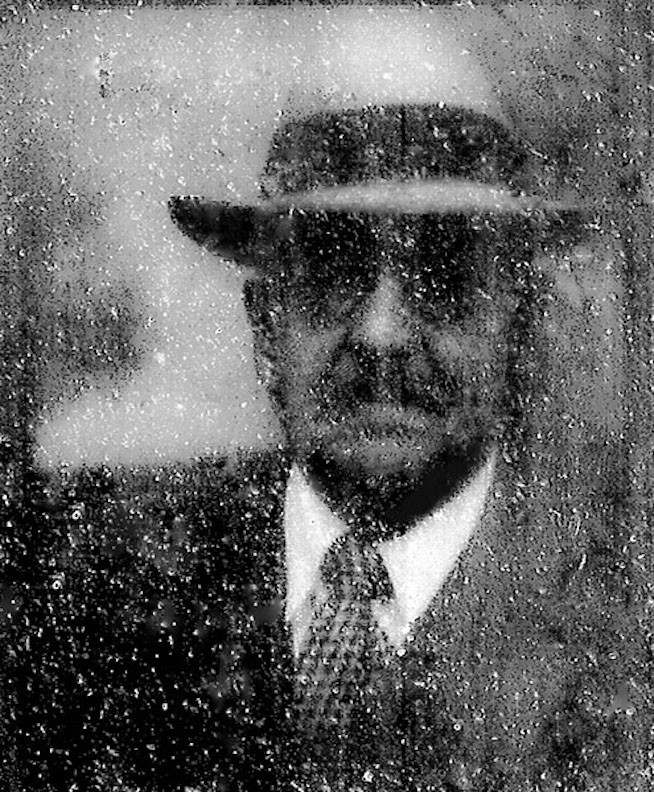
Portrait of Birger J. Kvenild. 1937. Nebraska State Historical Society. No matter what anyone says, those who live in Omaha become cooler over time. The damaged photo helps aid the allure. Compare the two photographs and mail my office with your vote.
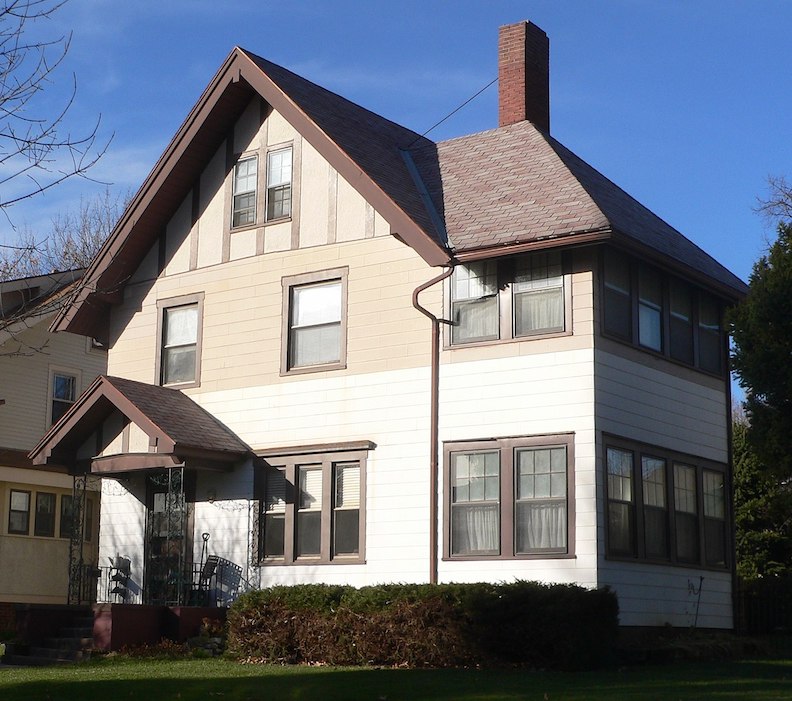
3510 Pine Street. 2015. Photograph borrowed from Ammodramus.
In May of 1913 I found a building permit for 3510 Pine in the Field Club neighborhood for Mrs. Margit T. Kvenild –a $3,000 dwelling. Interesting to think that Kvenild was building his family home at the same time he was drafting the Abbott home. Later still, “B. Baldwin, a prominent man of Douglas County, living at Elkorn has decided to make his home in Omaha and bought the residence of B. Kvenild, 3510 Pine Street in the Field Club district for $6,500. Mr. Kvenild planned to build a new colonial style house in the same neighborhood.”
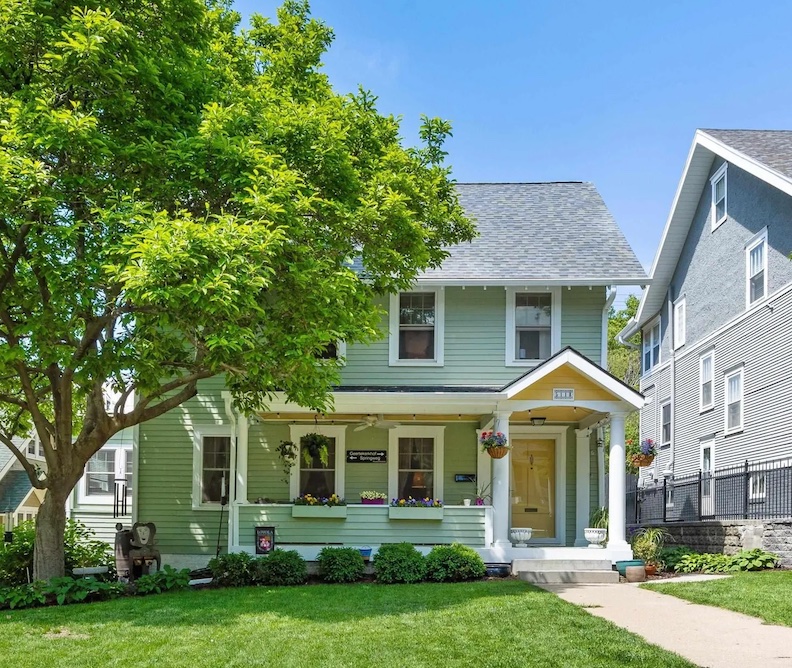
His later family address was at 5118 California Street in Dundee; he designed and built this home in 1919. (Misspellings recommenced: The 5118 California Street building permit was recorded under the name Mrs. Margil T. Krenild in March of 1919.) Kvenild also operated his architectural firm from this residence. This gorgeous girl was for sale recently, and although I coveted the interior photos I discovered in the real estate listing, I was glad to hear the owners had reconsidered and decided to stay put. I can see why!
Mr. Birger Kvenild died in 1953.
The Style
One of the most distinctly American styles is the solidly graceful house known as the Craftsman Bungalow. The Abbott’s new home at 3316 Center was designed in the Craftsman Bungalow style. I will share my suspicions of why they selected this style after we’ve reviewed. Of the varying kinds of bungalows, the Craftsman Bungalow was thought to be influenced by the English Arts and Crafts style. Primarily built from 1900 to 1929, the bungalow spread throughout the country and then the world. “Architectural historians believe bungalows came along at a time when the nation was filled with ‘self-confidence and pride.’ The American way of life was touted as informal, healthy, wholesome. Americans wanted homes that reflected that life.”
Virginia Savage McAlester’s A Field Guide to American Houses (1984, 2013) traces the Craftsman’s origin to Southern California where she said the Greene brothers, architects Charles Sumner Greene and Henry Mather Greene, (educated at MIT, apprenticed in Boston, and moved to Pasadena, California), pioneered the Craftsman style bungalow. The English Arts and Crafts movement, Oriental wooden architecture, the rugged Shingle Style in the Northeast, and the manual arts were their influences. However other architectural historians site Gustav Stickley as the original designer of Craftsman homes and furniture. Stickley said he wanted to teach that “beauty does not imply elaboration or ornament; to employ only those forms and materials which make for simplicity, individuality and dignity of effect.” The casual style Stickley described is “felt” immediately when one steps into 3316 Center Street—there is an openness, a social flow, not like the formal, controlled hall and parlor houses. This Craftsman style spread throughout the country by pattern books and popular magazines. The Sears, Roebuck and Co. catalog literally sold trainloads of them, building materials included. By the mid 1920s, the Craftsman style “rapidly faded from favor,” on authority of Savage McAlester.
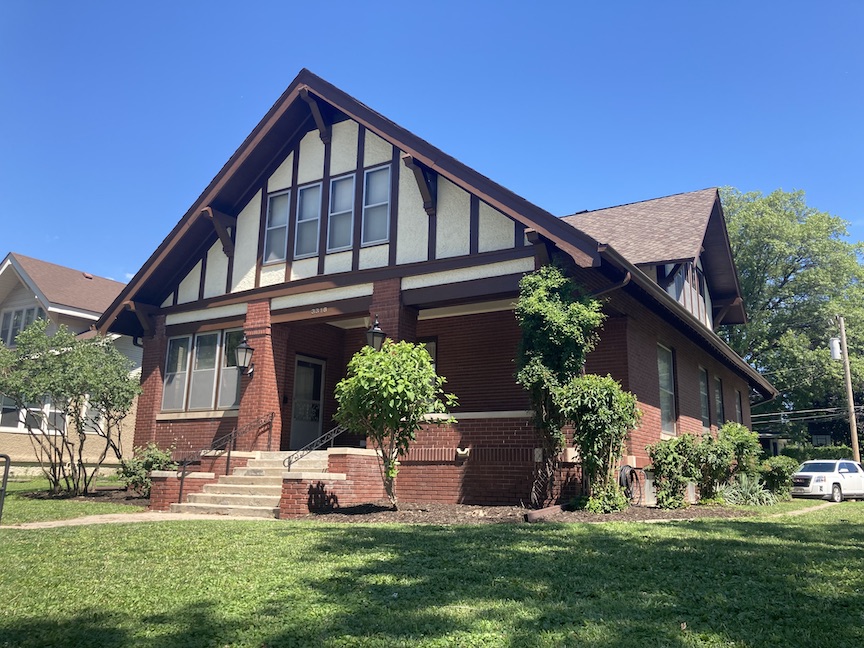
Southeastern view of 3316 Center Street. The exterior is strikingly handsome. The spacious, full, darkened porch called to me.
A Field Guide to American Houses stated the front-gabled roof made up “about one-third of Craftsman houses. (…) Craftsman doors and windows are similar to those used in vernacular Prairie houses.” Two or more windows are often grouped together in one assembly. Dormers are commonly gabled.” Savage McAlester observed the most common Craftsman wall cladding is wood clapboard but that in the Midwestern states, brick was frequently used. More on Omaha’s love of bricks in a bit. 3316 Center’s particular style of Craftsman Bungalow is mentioned in Savage McAlester’s writing: “A secondary influence such as Tudor false half-timbering are sometimes seen.”
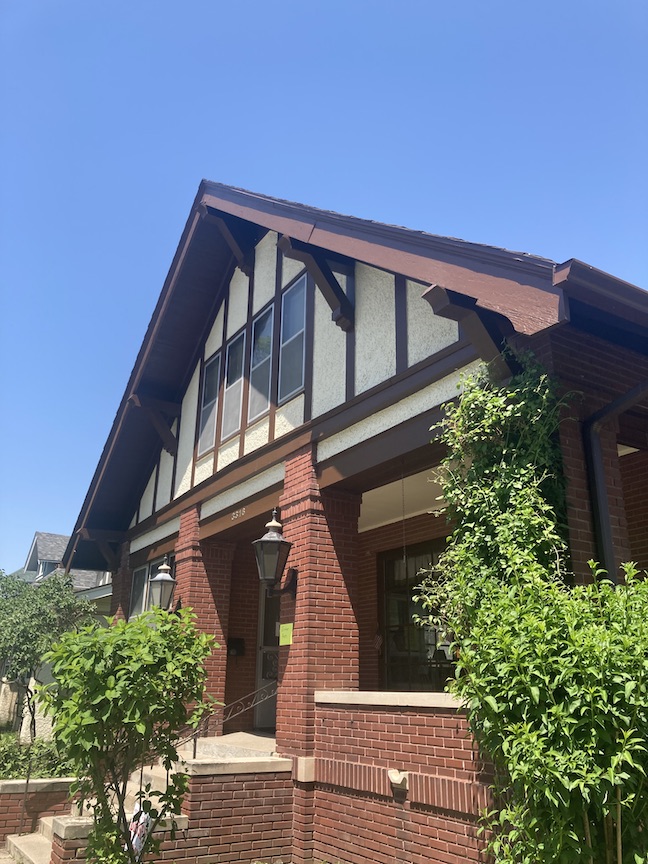
Typical features: One or one and half stories; Overhanging eaves; Generous and yet hidden, cozy porch; Heavy columns on the porch often with rock or stone supports; Double-hung windows, with three or six over one; commonly one or one and half stories high. Columns continue to ground level, without break at level of porch floor.
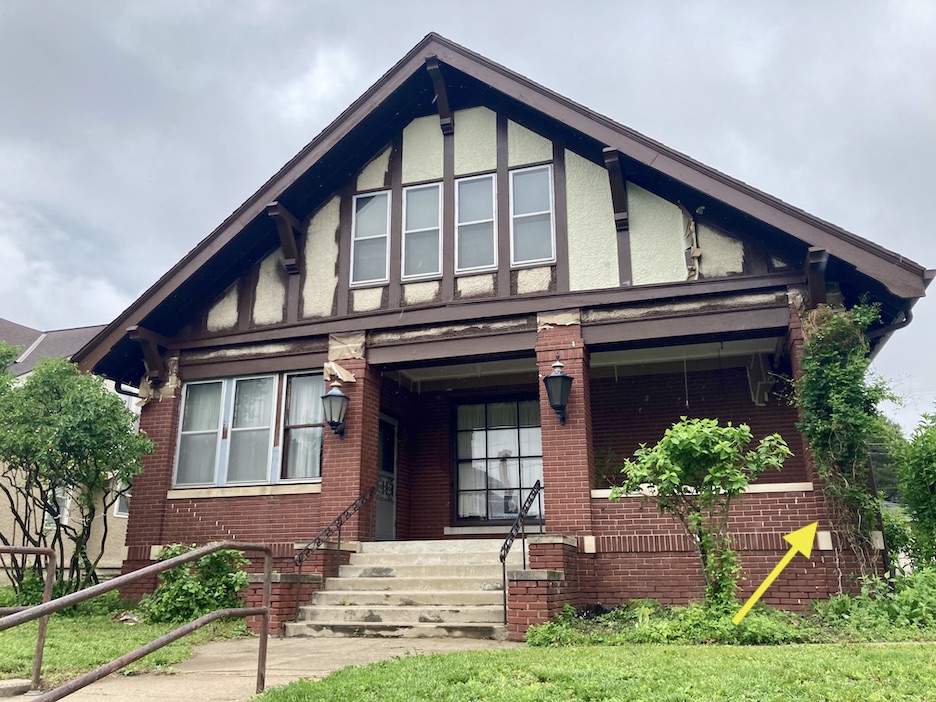
Another painting day photo. Yellow arrow points to the column that continues to ground level, without break at level of porch floor.

Southwestern view.
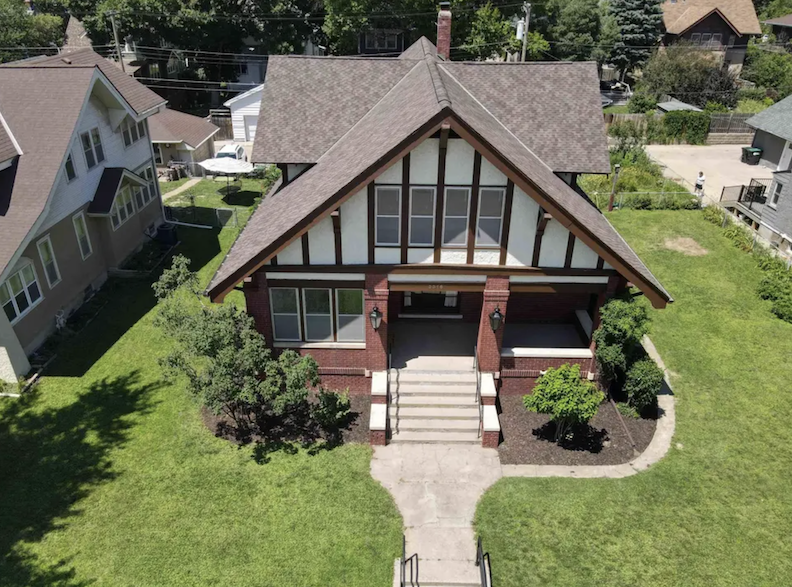
Knee braces commonly used in the gable ends of Craftsman houses are purely decorative. Wide, unenclosed eave overhang. Note how the main roof of 3316 extends over the porch. Porches, either full or partial width, have roof supported by square columns, in this case, brick. What I find interesting is that the left (western) portion of the 3316 Center porch was enclosed. As a design element, it adds an unexpected asymmetrical visual, creating a gorgeous, formal vestibule once inside. This easily could have been left open for the traditional Craftsman porch. I assumed the Abbotts requested this formal, large entry for added drama and presentation, as to not take away from their parlor, which doubled as seating and interactive stage for their performances.
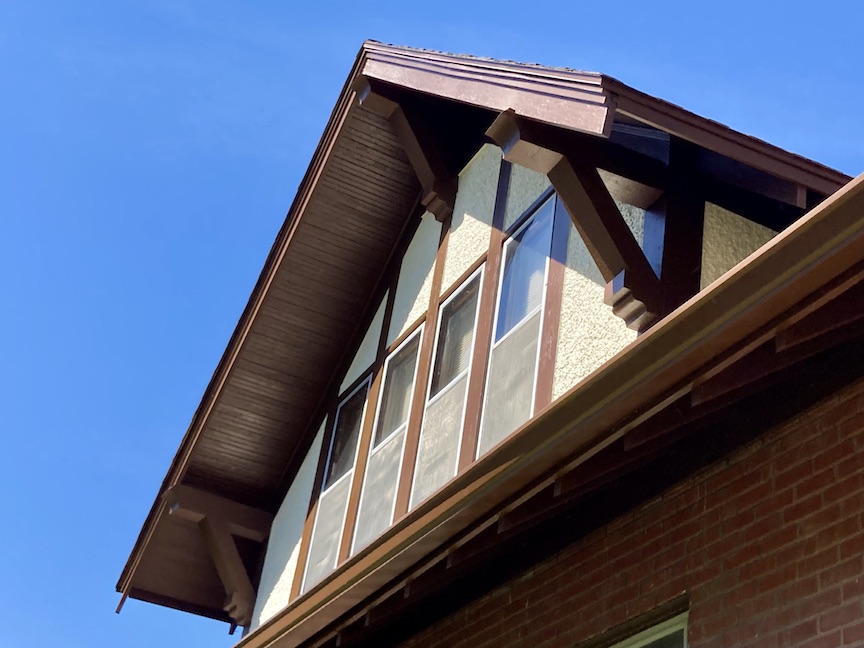
Eastern gable.
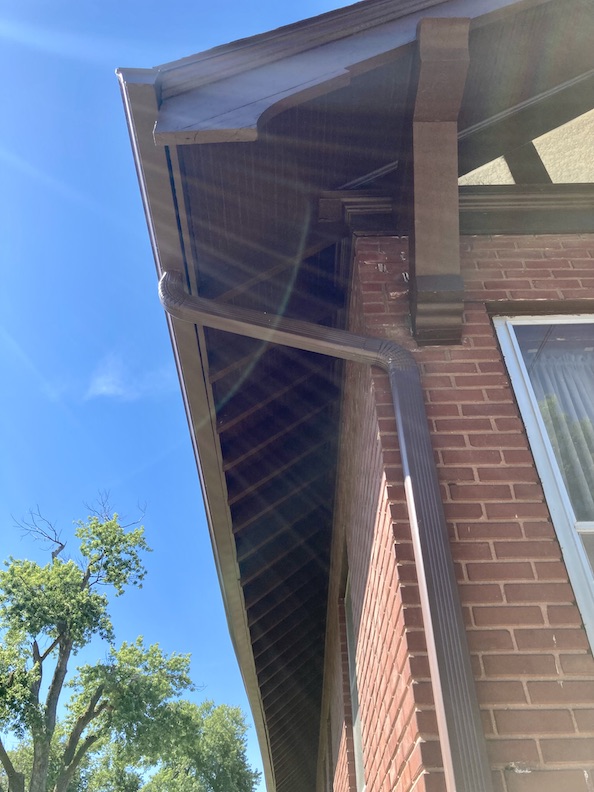
Eastern view. Knee braces commonly used in the gable ends of Craftsman houses. These are purely decorative. Wide, unenclosed eave overhang. Roof rafters are charmingly exposed under the overhang.
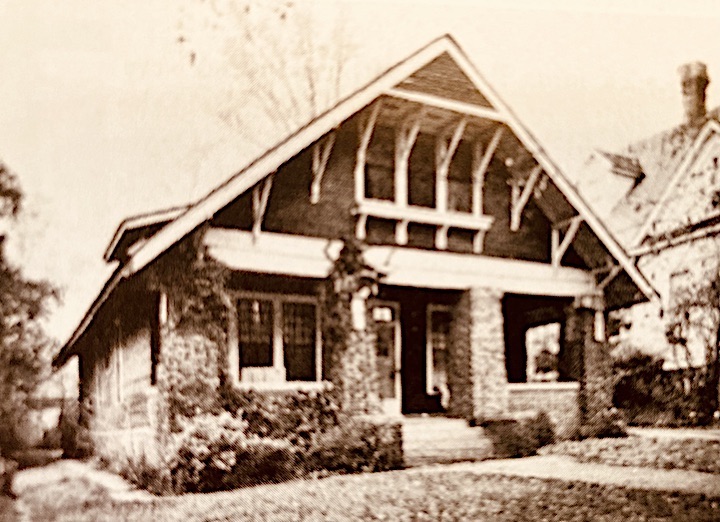
A great example of the open porch I am describing is evident this home in Jackson, Mississippi from 1910.
I traced the rising popularity of the Craftsman Bungalow in Omaha to 1911. Not only did it have appeal of a casual mountain or lake hideaway, but a brick bungalow was also regarded as a solid structure, better able to withstand our weather in these parts than the frame structures being built at the time.
I discovered information indicating that previous to 3316 Center’s construction, there was a shortage of bricks in Omaha between 1900 and 1907. Bricks were transported from other states. Timber was costly as well. 80% of brick walls erected in Omaha in the later 1910-1915 time period were faced with the brick furnished by Sunderland Brothers Company. I don’t know for certain that Norris & Norris got their bricks from Sunderland in the construction of 3316 Center Street but it is highly possible. The Platte River sand produced a dozen or more sites where the Sunderland Brothers loaded their tonnage of sand. Masonry, plastering and concrete and even the rising popularity of children’s sandboxes increased the demand for Sunderland’s Platte River sand.
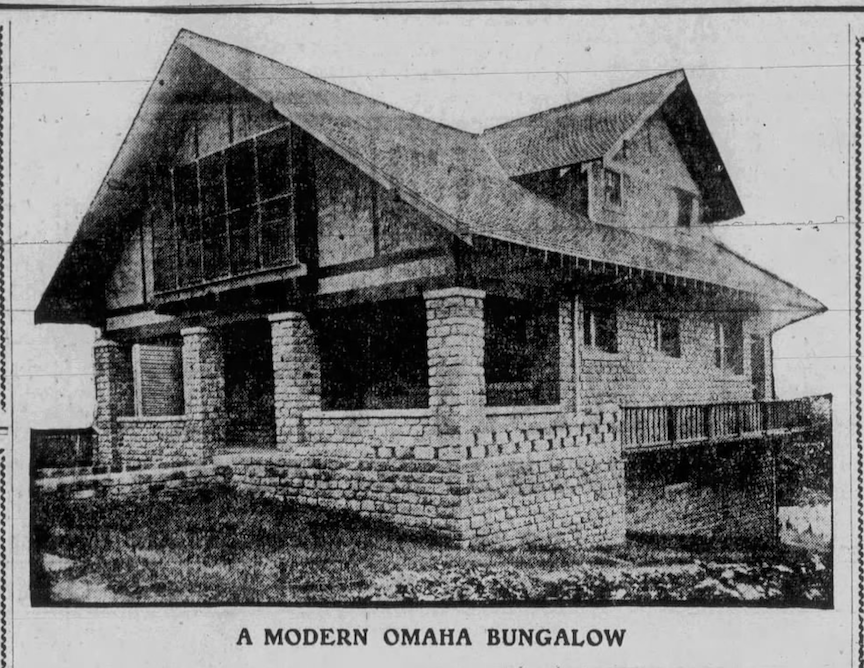
The Omaha-Craftsman style by way of Burd Miller: “First class modern bungalow for 1913. Finished in the latest designs of Craftsman trim: Colonade book cases, buffet and built in features, all of the finish of the cabinet maker’s art.”
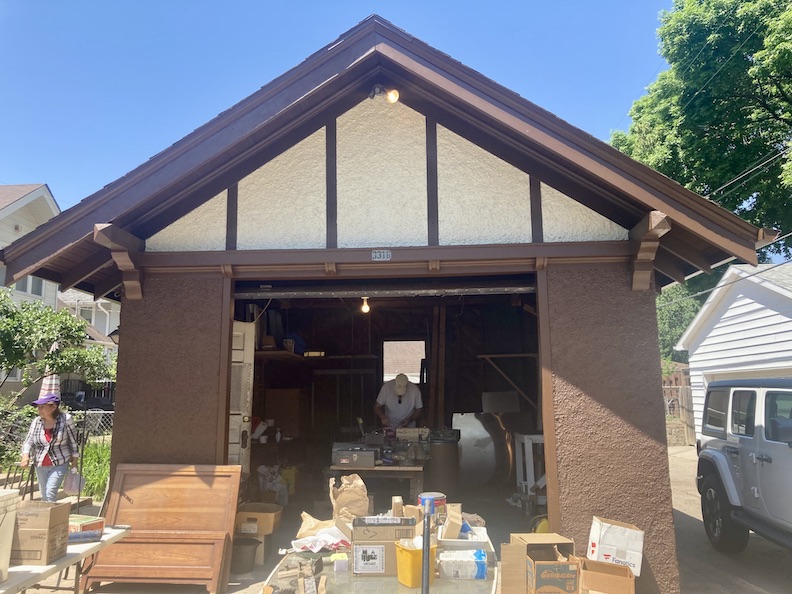
3316 Center Street garage. Photo taken on estate sale day. Unseen from the front sidewalk. The best alley of all time runs behind the home.

Alley behind 3316 Center. Camera faces east from 35th Street.
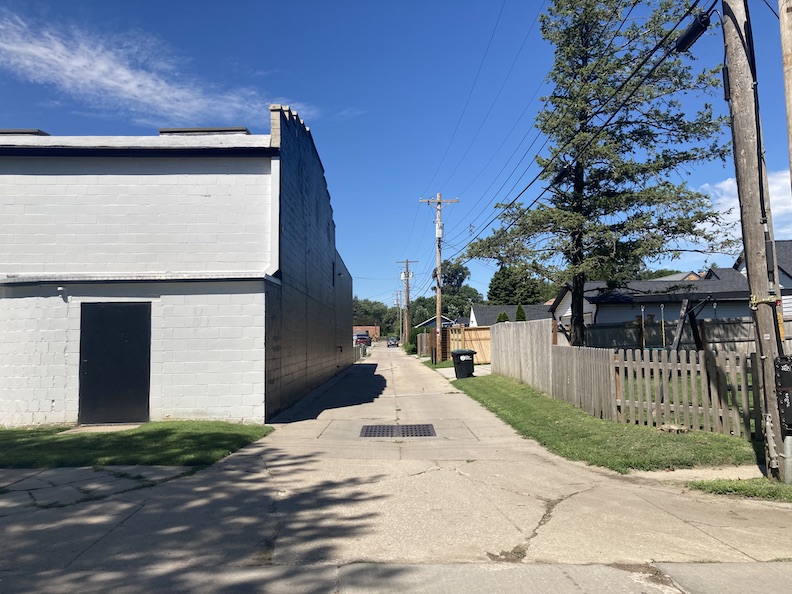
Alley continues on to the west, past 35th Street. The rear of the once Omaha Children’s Theater.
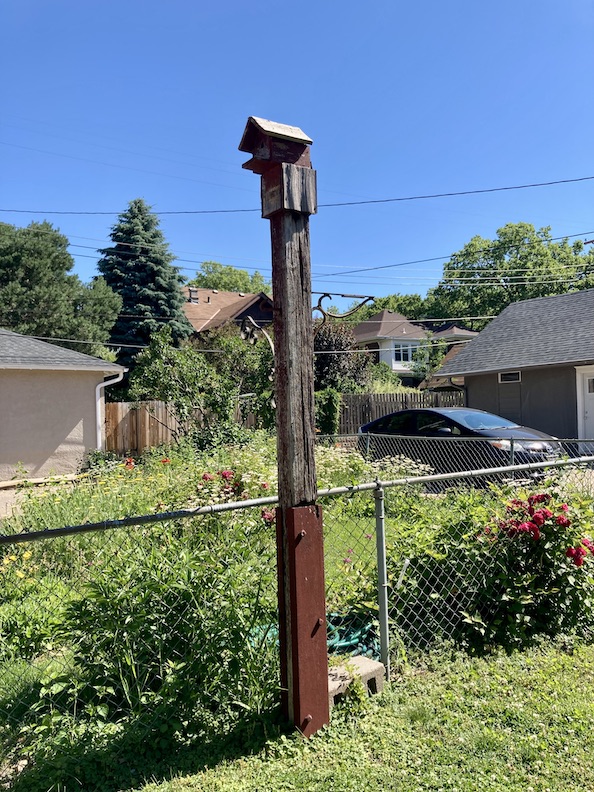
The Schrat family also divulged that this very post in their garden, now refashioned and serving as a birdhouse pole, was originally a hitching post for horses in the Abbott days.
Once inside the 3316 Center Street home, as with traditional Craftsman Bungalow houses, there is an airy quality due to her large, open rooms. The home is 3, 276 sq.ft., after all. I was struck with 3316 Center’s substantial bones and the quality of craftsmanship–finely proportioned woodwork. The standard description of a Craftsman Bungalow are mirrored in 3316 Center right down the line. Living room joined to dining room with an arch or columns between; quarter-sawn oak floors; touches of artistry; built in cabinets or sideboard; small kitchen; living room doubles as family room; fireplace; garage unseen from the street. In the case of the Abbott’s 3316 Center there was a wide “parlor” which led into Mr. Abbott’s “library” and then an equally easy flow to the dining room. We will view these attributes shortly.
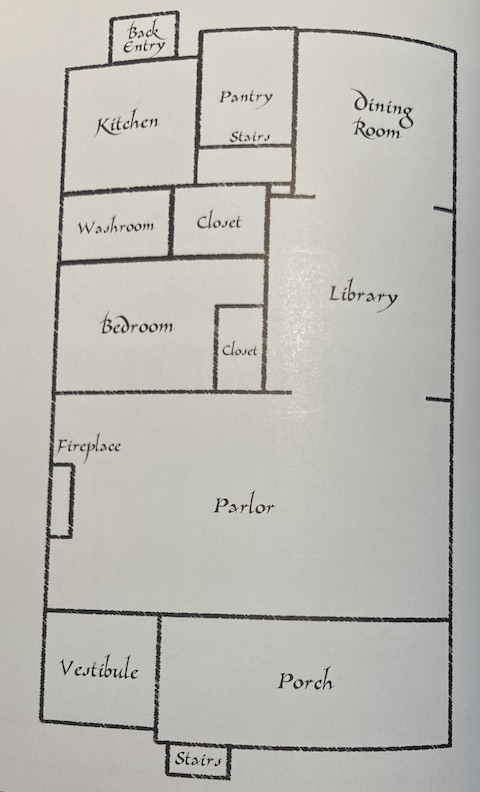
Accurate layout of the expansive first floor as found in House of Mystery: The Magic Science of David P. Abbott Volumes One and Two edited by Teller and Todd Karr (2005).
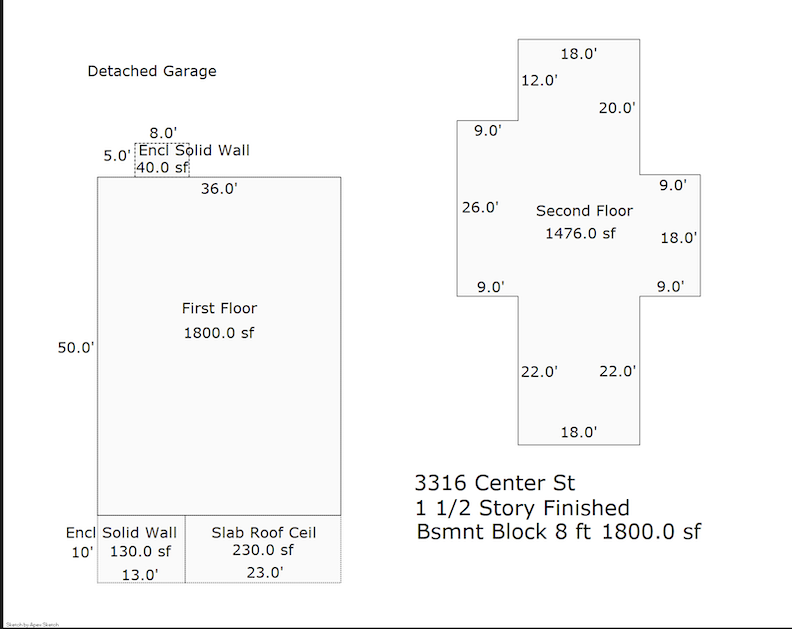
3316 Center Stree floor measurements as seen on the Douglas County Assessor’s site.
The House of Mystery
I believe the David Abbotts chose the Craftsman Bungalow style because of its popularity of the times, but also because of the ease of flow. The residence, in its original state, was readily modified to accommodate his ever changing style of performance. David had long manufactured his own props and apparatus for his shows as well as to experiment and figure out what he thought he was seeing in others’ shows. The Abbott couple’s move to 3316 Center allowed for additional space and for his laboratory. In an Omaha Morning Bee News article I learned that Mr. Abbott included in the architectural plans a room in which was stored “his paraphernalia for deception.” This room would later be called his “laboratory,” for his psychical research, containing all testing equipment used by “fake mediums for creating illusions” as well as creation of his own devices. Where exactly was this laboratory, you ask? Magician Teller stated, “The inner closet where Abbott once stored his props behind sliding glass doors is beautifully intact, except that it now houses sweaters and socks in place of skulls and teakettles.” From this I gathered Mr. Abbott’s lab would become a closet or storage space in the Schrat’s bedroom. My photographs to come. But there was also query of a “part of the walled up area in the kitchen.”
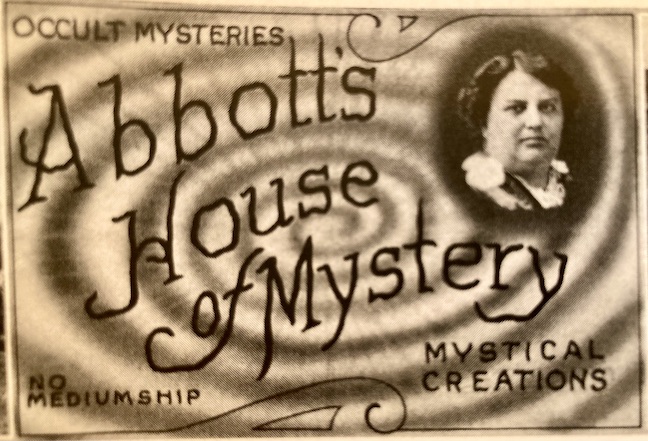
Psssst…that’s Fannie Abbott in the upper right hand corner. Don’t stare at this too long….or do!
It was soon after this move that David Abbott named his 3316 Center The House of Mystery. It is an excellent name. Perhaps the name was lifted from the 1912 national “House of Mystery” scandal in Brooklyn, New York? When someone entered the Samuel E. Haslet mansion for the first time in twenty-five years, aside from the eccentric owner, they discovered the elegant home was furnished with exquisite pieces– magnificent furnishings, boxes of gold and silver coins, rare books and two inches of undisturbed dust. Haslet had sealed himself away in one room of his mansion, twenty-five years prior when his wife burned to death, refusing admittance to anyone, and he didn’t go outside himself except to see his attorney. For his air of intrigue, Haslet had been named The Hermit Millionaire in his House of Mystery. The intruder, as it turned out, was a physician sent by the millionaire’s attorney to attend to him. As the story evolved there was a crooked nurse who had penned the recluse’s will into his own name and even a former state Senator, Frank J. Gardner, who was arrested on charges of conspiracy to gain control of the Haslet estate. Honestly there were quite a few stories in 1912-1915 involving many different “House(s) of Mystery.” All tales were intriguing while none of them were pleasant.

Earliest image I could find of Omaha’s version of The House of Mystery. Bostwick, Louis (1868-1943) and Frohardt, Homer (1885-1972). The Durham Museum. 1920. Unassuming….just the way the Abbotts’ liked it.
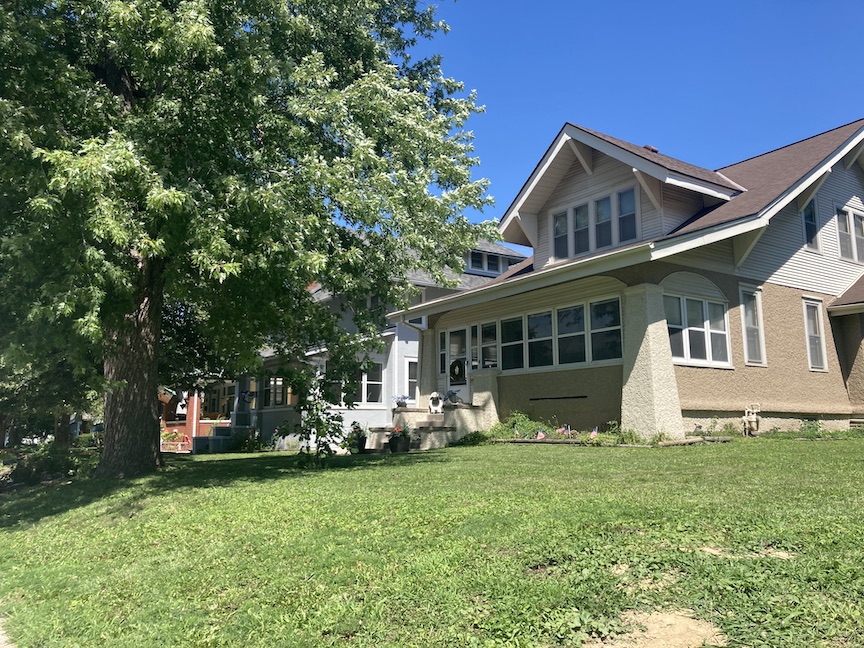
How the neighboring homes down the west of Center look today. Interesting to see that the house directly next door filled in their open arched porch with windows. The arches are still evident.
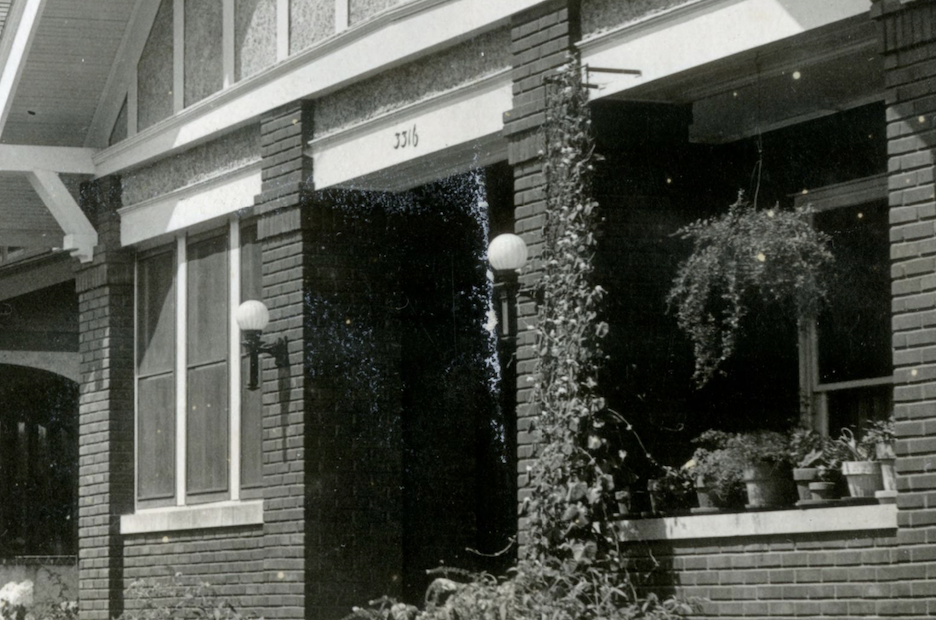
Detail of 3316 Center, The House of Mystery. Bostwick, Louis (1868-1943) and Frohardt, Homer (1885-1972). The Durham Museum. 1920. Please note the plump, little, variegated globe lamps. I believe these were the original lanterns. The Abbotts were gifted many exotic gifts from all over the world by magician friends, royalty and celebrity alike. These original globes would be changed out in time for art deco icicle-fire porch lamps. Tuck this up your sleeve, detectives. More later.
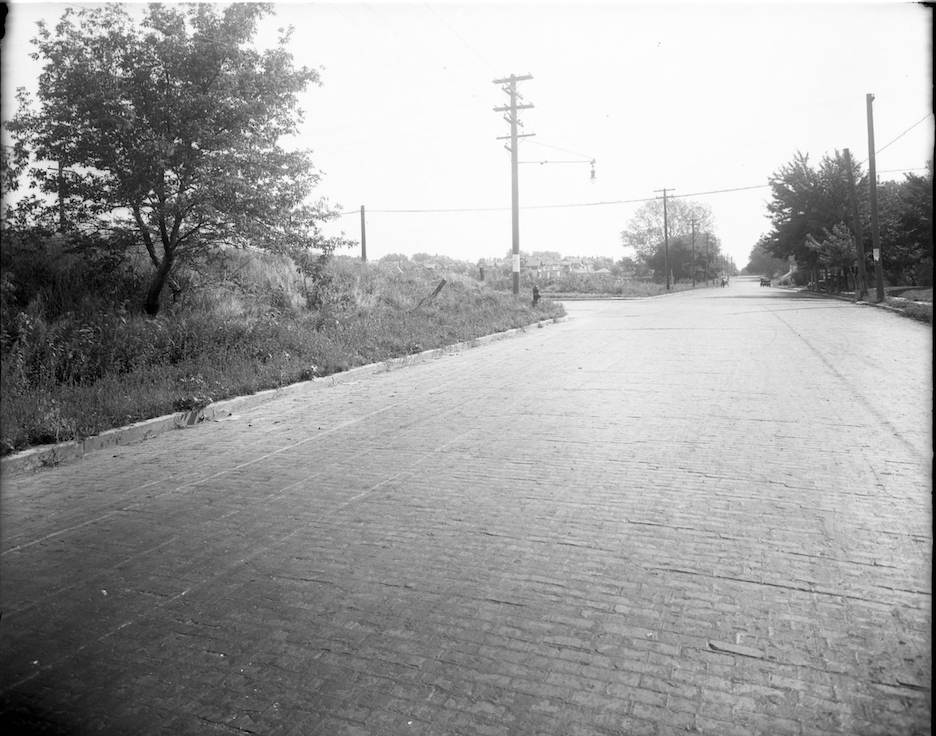
I include this incredible, desolate photograph to give a sense of the area. Camera faces east, looking down Center Street from 36th Street. 3316 Center would have been in the far distance on the left hand side of the street. Bostwick, Louis (1868-1943) and Frohardt, Homer (1885-1972). The Durham Museum. 1919.
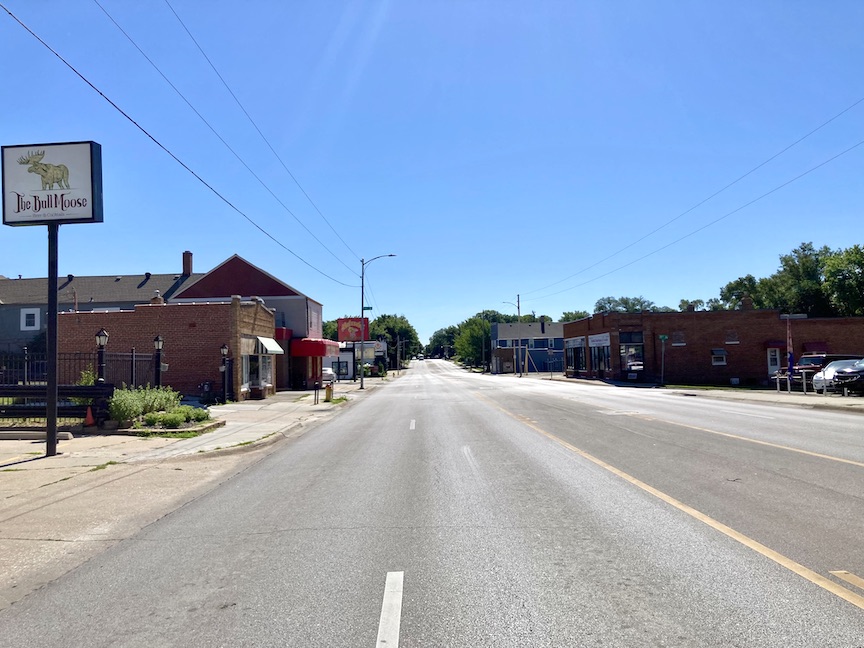
How 36th and Center sizes up now. Camera faces east, looking down Center Street from 36th Street.
The Silent Star Revealed
It was in study of House of Mystery: The Magic Science of David P. Abbott Volumes One and Two edited by Teller and Todd Karr (2005), that I learned many things about Abbott’s process and how his 3316 Center Street was cast in a principal role in all of it. After moving into 3316 Center, Abbott preferred to perform in his parlor, human scale, up close and observable. In Teller’s words, “Abbott modeled his performances not on stage magic, but on the principles of the spirit mediums, he had studied and exposed.” I would find time and again Mr. Abbott referencing his late-night performances as Mystery Seances. But it was only really in my own study of the house that I could begin to “see” how it all might have worked. What a stirring delight I had in the handful of visits. It was hauntogenic at its premium. Not in the eerie, possession sense, but in the conceptual framework of “feeling” the life of the house, sensing the everyday in the decades past. It was clear.

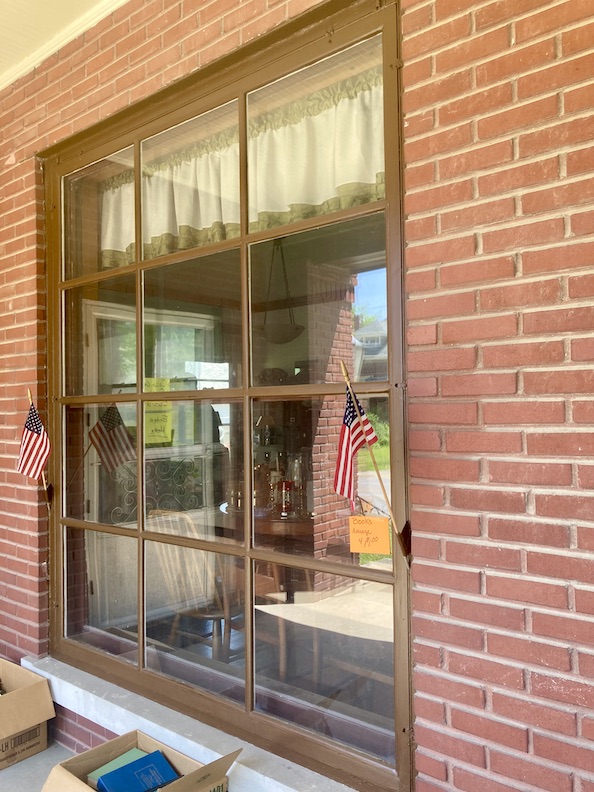
The first thing one sees as they climb the front stairs is this incredible, south-facing picture window on the porch. This photograph was taken during the estate sale.
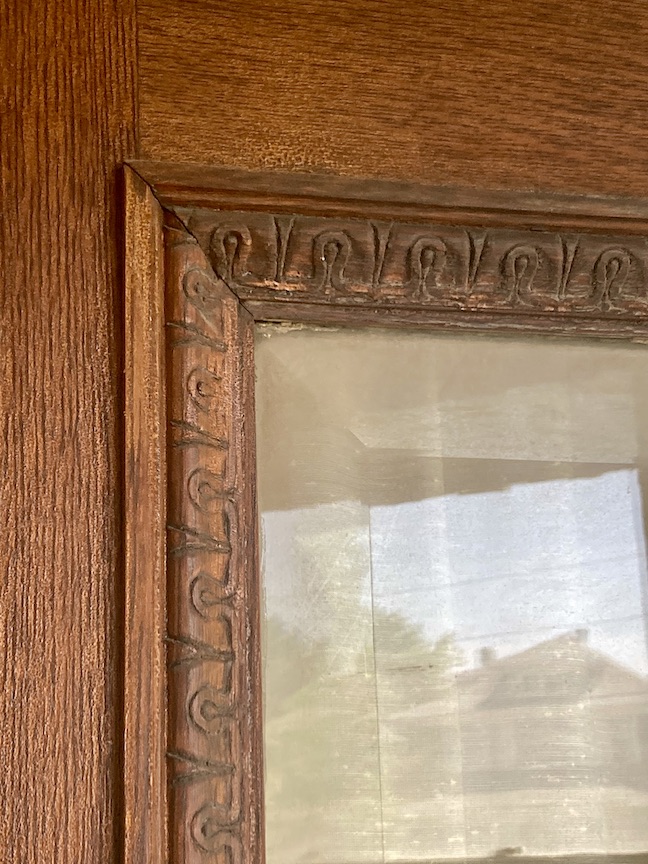
Front door details. Thick, beveled glass and fanciful trim design. This door is in fine shape. It is common to find these carvings and trim detail cracked and damaged.

Fantastico front door handle.
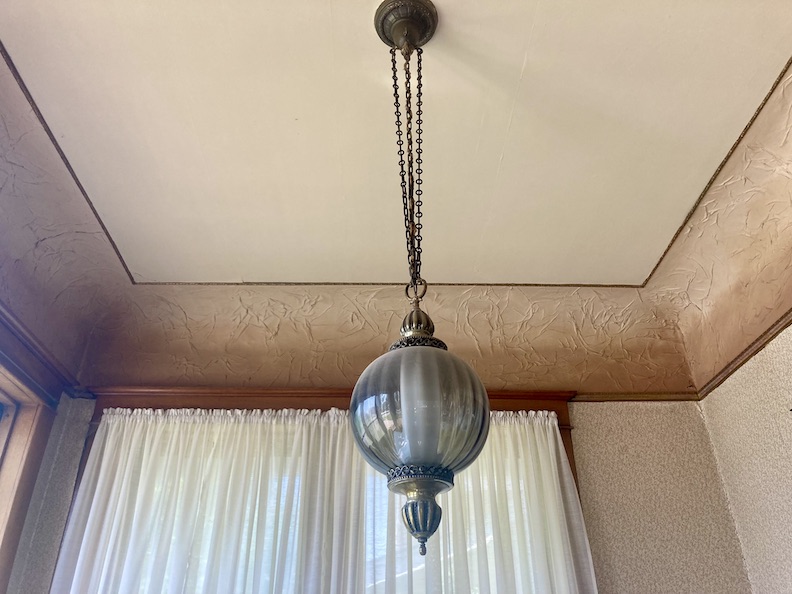
The entryway vestibule is outstanding. The coved ceiling, the large windows, the light fixture, the wall paper, the tiled floor. Truly breathtaking. Upon entering, the old-school craftsmanship captivates all who possess a pulse, and perhaps, will serve to revive even those who do not.
Amazingly, it’s almost all original inside.
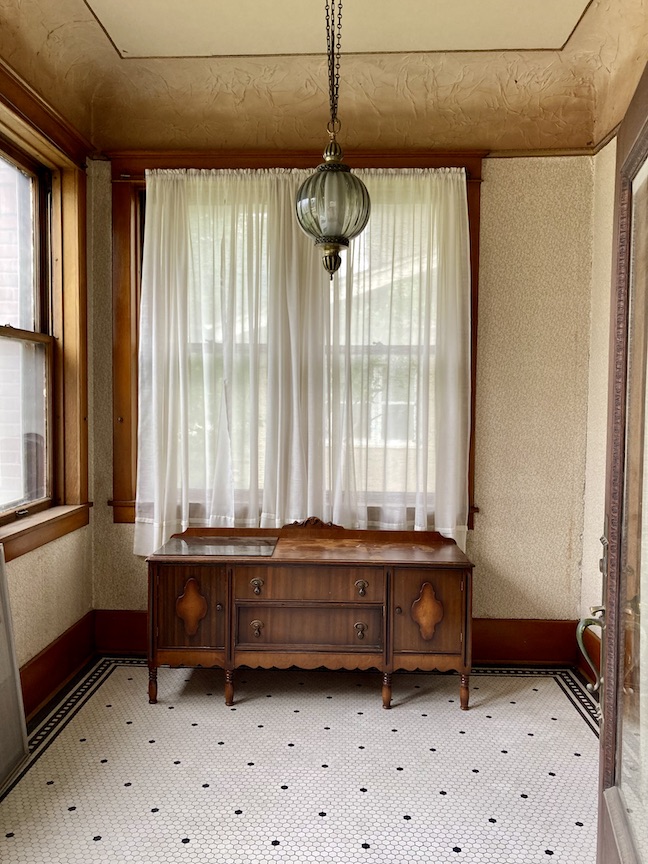
Expansive vestibule tilework with attractive border.

Ornate metallic foil coved ceiling with iridescent, artistic trim. Love the high quality wallpapers of the past. As I said aloud when I walked into the entryway, “I could be happy just living in this room.” I would like to operate my detective’s office from this space and still dream of all of the plants I could arrange in that bountiful entry.
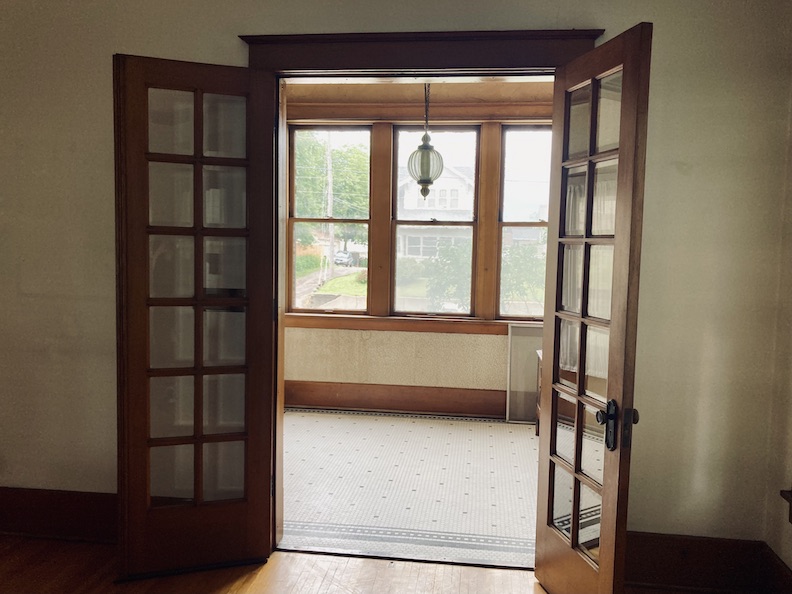
The generous vestibule leads into the parlor through these gorgeous oak French doors. There are fixtures on the door that hint at supports for a curtain rod at one time that hung across the threshold. This might have been used for shows (the Abbotts liked to employ black out curtains for better control over their shows) or perhaps for hanging sheers on days when one would want to let breezes in but not let everyone look into the house.
This next portion of the investigation is David Abbott’s own writing on 3316 Center. All of Abbott’s writing and his historic photographs were borrowed from House of Mystery: The Magic Science of David P. Abbott Volumes One and Two, edited by Teller and Todd Karr (2005). I will supplement with my current day photos, which will be obvious.
“I think it best first to include some photographs of the part of my home wherein I perform these mysteries, so that the reader may more fully grasp the descriptions and explanations of the various illusions when I describe them.
The house faces the street on its south. The end facing the street is 36 feet wide. Across its front, east and west, is my large parlor used for entertaining. It is 34 by 18 ½ feet in size.
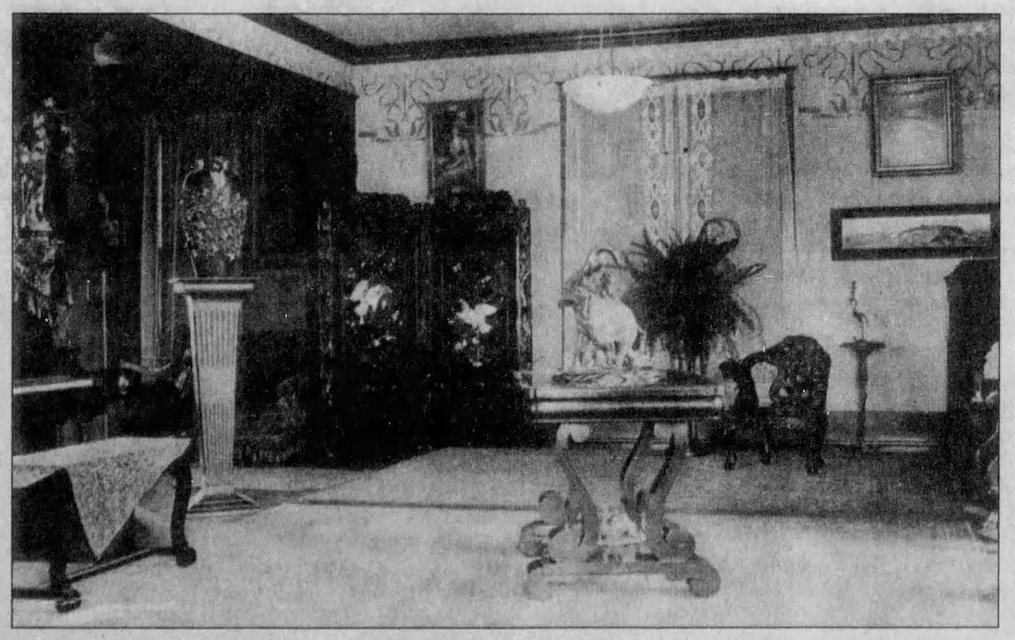
Eastern wall of the parlor. Beyond the vase and pedestal is David’s library. Three-to-four-hour shows, starting around midnight. It appeared he used black-out shades underneath the curtains to further control and create a specific dramatic environment. The chandeliers. Despite the Craftsman Bungalow house style, the Abbotts obviously did not buy into the Arts and Crafts movement. Eccentric, eclectic, worldly furnishings and exotic art pieces were arranged in a special presentation for “show.” This Abbott interior would have looked like a museum to most all who entered. I am reminded of favorite books The Opulent Interiors of the Gilded Age (not the Gilded Age tv show, no, no) or New York’s Fabulous Luxury Apartments.
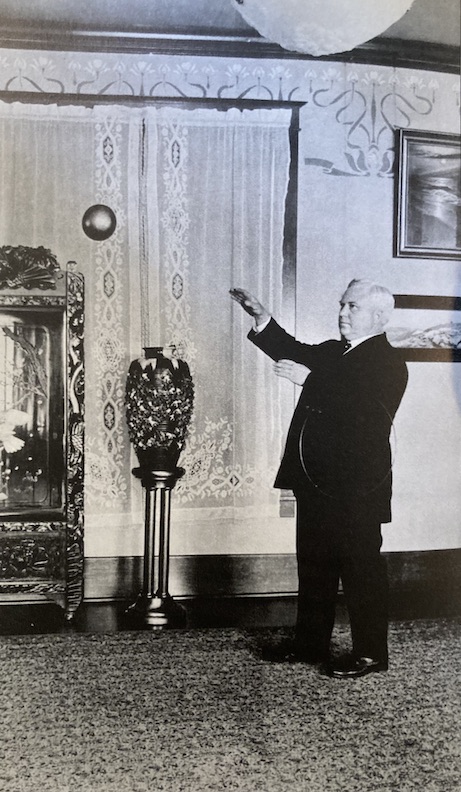
The same eastern wall of the parlor. David is doing his famous floating golden ball performance.
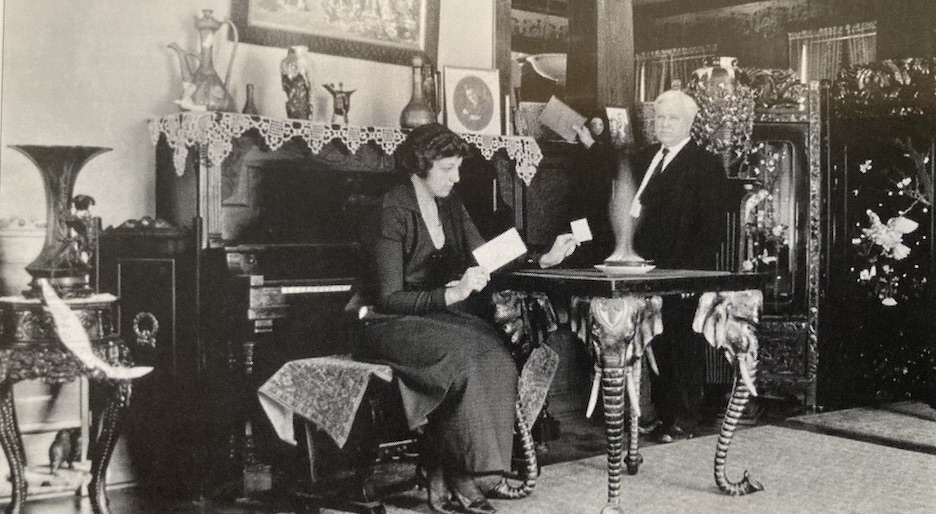
Northern wall of the parlor. David is seen with an unknown female participant, an interactive portion of the act. Beyond David is an Asian carved screens blocking off his library. The beautiful “Japanese Wonder Screen,” a gift from Harry Kellar that he had specially made for David Abbott, had a secret lock. It could be opened into three panels for shows. It was hand carved and featured inlaid pearl.
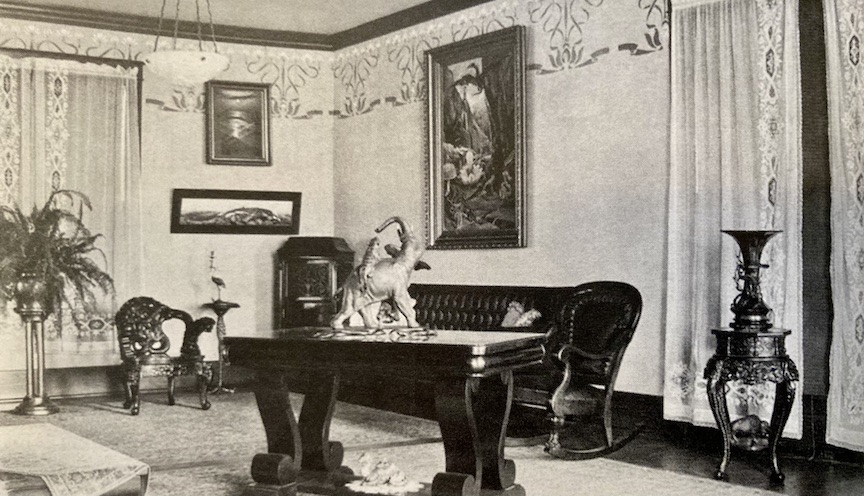
Southeastern corner of the parlor. Silk magnet wires. Sending and receiving coils on the floor, hidden under rugs and elsewhere. For a larger show, comfortable, easy chairs for his guests were brought out and arranged. And behind every strange hiding place were unknown bits of paraphernalia.
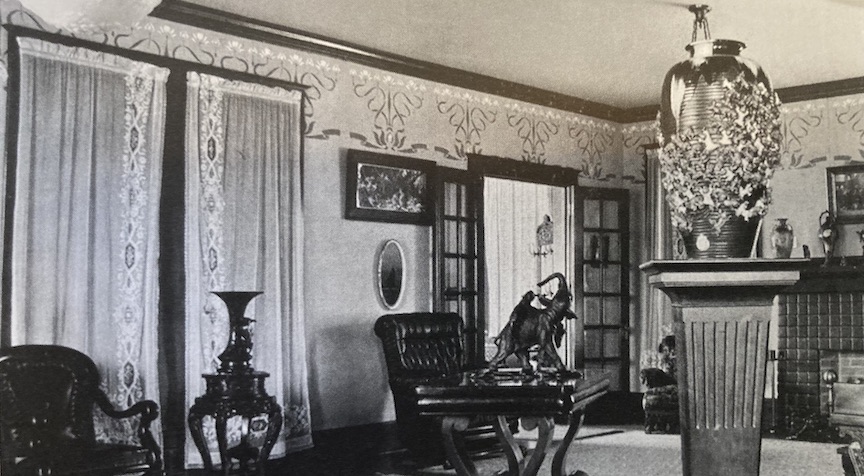
Southern wall of the parlor. That is the large window I showed earlier and the French doors at the entryway. Fireplace is on the western wall.
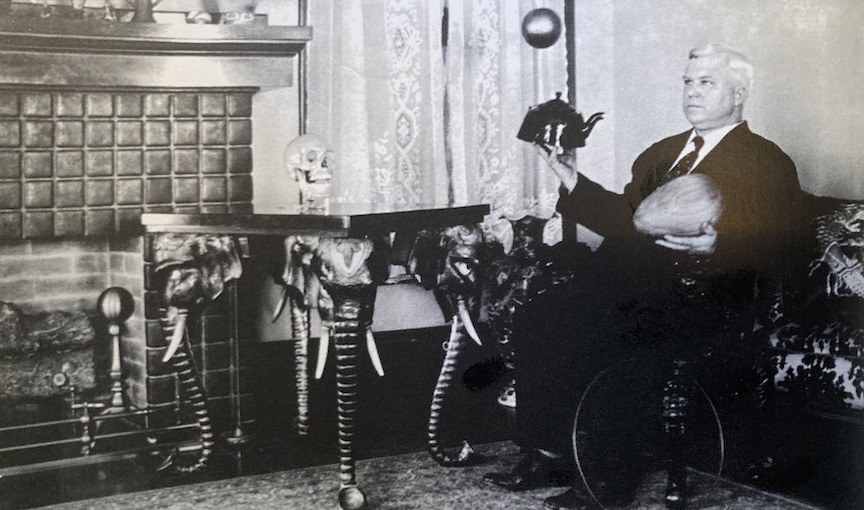
Western wall by the fireplace. David has the Talking Teakettle and the Floating Golden Ball, in addition to the Talking Skull. Pentaura (the Egyptian princess spirit living in the tea kettle) was a special feature that could whisper someone’s personal information to them. David’s skull that responded to inquiries by clicking its jaw. Magician Harry Kellar, after witnessing Abbott’s demonstration of the kettle, wrote to praise the device: “I consider your teakettle the most magical, the most wonderful illusion invented. … and for a House of Mystery, there is nothing to equal it.” Kellar was gifted a kettle by Abbott. One of David P. Abbott’s famous Talking Teakettles was featured in an auction, if you’d like more details. https://auctions.potterauctions.com/LotDetail.aspx?inventoryid=48601
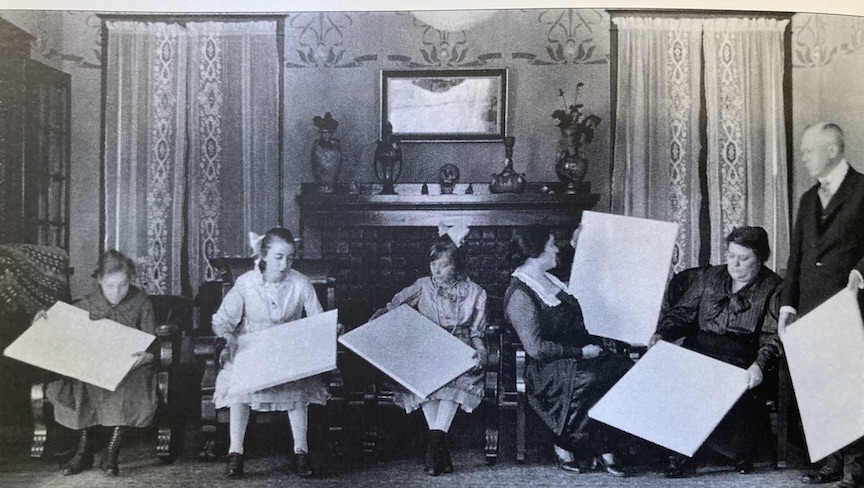
Western wall. Fannie is shown with unknown man and women, with a group of young girls. This was an interactive part of a performance.
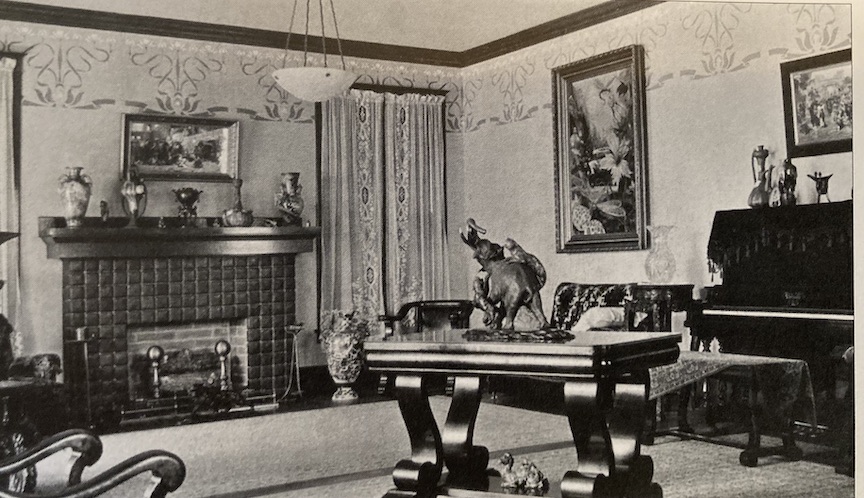
The northwestern angle of the parlor.

The large tiled fireplace anchors one end of the great parlor room. Just stunning to see where David Abbott sat and performed decades ago.
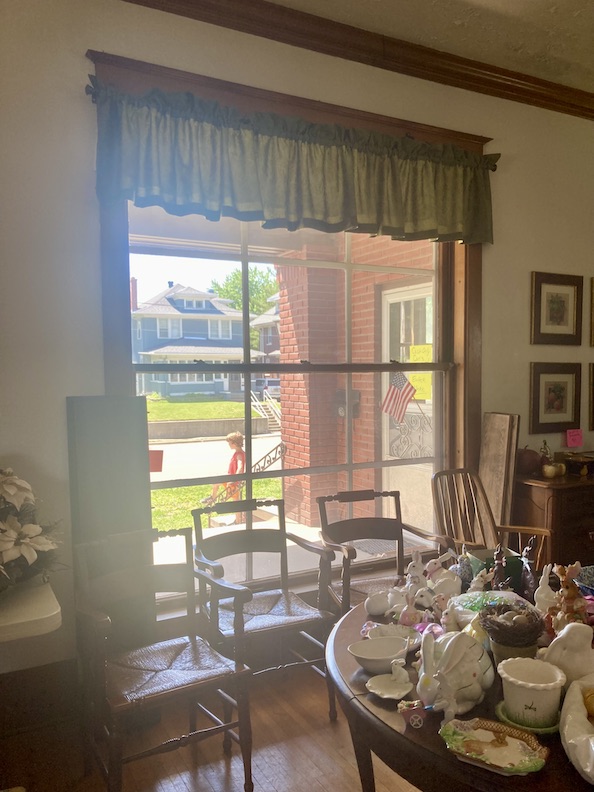
Same picture window from interior angle.
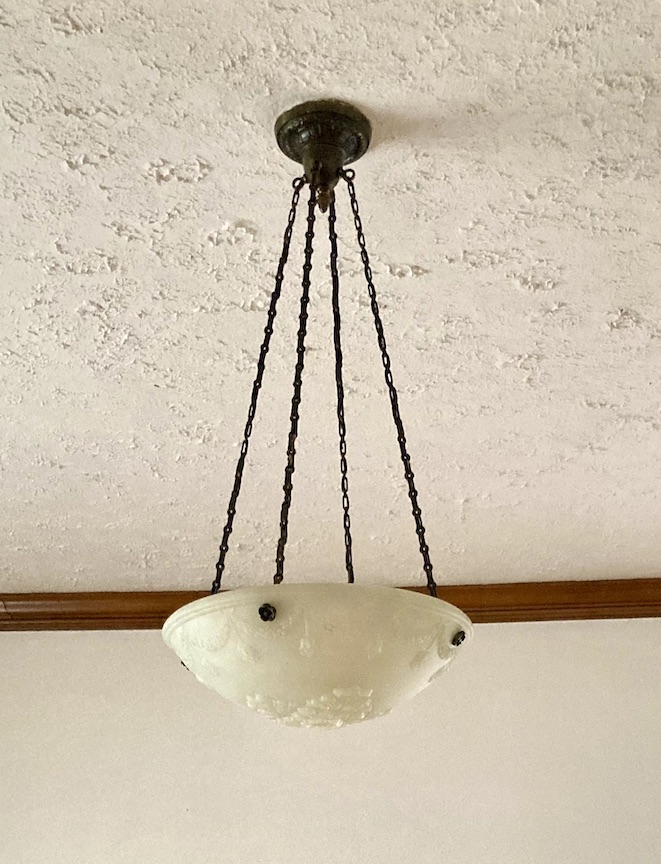
Wonderful, original hanging lights throughout.

Sending coils….are you under there?
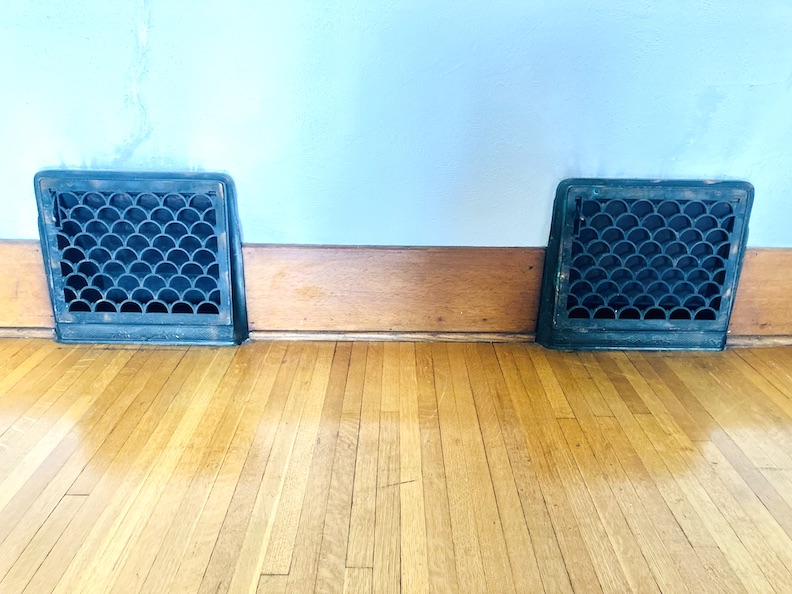
Ghostly voices through the vents or music. Lovely fish scale vents. This wall is truly eggshell colored but due to the time of day around 11:15ish AM, the walls look robin egg blue in this photo.

Angle from the library into the parlor.
“Opening north from the parlor’s east end is an archway between columns, into my library, and from this room—again on its north side—is another archway into my dining room. Thus, the open rooms are L-shaped, with no doors between, and in a way are like one big room. The distance north and south through the three rooms is fifty feet, but the parlor’s width is included in this amount. There are three nine by twelve rugs on the parlor floor and the guests are usually seated mostly on the west rug. I enter and do some performing on the east rug but frequently work from the middle rug and even among the guests. The following photographs show the four corners of the large room, and the view through to the north from the east end of it. I enter from the library with the various things to be used during the performance.”
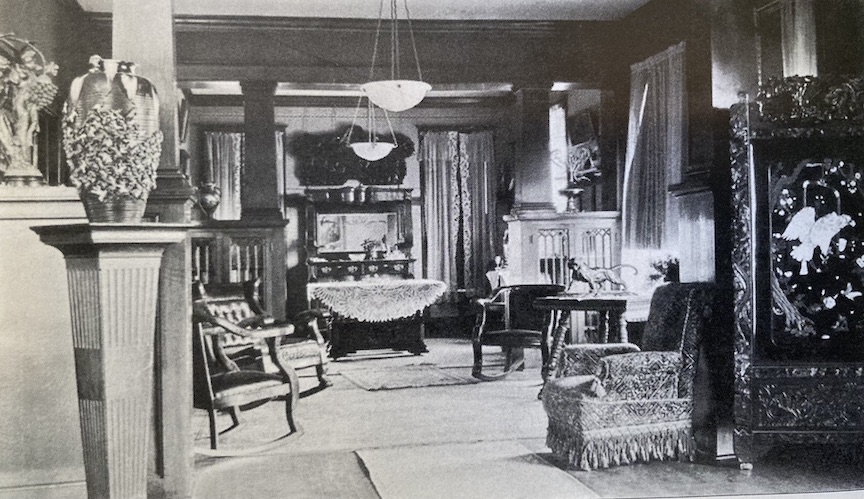
David’s historic photo facing north, from parlor, through library into dining room. Glory Be.
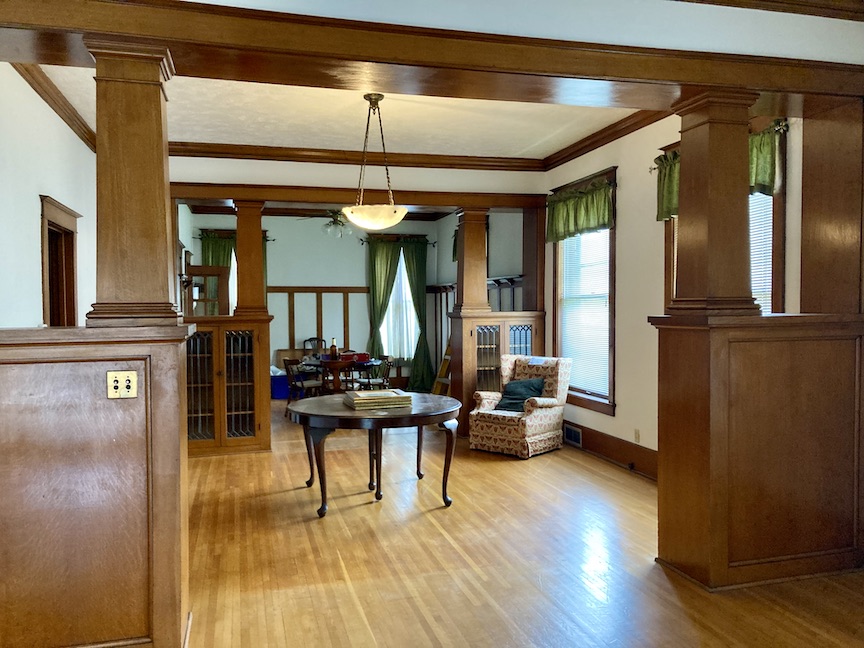
My reenactment. One may notice the dining room light in the far north distance is now a ceiling fan. The Schrat family report they have the original light for the new owners but they had found this ceiling fan more functional for them.
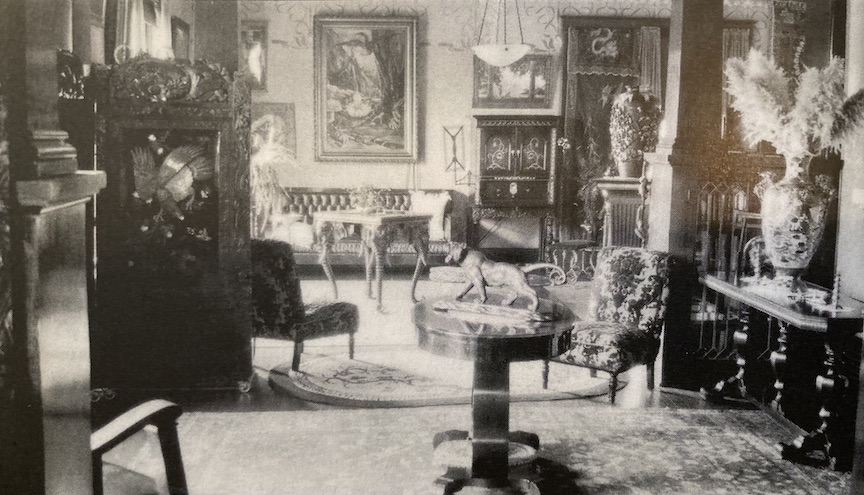
David’s incredible photo taken in the library, facing south into the parlor. I am amazed that through thoughtful planning by design, the couple was able to maximize their space with creative, interchangeable solutions. Obviously they had accumulated a good deal of decor and ornate furnishings. Somehow everything flowed and looked sumptuous while breathable.
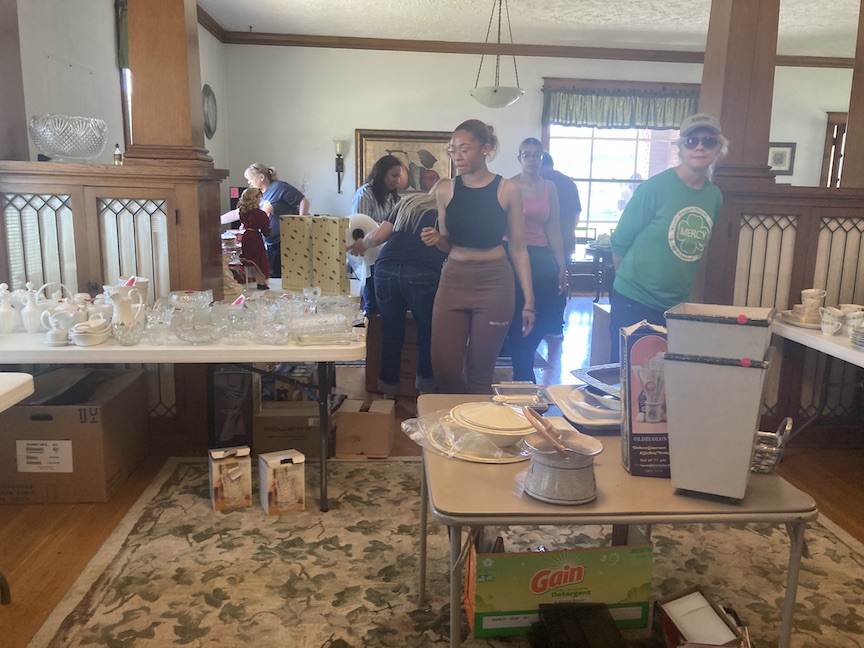
My replica from the estate sale, taken in the library, facing south into the parlor.
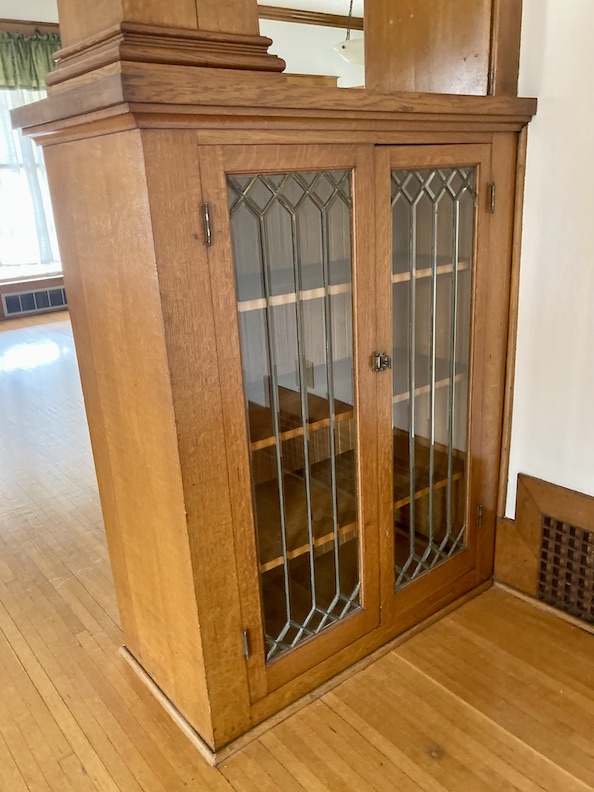
The library bookcases are heavenly, featuring leaded glass door.
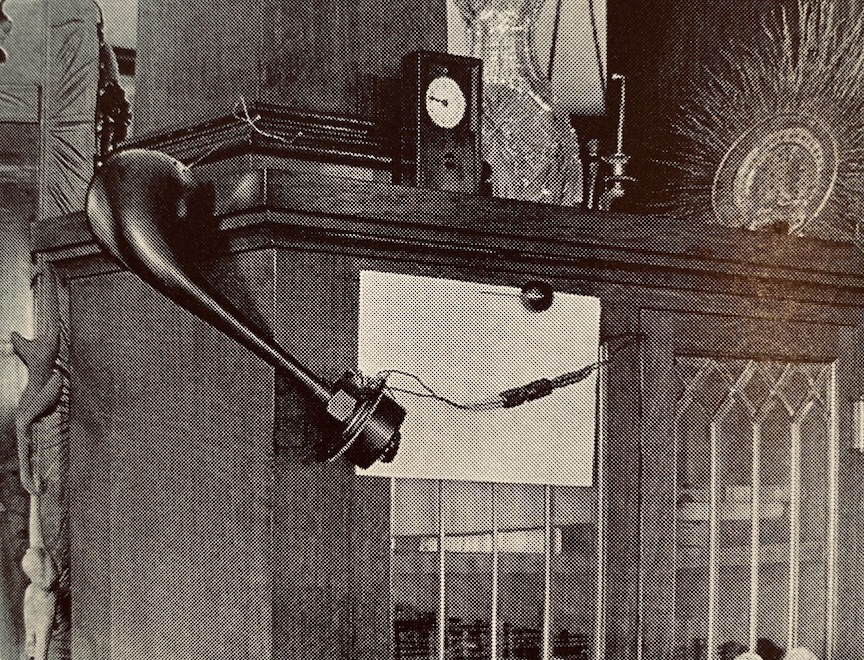
One of David Abbott’s photos from his book specifies the rigging devices. From a loud-speaking apparatus “sending system” as rigged off the parlor using the tiniest of hooks and wires. Abbott’s “Voice from the Vase” trick mentioned “the effect of Pentaura (the Egyptian princess spirit living in the tea kettle) talking out audibly, apparently from the vase, is brought about as followed: I connected an extra wire to each floor plate’s wire under the floor and led them up through the floor into my bookcase in my library. I have a second loud speaking receiver and horn for this effect. I suspend it from the column.”
The Schrat family report Mr. Abbott’s secret wiring has all been removed from the house but many of the tiny hooks remain in place.
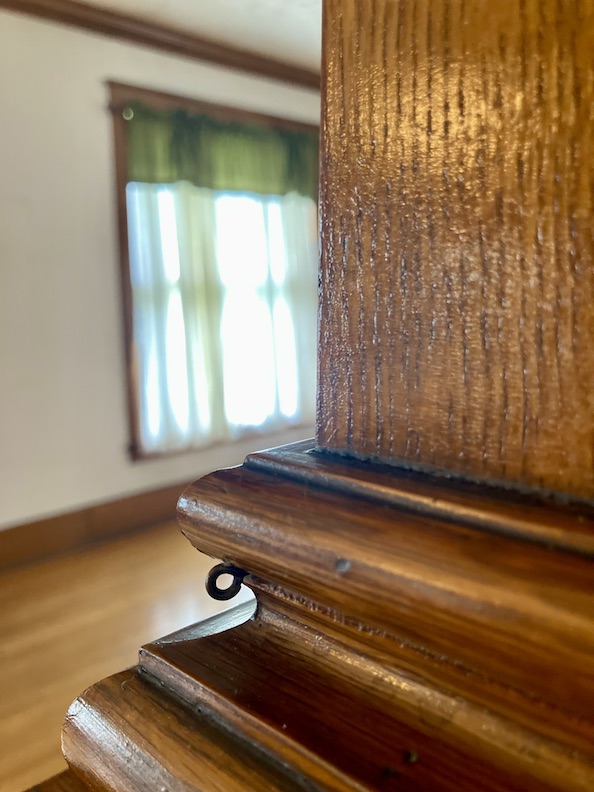
Here is one such magical hook used by David Abbott, specifically in the trick wiring of the above black and white photo. The Schrat family told me the woodwork along the ceiling of the front room was kitted out with hooks for the tricks and rigging of the late night shows.
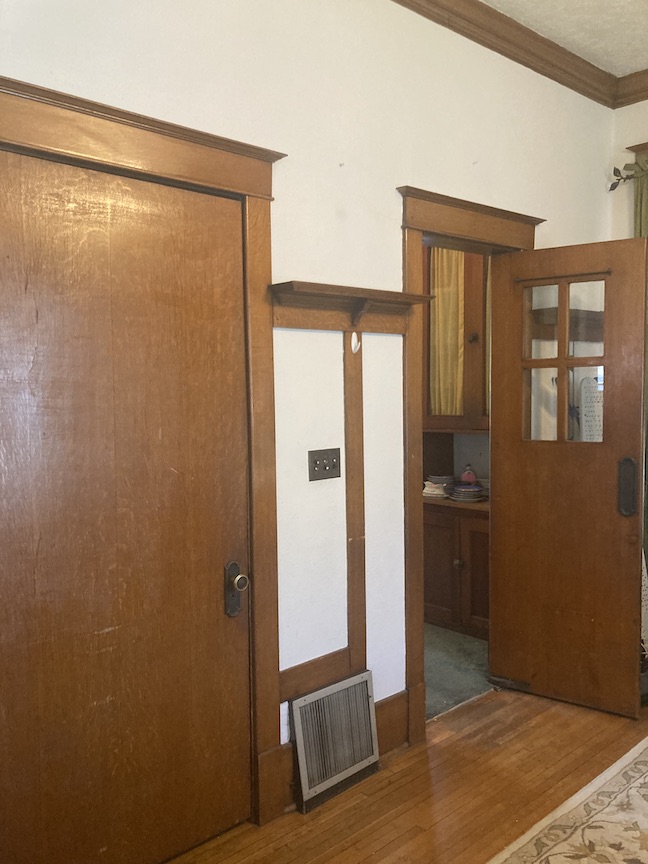
These two doors are in the far north, dining room. One door leads to the pantry and one, to the stairwell. The floor plan is everything that can be desired. Large, adjoining rooms. Formal dining room with plate rails. Between the dining room and kitchen, the pantry is conveniently located.

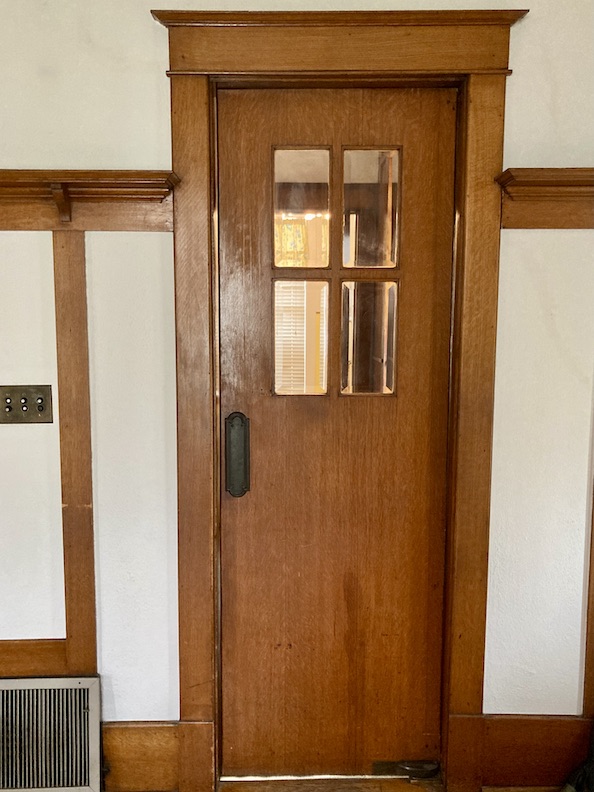
Pantry door opened and closed.
Turns out, there was at least one additional hidden assistant beyond Fannie. A man wore a black mask and in stocking feet lurked in the kitchen through the dark gauze curtain and watched through the glass panes of this very pantry door. He gives hint to “the sending station.” The operator signaled and Mrs. Abbot “heard” in her ear. They also made use of a Dictograph later. “The assistant in the dressing room must hear everything on the stage over the Dictograph.” Magician Teller also speculated Mrs. Abbott hid in the pantry or the fruit cellar when “broadcasting the teakettle’s voice.”

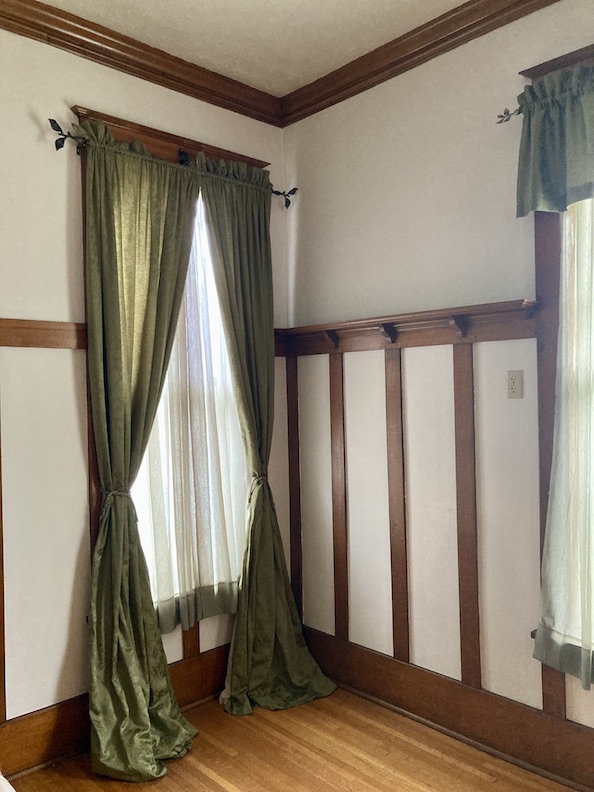
The dining room was north of the library and very often was closed off to guests. But there is evidence, as with the pantry door trick, that later shows also utilized this private dining room space.
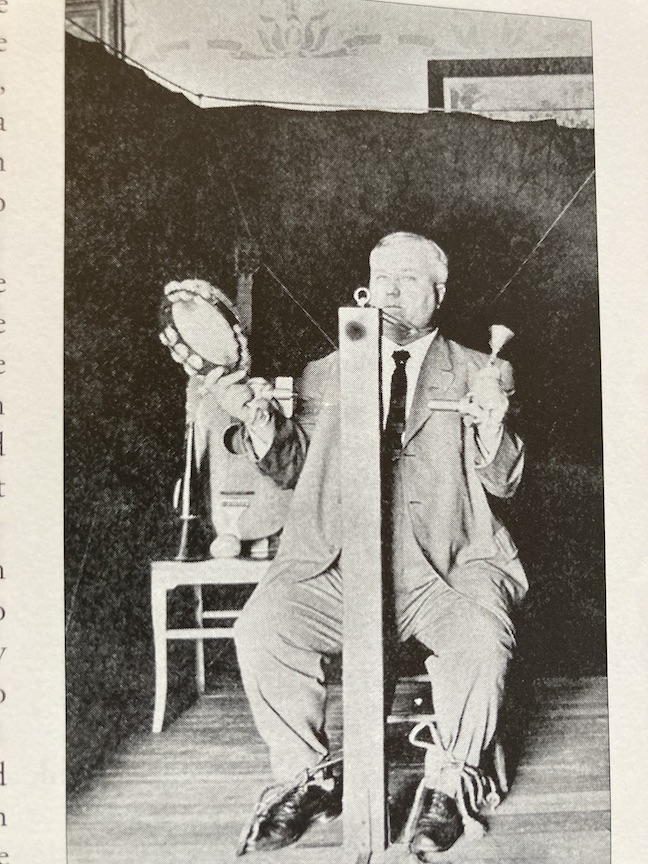
One can easily see in this performance that a black curtain was wired across the room. Behind it the stenciled parlor and the artwork on the walls. If this curtains looked sloppy, that was most likely a disconcerting trick. A ruse.
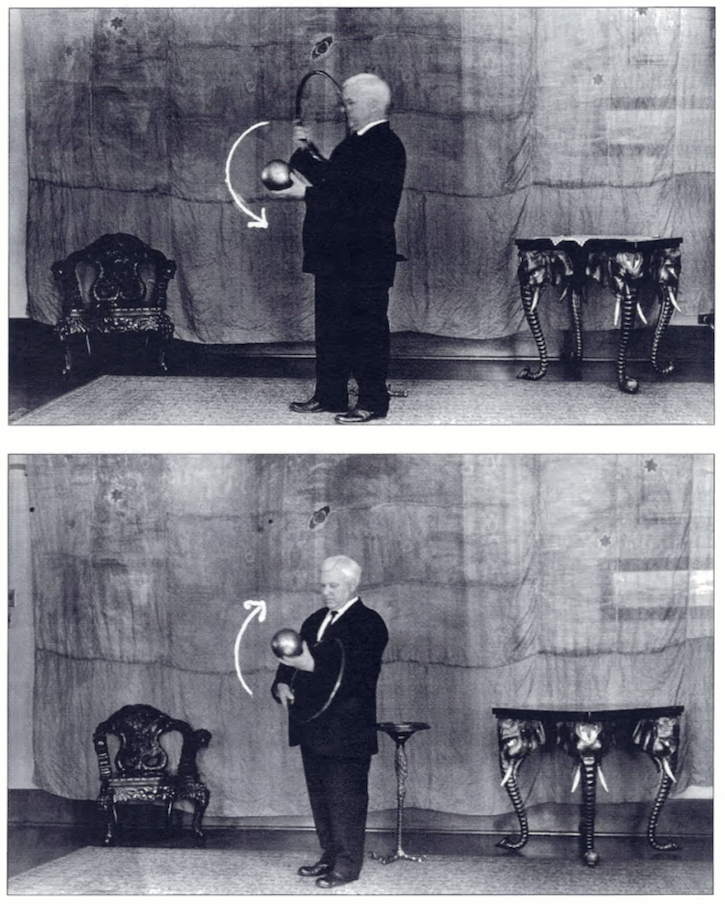
David Abbott also made use of an eighteen-foot soft silk curtain displaying “a night sky scene with the moon, the stars, Saturn and its rings.” It also incorporated tiny silk wires and threads. From photographs it appears he would hang this curtain on the eastern wall of the parlor or wherever he needed a backdrop that doubled to hide the underpinnings of his tricks. Here he is demonstrating the Floating Ball trick, a trick that eventually became associated with Tobias Bamberg (1875–1963), a professional magician who performed under the name Okito.
Beyond Mr. Abbott’s library to the west is a bedroom on the first floor. It has a proper closet, configured perfecting into the house, suggesting that it was built as the Abbotts’ bedroom or a bedroom, not just a sitting room. It has a room within it that I believe was Abbott’s special laboratory.
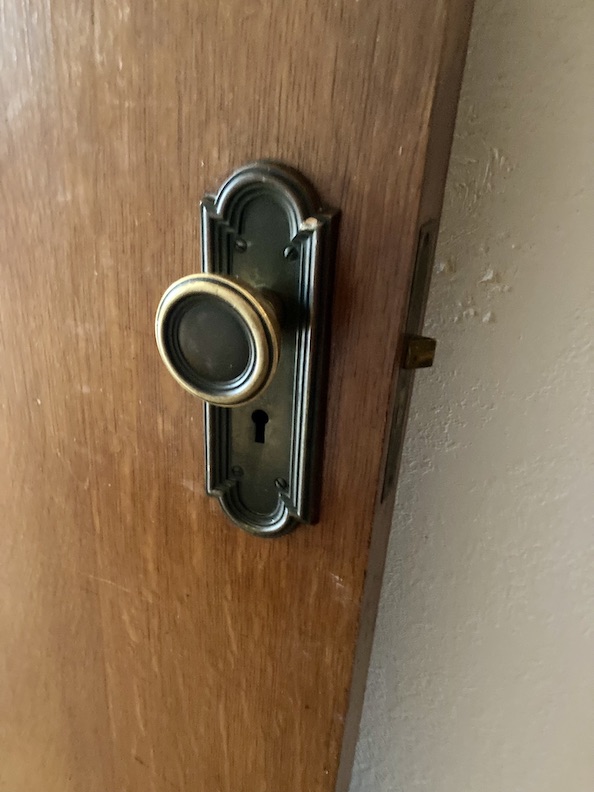
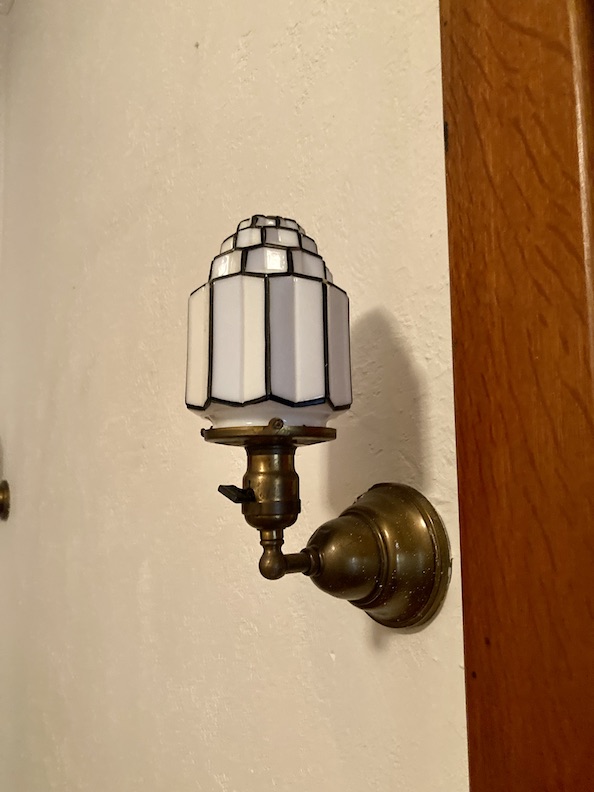
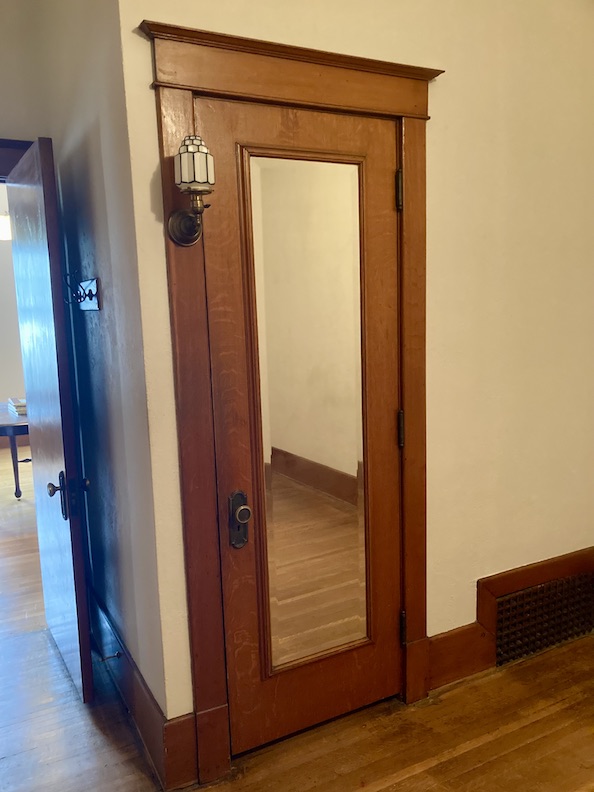
The formal closet is very large. It has a wonderful white glass, trimmed in black, and brass sconce on the door frame. I’ve never seen anything like that. It was part of a trio.
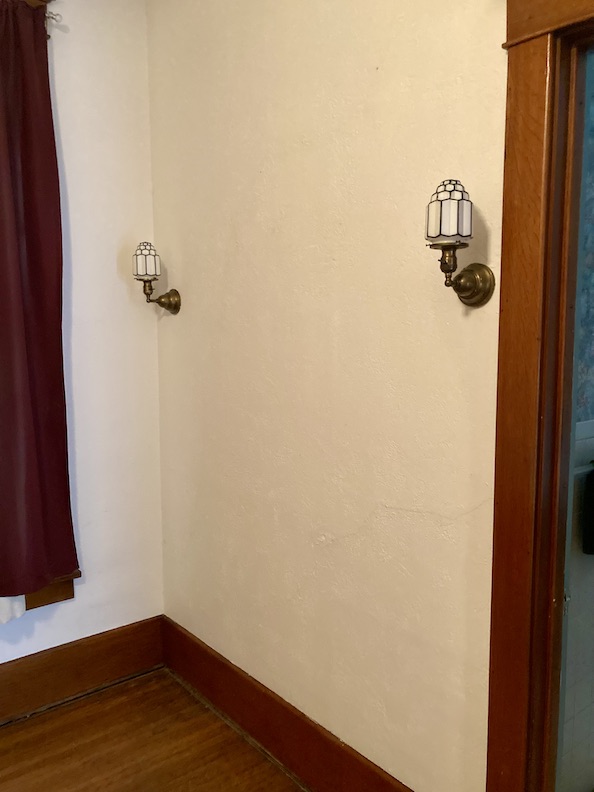
The other two were on the wall of the same room, as if they would have flanked a desk.
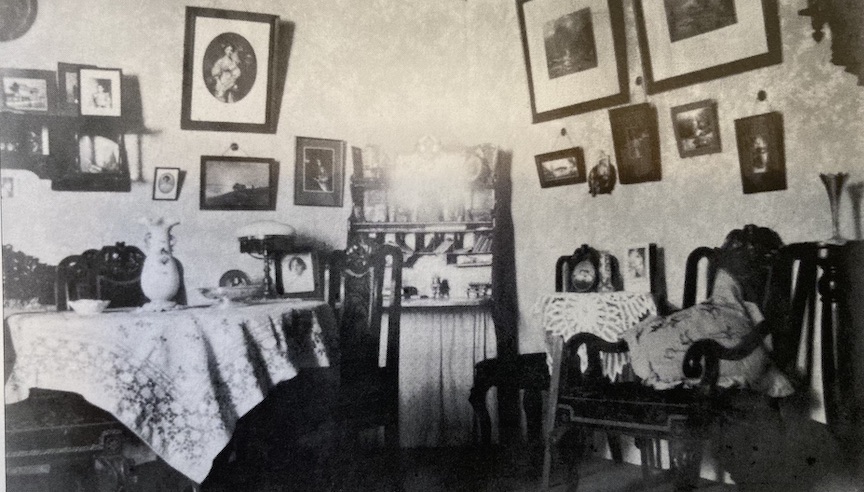
David Abbott labeled this black and white photo “View of my room” in his manuscript. Presumably this is a photo of his personal room, not necessarily a sleeping room. It is possible that the main floor bedroom was used as “his room,” lending additional space for his laboratory.
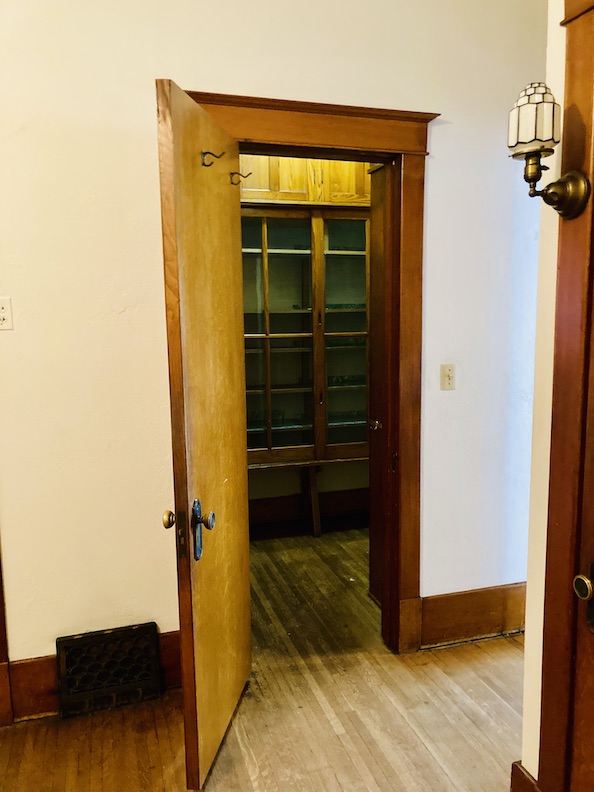
…and the interior room, believed to be Abbott’s laboratory.
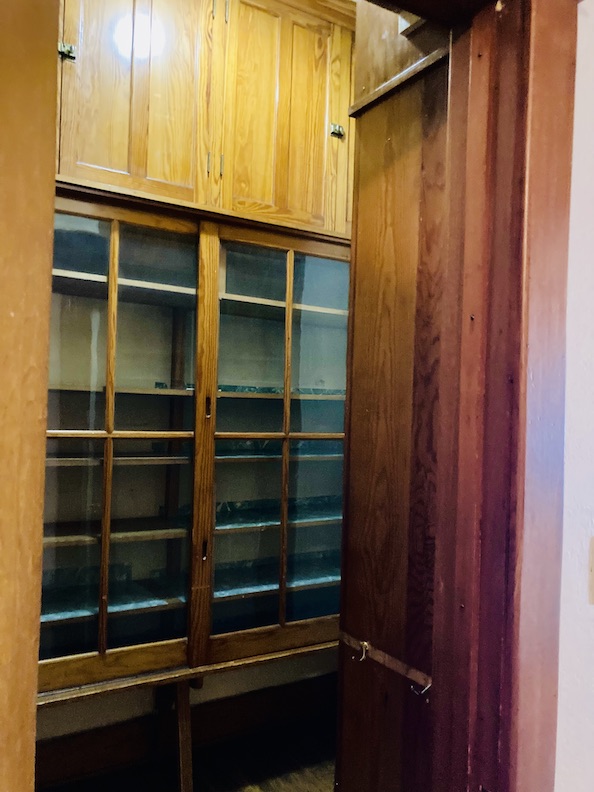
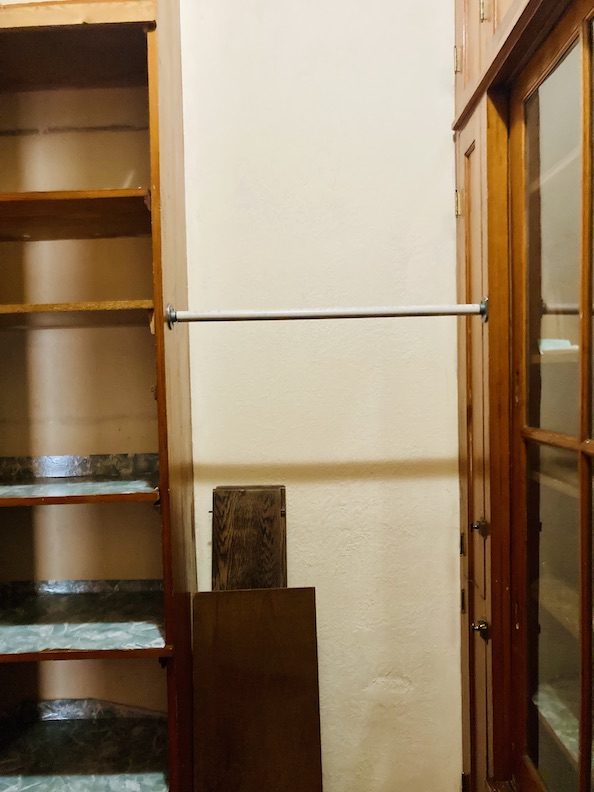
Omaha Morning Bee News article described Mr. Abbott’s architectural plans for a room in which was stored “his paraphernalia for deception.” This room would later be called his “laboratory,” for his psychical research, containing all testing equipment used by “fake mediums for creating illusions” as well as creation of his own devices. Magician Teller stated, “The inner closet where Abbott once stored his props behind sliding glass doors is beautifully intact, except that it now houses sweaters and socks in place of skulls and teakettles.” From this I’ve assumed Abbott’s lab was most likely this room within Mr. and Mrs. Schrat’s bedroom.
Of interest–this last photo depicts a solid wall with a clothes rod between cabinets. This space is where a window once was. When the Schrats moved in, there was a window between the laboratory and the first floor bathroom. The bathroom can only be entered from the bedroom, through the library. This is an interesting puzzler. Because of the typical layout of a home from this time period, it would be normal for there not be a bathroom on the first floor. If so what was in that once bathroom space? It would also have been normal to have to passed through a number of rooms, even private rooms, to get to the bathroom back in this time period. The window between the library and bathroom/previous room is the real head scratcher.
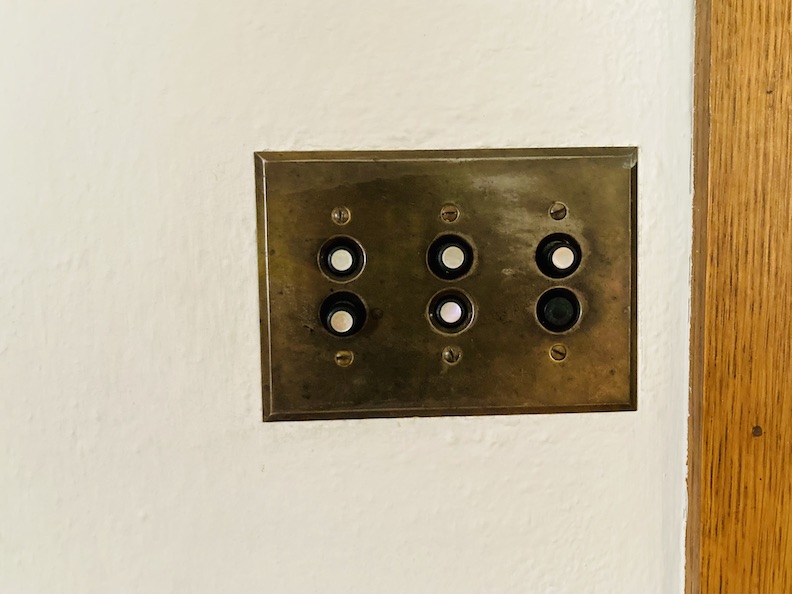
Other things that give me thrills: Brass-push-button-light-switches and mudroom transom windows. Thank you, The Past.
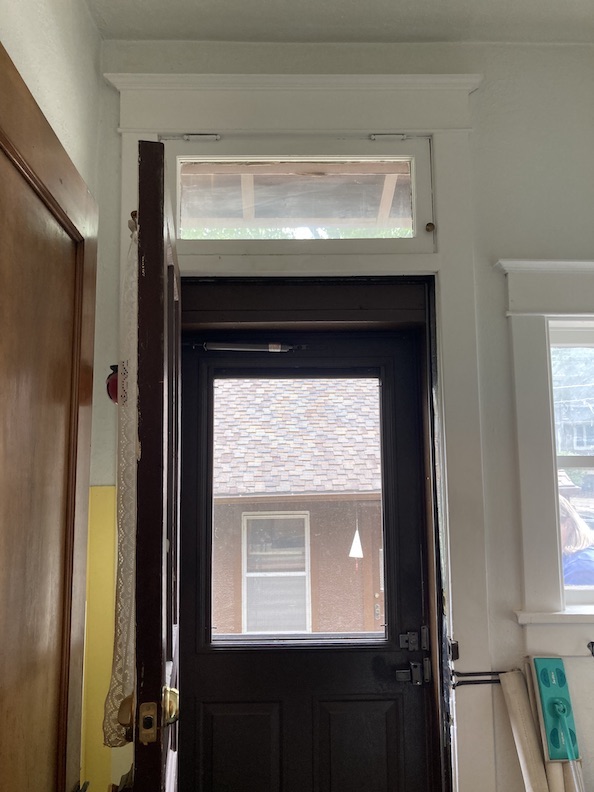
And while we’re here, let’s poke around upstairs. The stairwell door is in the dining room.
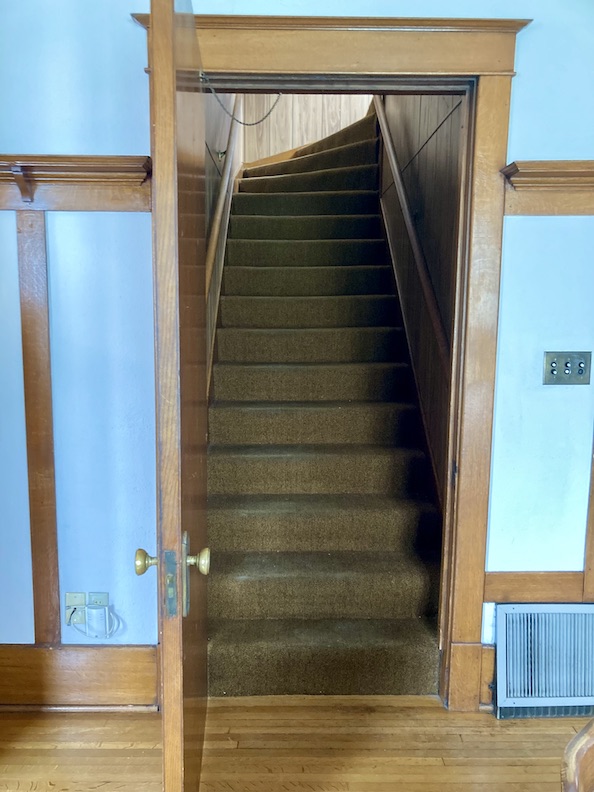
This wall is truly eggshell colored but due to the time of day around 11:20ish AM, the walls look robin egg blue in this photo. Strange occurrence but most likely because of the sun’s blueness at that time.
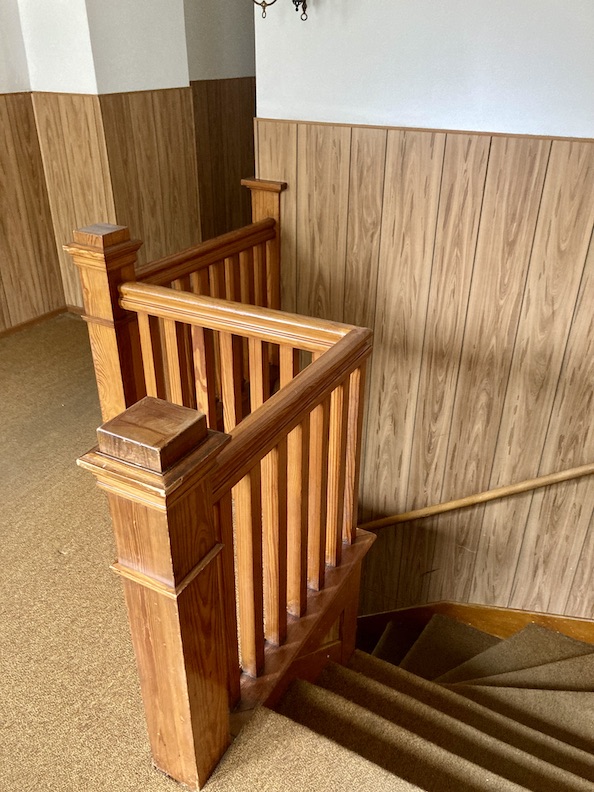

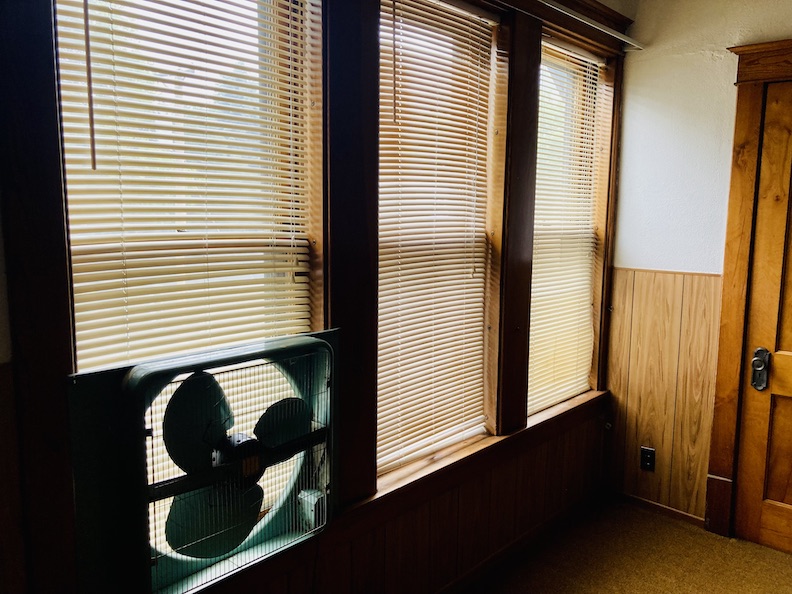
On the second floor we have three very large bedrooms, complete with large closets. There is a good-sized, long hall running down the middle and a large bathroom with “linen boxes.”
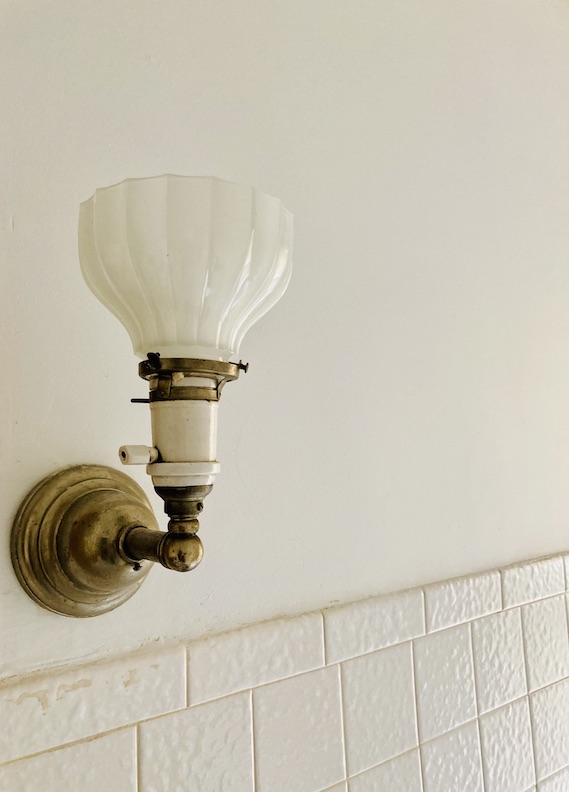
Bathroom brass and white glass sconce.
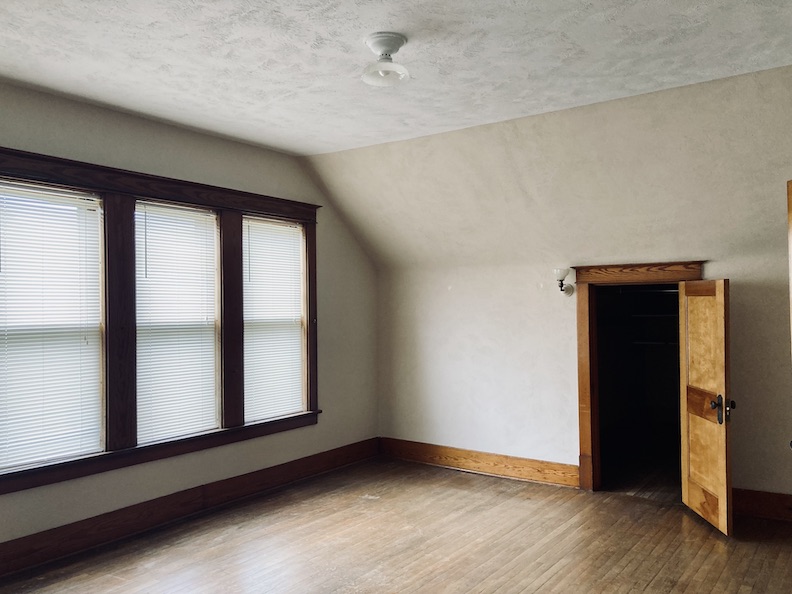
East bedroom.
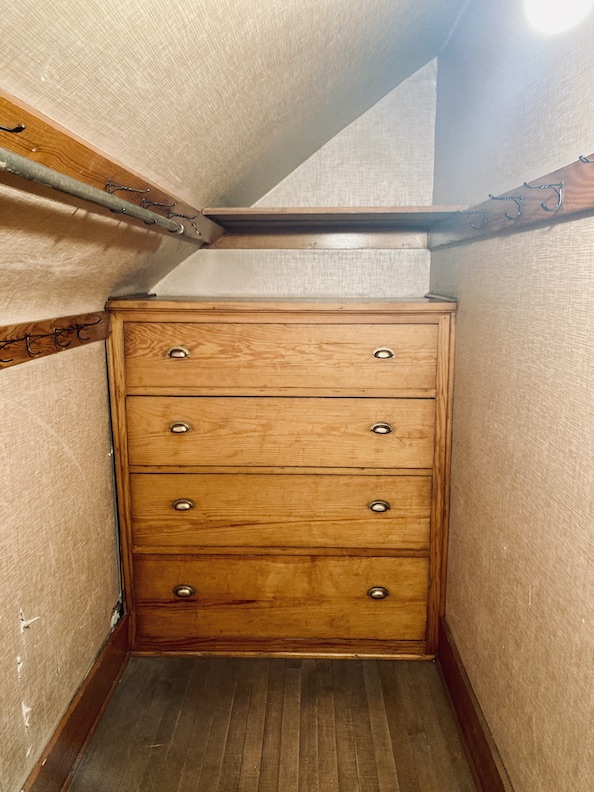
Dreamy built ins.
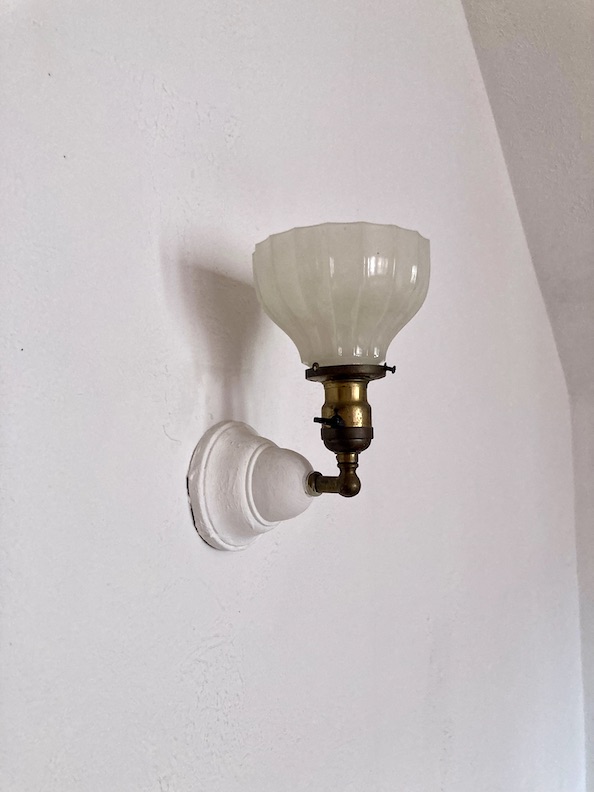
Another bedroom sconce.
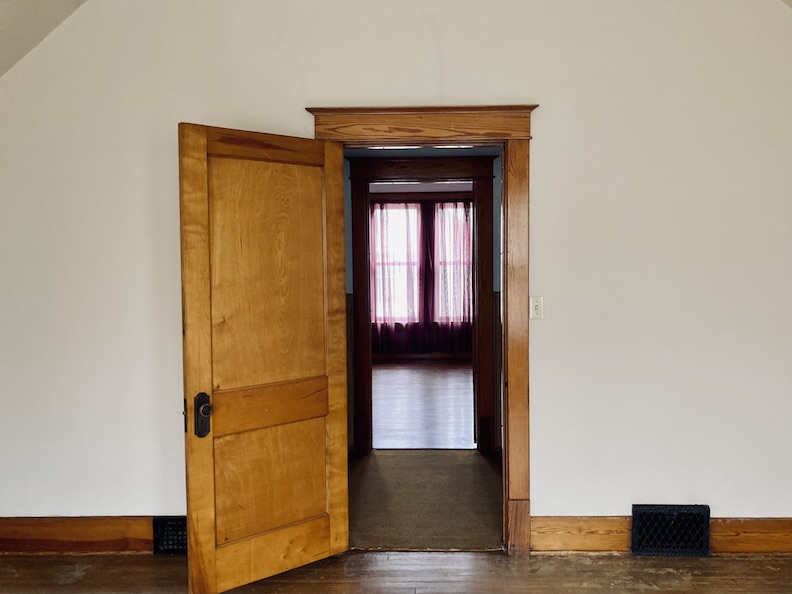
View from east bedroom across the hall to the west bedroom.
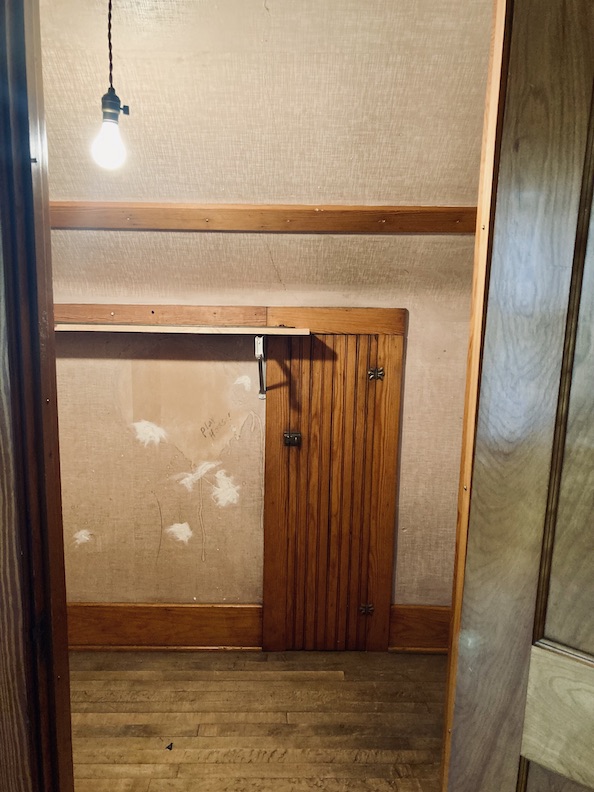
More hidden crawlspaces. This one reads “playhouse” next to the tiny door.
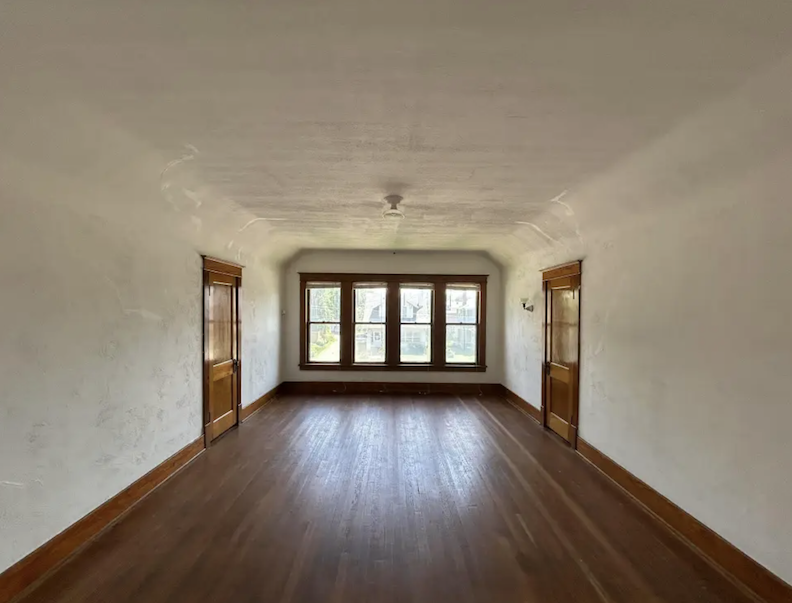
Two huge closets in the large bedroom that faces Center Street.
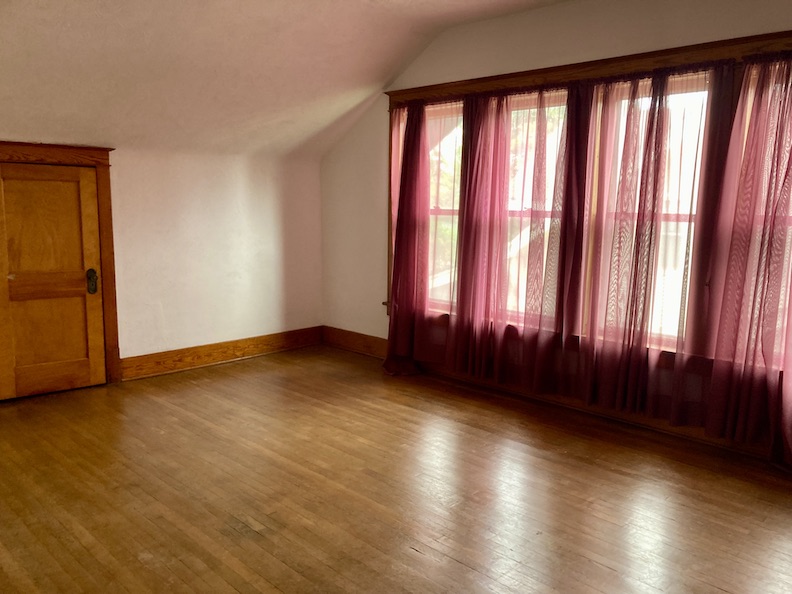
West bedroom.
“MYSTERY IN THE AIR” THEME…FADE UNDER TO BACKGROUND
CURTAIN DOWN
(APPLAUSE)
And now we must interrupt tonight’s investigation for a word from our sponsor. (Good time to refresh a snack or drink!)
Mr. Cross: “Each week, the makers of Camel cigarettes send free Camels to servicemember’s hospitals from coast to coast. This week the Camels go to Veterans’ Hospital, Northampton, Massachusetts…U.S. AAF Station Hospital, Boca Raton Field, Florida…U.S. Naval Hospital, Bremerton, Washington…U.S. Marine Hospital, Galveston, Texas….and Veterans’ Hospital, Augusta, Georgia.”
Mr. Chandler: “According to a nationwide survey, more doctors smoke Camels than any other cigarette.”
Mr. Anderson: “One hundred thirteen thousand, five hundred and ninety-seven doctors — living in every state in America — were questioned by three leading independent research organizations. ‘What cigarette do you smoke, Doctor?’ was asked. The brand named most was Camel.”
MUSIC
Mr. Cross: “Next week, ‘Mystery in the Air’, starring Mr. Peter Lorre, brings you ‘Beyond Good and Evil’ by Ben Hecht, with a special musical score composed and conducted by Paul Baron.
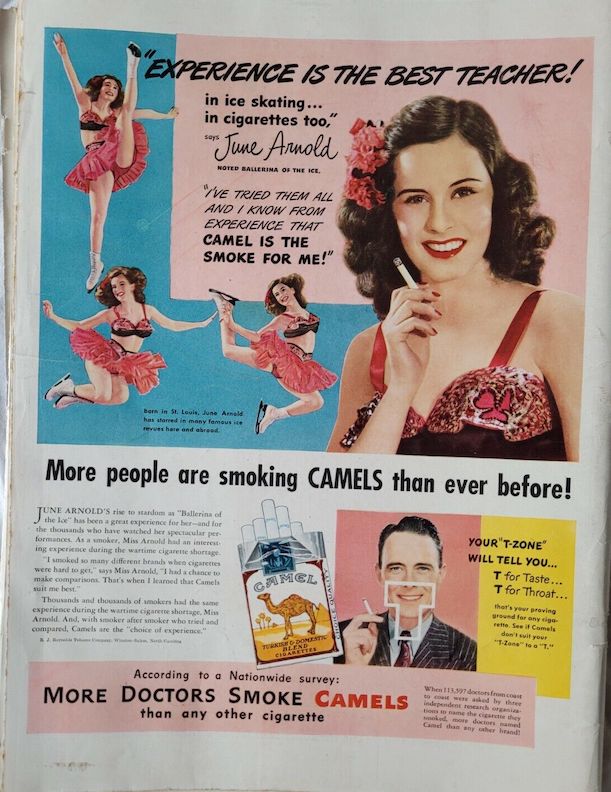
1947 Camel print ad.
CURTAIN UP
(APPLAUSE)
Notorious!
The Abbotts were moved in and their House of Mystery began to win notoriety as site of late-night “Unusual Entertainment.” Mr. and Mrs. Abbott gave an interesting program in honor of Mr. R. E. Yocum and Mr. John Shipner at which thirty guests were present. Now that we have assessed the 3316 Center Street photographs, imagine thirty guests watching the performance. There was so much room. “Mr. Abbott gave his seances in spiritualism, slate writing, card tricks and other stunts, with music on several instruments.” One of the first articles I found after their move into the new house was an expose on the secrets of the spirit portraits, which Abbott noted had challenged detection for several years. Phosphorescent paint was used to create “materialisms.” The Omaha Daily Bee touted Abbott as the “Exposer of Fakes” after 30 years of insider experience. After all the years, David continued to be bothered by those tricking the public. By his writing, he didn’t even like to use the word trick when describing step by step how to perform.
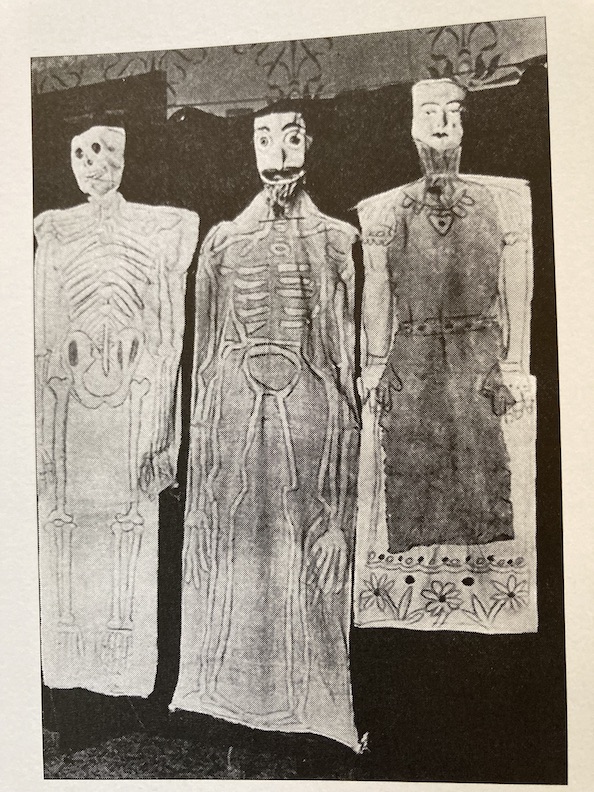
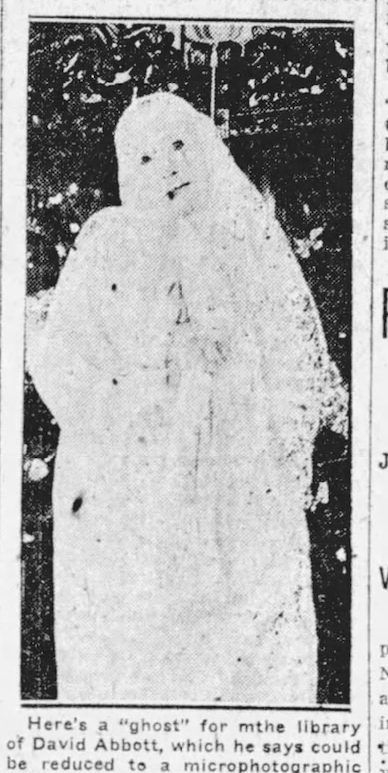
Left: Spirit portraits hanging in the parlor of 3316 Center Street. David Abbott completed yet another book in 1913 called, The Spirit Portrait Mystery: Its Final Solution. Right: 1923. Evening World Herald: “Here’s a ghost from the library of David Abbott, which he says could be reduced to a microphotographic plate and by trick photography superimposed on any ordinary picture. ‘Just a case of trick photography,’ said David Abbott, student of the occult, 3316 Center Street commenting on the so-called ‘spirit pictures.’”
At this time brothers George and David Abbott worked together at People’s Loan Company, focused on “real estate and loans” in the 5 Patterson Block in downtown Omaha. I smiled to find David P. Abbott described as “an unassuming businessman, with an office in the Patterson building. Looks for all the world like a banker.” That was one of his better tricks.
Frankly, from what I could piece together, David had always loved the unusual. Does that make one unusual? He came to own a sword found 35 miles northwest of McCook in 1885 and was supposed to have been left in Nebraska by Coronado in his expedition of the 1500s. “The sword was found on the banks of a river and there were other evidences of the presence of foreigners.” The belief was that Coronado had discovered Nebraska.
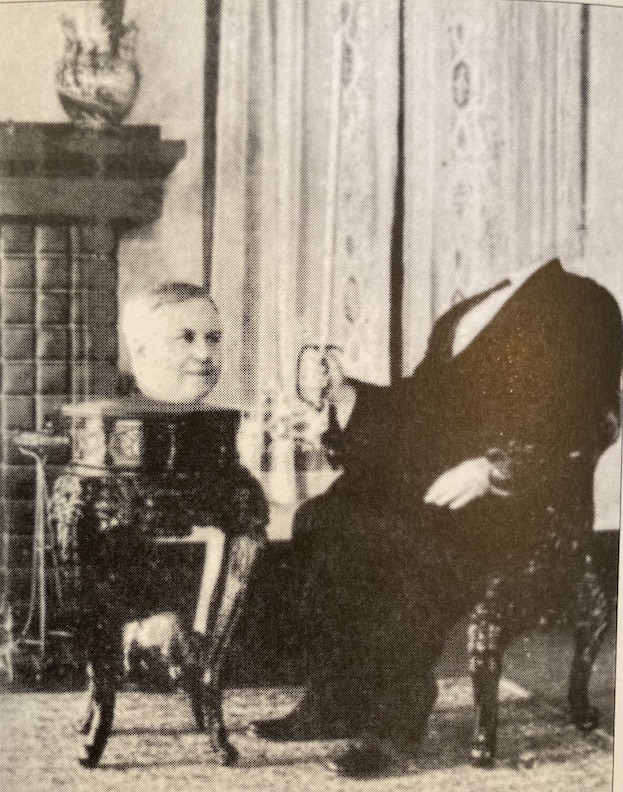
In David’s Self Decapitation routine a sword was featured. Is this the Spanish sword of Coronado in David’s hand?
His mind and his wit enchanted to me. He was funny. Some of his cast of characters, in addition to 3316 Center, was the “Spirit Brush of Rembrandt,” Mr. Abbott’s pet painter. “Buttermilk Bill” was a materializing spirit. His skeleton pranced and danced about the room at shows. “Pantora” was spirit in the monkey vase and in the teakettle. “Joseph Balsamo,” immortalized by Dumas, and immortal under the name of, “Count Cagliostro” inhabited the human skull. Three clicks for “yes” and two clicks for “no.” I loved every name and every story.
And on a cold Thursday night, on December 28, 1918, the Omaha Daily News reported another Bizarre Gathering at the Abbotts:
“Thursday brought a night in wonderland for a dozen or so actors playing last week in the Orpheum Theatre. After the performance at the invitation of Will Bland, an Australian magician, one of the features on the bill at Billy Byrne’s playhouse, a select company went to the home of Omaha’s own wonder-worker, David P. Abbott, 3316 Center Street. They arrived about 11:30pm and from that hour until 3 o’clock next morning, one marvel after another unrolled itself before their eyes, under their very hands, in their ears, until the air seemed alive with spirits and elementals and little imps.
Weird paintings of Masonic beasts and gigantic curiously formed and colored flowers, like H. P. Wells’ Martian fauna and flora are on the walls of the Abbott home. Queer Oriental drapers, strange bits of furniture—an ebony table, supported by huge elephant heads, their trunks forming the legs of the table; a marvelous Japanese screen that played an important part in the doings. A great Hindu vase with a thousand monkeys scampering over its side—a deep midnight blue sky curtain drawn over one end of the big room, with crescent moon, Saturn and his rings, Jupiter and other luminaries of night emblazoned on its face—these things gave one a sensation of strangeness and prepared on in a way for the wonders to follow.”
The Unseen Hand, Brief Notes on Fannie
“Indeed, there are many among the Abbotts’ old friends who feel that Mrs. Abbott played an important unseen hand behind many of her husband’s most baffling illusions. (…) While it was Mr. Abbott who invented and showed the tricks, there were those who always kept a skeptical eye on Mrs. Abbott.” Fannie Abbott was an intelligent coconspirator and like many of the great magic assistants of the ages, her work looked simple. She was often the eyes and ears of the operation, picking up the spontaneous subtleties of the audience.
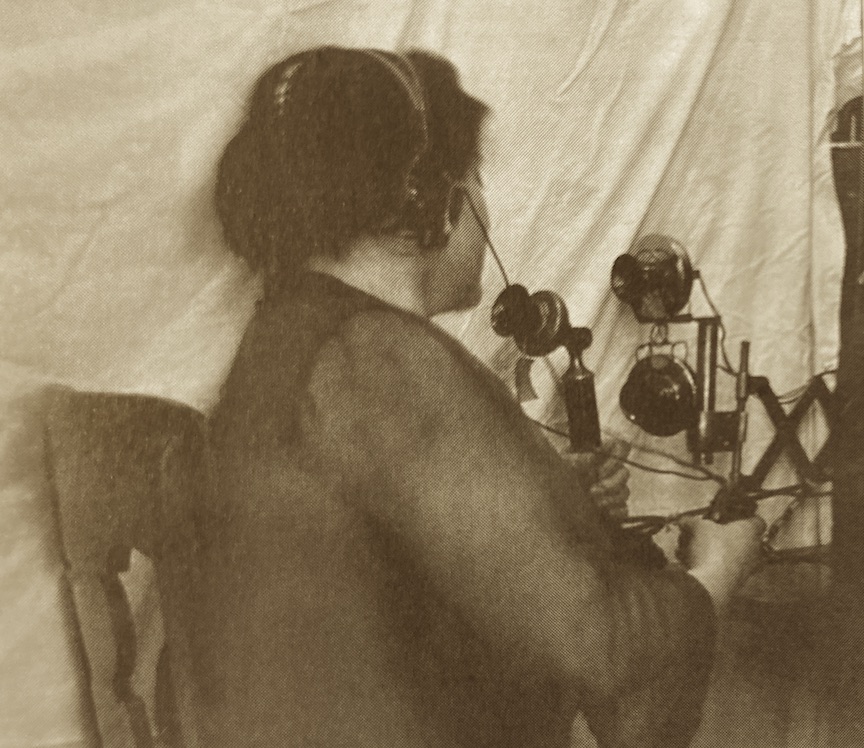
Pay no attention to that man behind the curtain. I’d sure like to talk to the True Insider, Miss Fannie. Photograph borrowed from House of Mystery: The Magic Science of David P. Abbott Volumes One and Two edited by Teller and Todd Karr (2005).
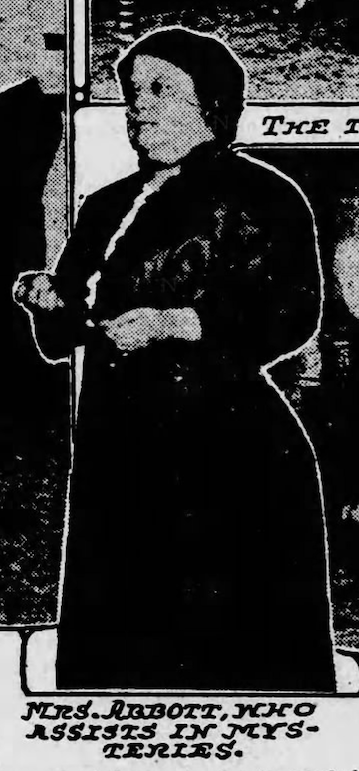
“Who assists in Mysteries.” Photograph from the Omaha Daily Bee.
Mrs. Abbott was well schooled in the art of magic. She, as well as her husband, had a skilled eye and was able to separate trickery for the genuine. She was skeptical of all mediums and fortune tellers. Although Mr. Abbott was the one to expose many of them publicly, Fannie Abbott was right there sizing them up.
Death of the Patriarch
George Abbott, father of David, died in the family home back in Falls City, Nebraska at the age of 77. He died of heart failure. As with Mrs. Abbott, the funeral services were to be held at David and Fannie Abbott’s Omaha home. This would be the first funeral held at 3316 Center—interesting to note, the first in a string of private funerals arranged within 3316’s exotic environment. As touched on previously, the Abbott family plot was at Westlawn Cemetery.
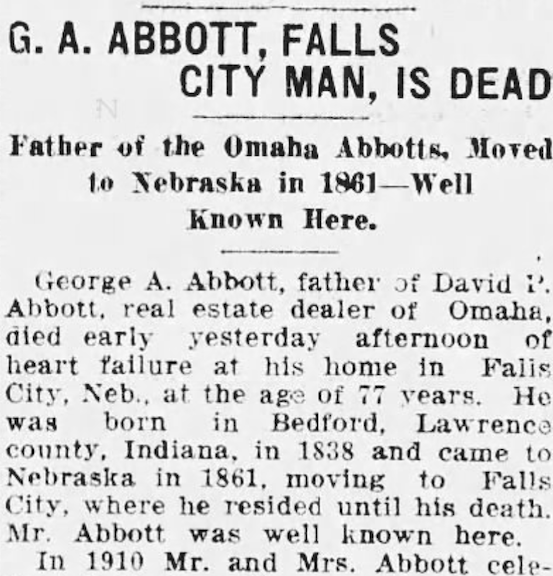
January 22, 1915.
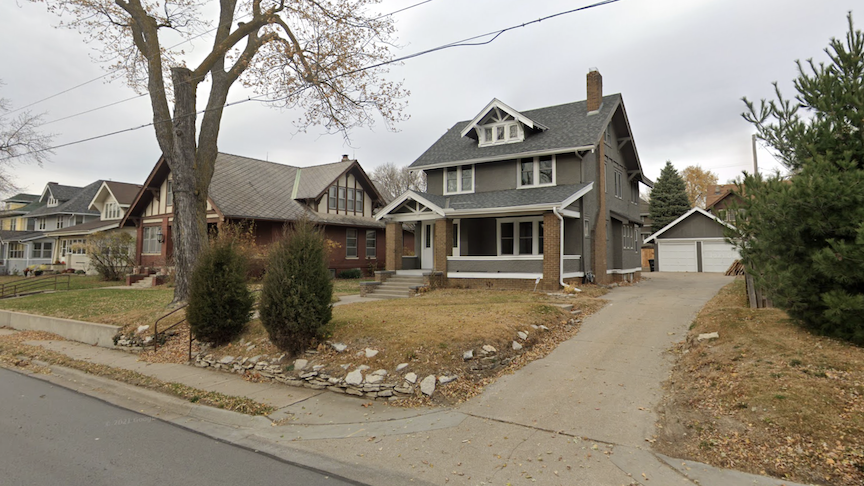
Also in 1915 the Abbotts would gain a new neighbor to their east, at 3310 Center Street. The J. A. Seablom family moved in after building their Craftsman style American Foursquare. These two homes look great together. One can see how unique 3316 Center is (very long and wide) in comparison to the 3310 Center Foursquare, generally considered a big home.
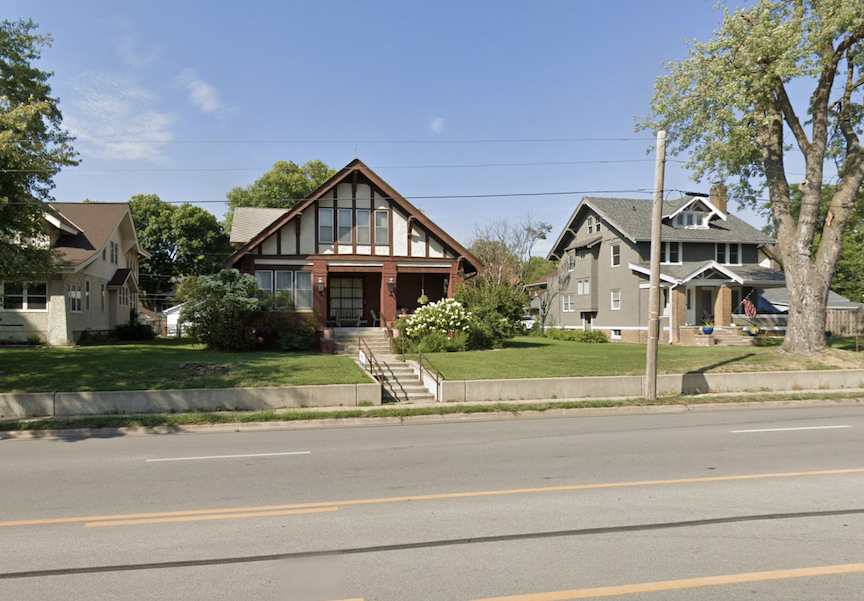
By 1918 3320 Center Street to the west was built. 3320 was also constructed by Norris & Norris. It is also a Craftsman Bungalow style but does not feature the prominent timbering.
Guest in the House
In addition to entertaining his friends and family, David P. Abbott’s wizard’s art attracted in professional magicians like a magnet. Studying, testing, endless experiments in perception, and putting his inventions into practice was his passion. “I do not pretend to have occult dealings with the infinite and am willing to state that the mysteries I perform are largely skills and art (…) My own discoveries have brought magicians from all over the world to see me and they give me their secrets for mine.” Abbott’s parlor acts were undoubtedly being studied by professionals for their ingenuity and stagecraft. Was he free to practice his magicianship without hindrance of professional pressures? I think being independently financially stable helped. His creative freedom was greater. But the sociableness of David and Fannie Abbott cannot be ignored. By all accounts the couple was warm, charismatic, welcoming hundreds (thousands?) into their home over the decades, and they stayed in touch through writing, creating lifelong friendships.
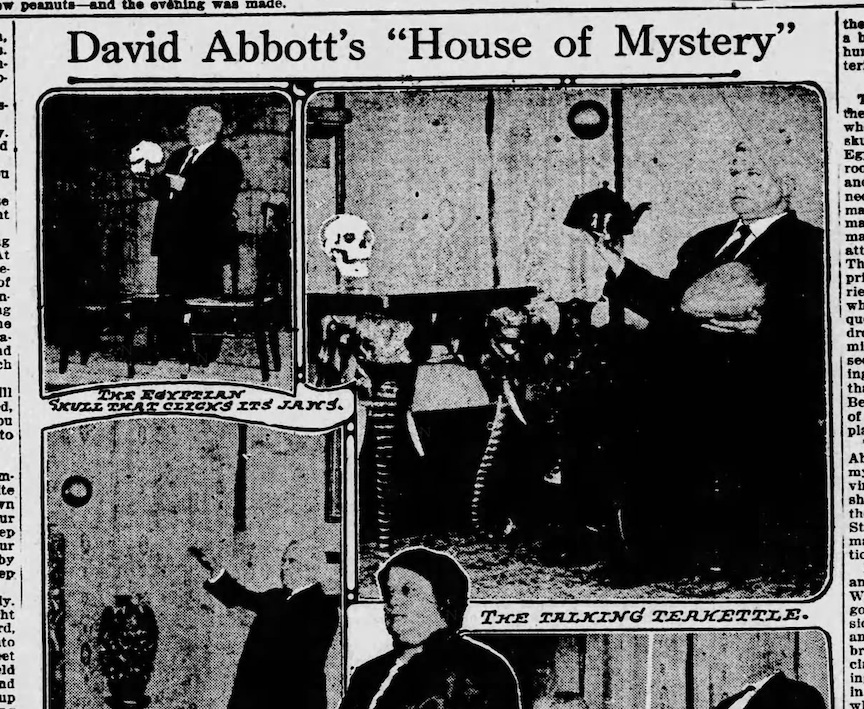
November 28, 1920. “The House of Mystery is all that could be desired for atmosphere suited for its weird purpose. Elephants of bronze, the ‘vase of a thousand monkeys,’ Japanese tables, screens and wickerwork made by such artists as Ishugoro, famous ceramic artist of Japan, are set against a background of spirit pictures. Two Etidorhpa representations of one who for violation of the secrets of Masonry, is compelled to pass through the center word, escorted by a sightless thing, occupy the walls. ‘Love of death’ a series of portrayed death masks, mummies, and mysterious paintings meet the eye everywhere. When under the greenish glow of burning alcohol, these spectacles are reflected and ‘Balsamo’ the skull starts snapping his jaws or the spirit of ‘Pantora’ makes a few casual remarks from the depths of the ‘vase of monkeys.’ Omaha seems a little less metropolitan and it is quite easy to believe that the oracle of Delphi might after all find some competition here.”
“Manchershu Bazupi Rhagallan, high cast Braham of India, Professor Enrico Marselli of Naples and the famous ‘Thurston,’ Sir William Crookes of England had already visited Abbott’s House of Mystery.” It was later reported that 3316 Center, “with its unique furnishings—many the gifts of world-famous magicians—is one of the sights of the middle west.” “Rarely do any of the professionals go through Omaha without paying him a visit at his home.” These are some of the greats that had found their way into the parlor and library of 3316 Center Street: Rameses, Owen Clark, Clement de Lion of Copenhagen, the Sharocks, Mercedes, Harry Blackstone Sr., Alla Axiom, Horace Goldin, Harry Houdini, Tobias Bamberg “Okito,” Harry Kellar, Ching Ling Foo, Han Ping Chien, Howard Thurston, and Sir Arthur Conan Doyle had sat spellbound in his home. He also enjoyed invigorating correspondence with Professor Albert Einstein and royalty throughout the world, to include the King of Italy and Kaiser of Germany “concerning magic.”
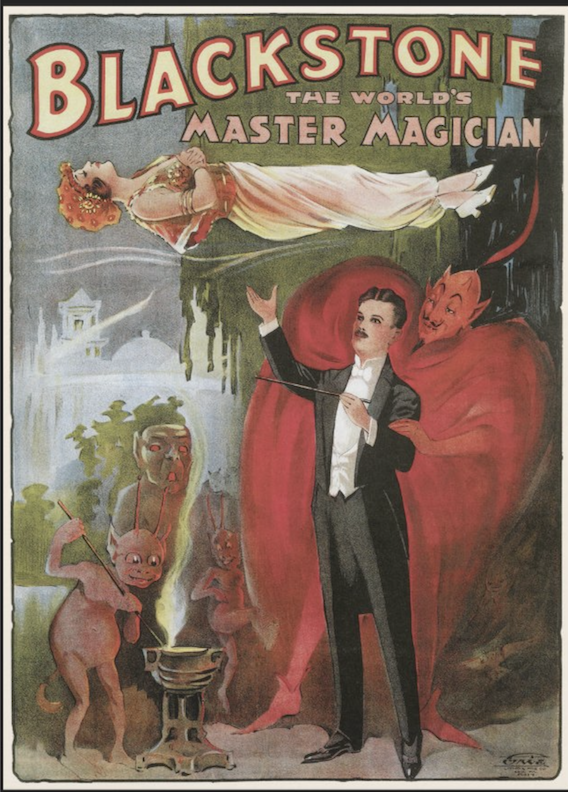
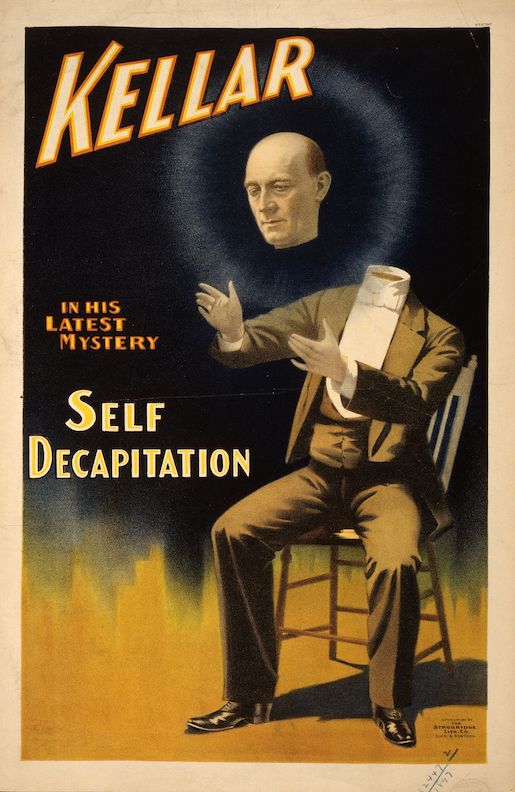

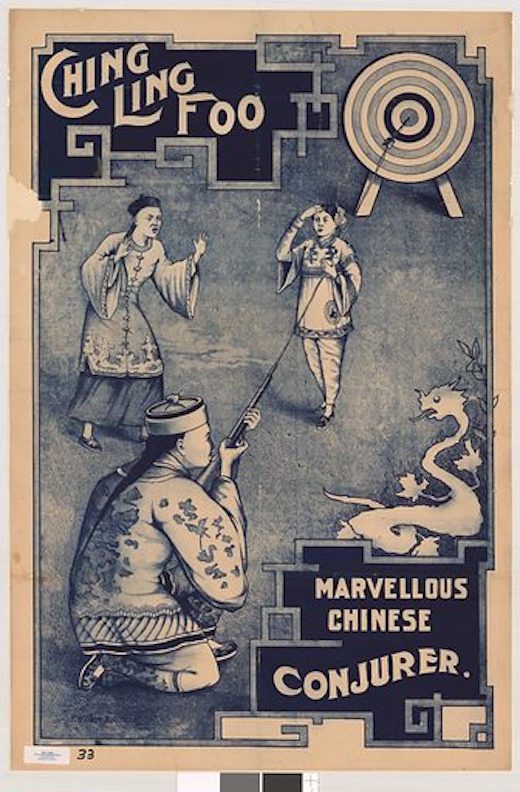
The man holding the skull is Howard Thurston.
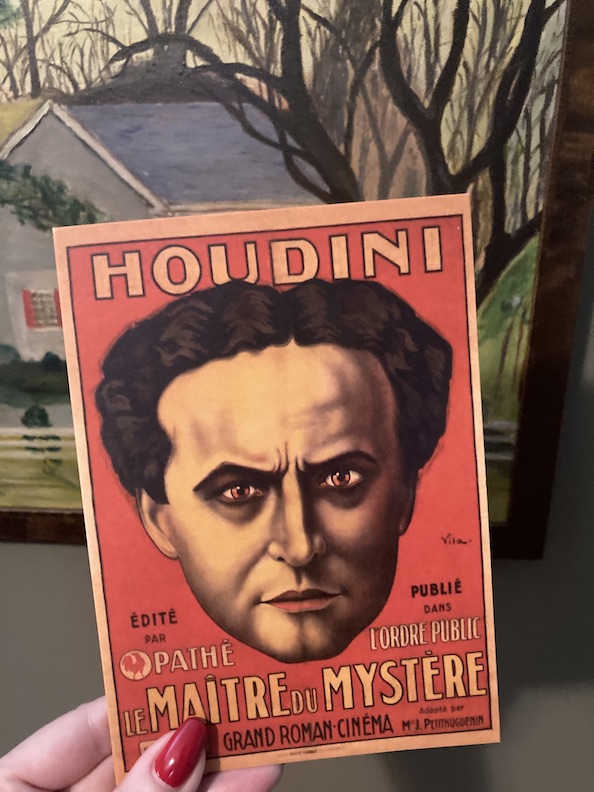
Admittedly I know little to nothing about magic but am obsessed with books, the posters and advertising of the magicians of yesteryear. This infatuation shows up in the cards I mail out.
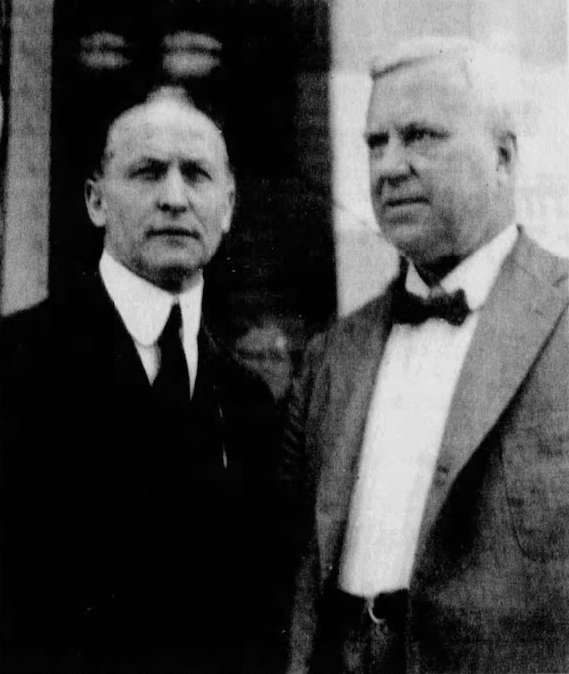
1923, September 8 photo of Harry Houdini and David P. Abbott in Omaha. By this time in 1923, David P. Abbott was credited with over 100 magic-related inventions “and probably more than 1,000 at his command.” It is said Abbott was one of the Omaha Magical Society’s first members when they initiated their group in 1921. Harry Houdini oversaw the Society of American Magicians, the organization’s national parent organization.
Side Investigation
I stalked the first meeting of the Omaha Magical Society. The newsmen reported the huddle took place at the Y. M. C. A. in late January of 1921. Of those first gathered, David Abbott was not present. That does not mean he didn’t join up shortly after. Talmage G. Beebe was made chairman at that initial gathering. In 1932 Mr. Beebe, by then called “President” of the society had died at the age of 43. It was at a Magical Society meeting to honor Thurston the magician that Beebe fell ill.
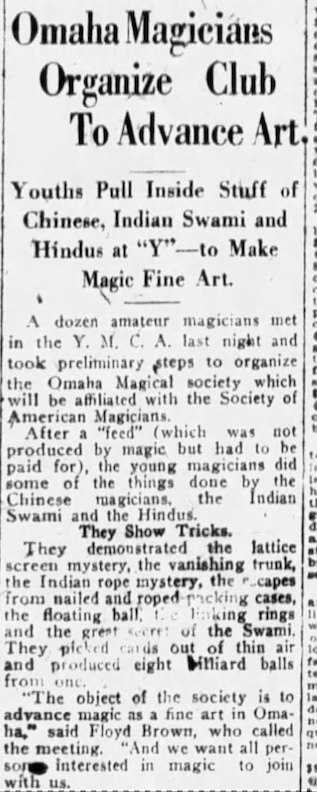
January 28, 1921. The Omaha Evening Bee. The society really seemed to take off in the early Forties.
The Mystery of the Icicle Lamps
I had asked you earlier to tuck something up your sleeve. Is it still there or has it disappeared? When we first saw the original photos of The House of Mystery, there were two exterior porch lamps of a globe sconce nature flanking the front steps. It is well documented that the Abbotts received many exotic gifts from all over the world by magicians and like-minded friends. At some point a trio of art deco icicle lights completed the curbside appeal of 3316 Center Street. Twin icicle-like torches were bracketed to the brick columns of the porch and another solo icicle flush mount light on the porch’s ceiling lit the large, cavernous space. I have no proof that these decorative dazzlers were a gift from a fellow wonder worker, but it seemed plausible the more I learned of The House of Mystery. The lights appeared to have characteristics of ornamental art deco lighting, oddly both geometric and organic at the same time. They looked to have been crafted in 1920s to the 1930s. Were they stalactites, stalagmites, icicles, or an interpretation of fire—like a true torch flame sconce? They were breathtaking.
I am saying that again for the people in the back: They were breathtaking.

Reminder of the earliest known sconces at 3316 Center. Detail of The House of Mystery. Bostwick, Louis (1868-1943) and Frohardt, Homer (1885-1972). The Durham Museum. 1920.

1980. Historic City Reconnaissance Survey photos. Look at those glorious torches.
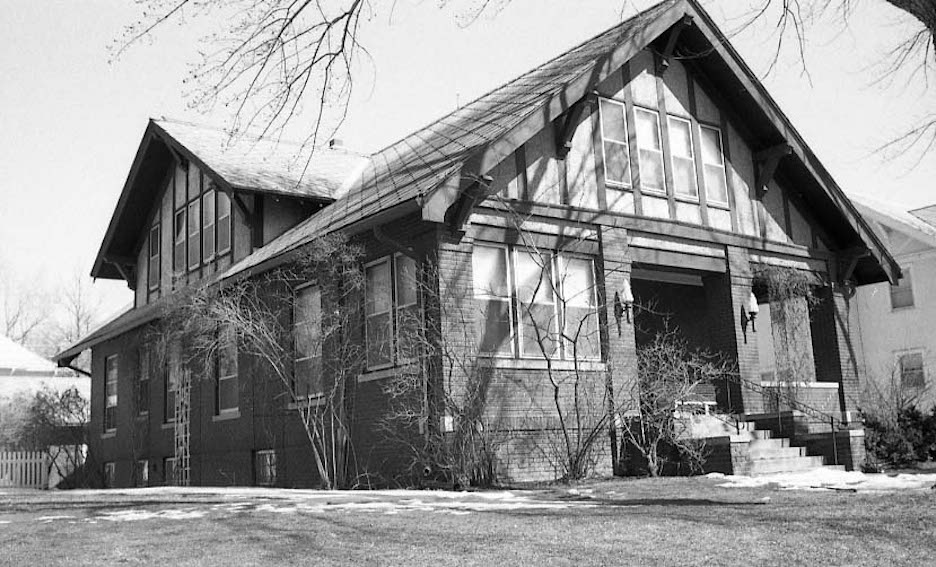
1980. Historic City Reconnaissance Survey photo.
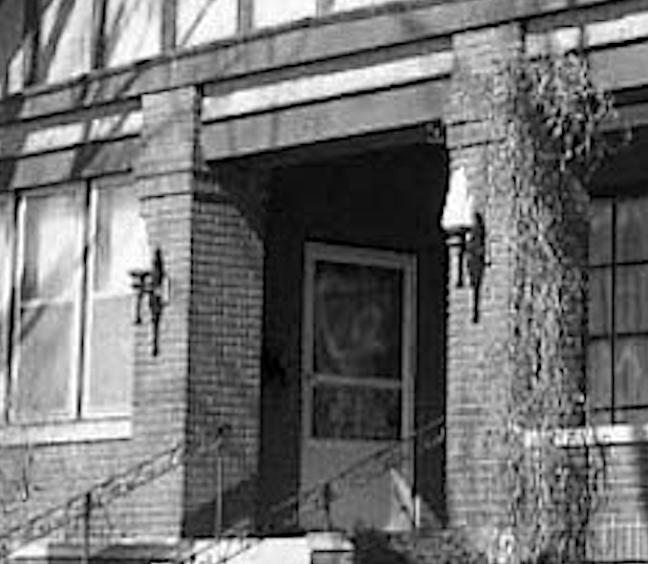
Detail magnified.
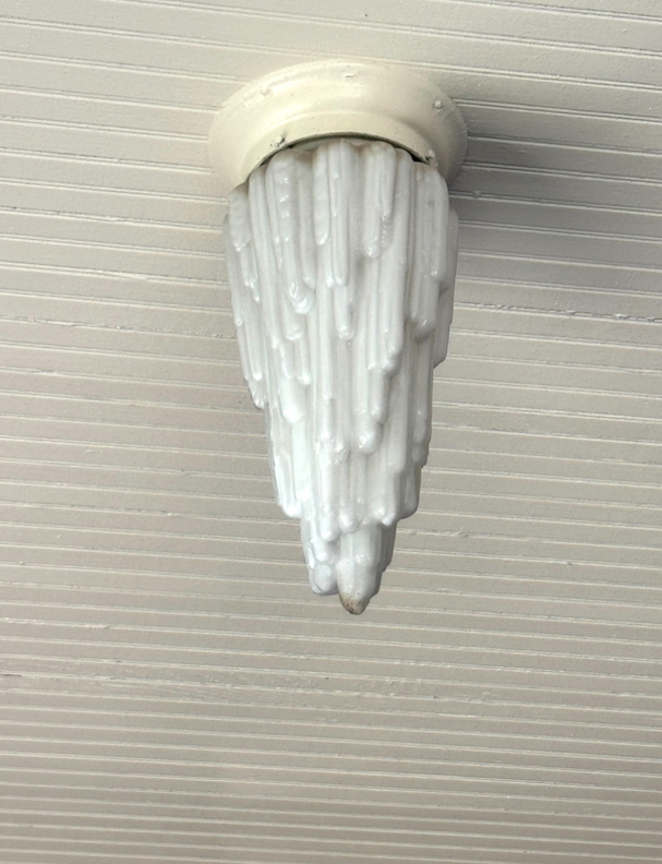
My friend Jimmy Kaufman captured this one of the porch ceiling light.
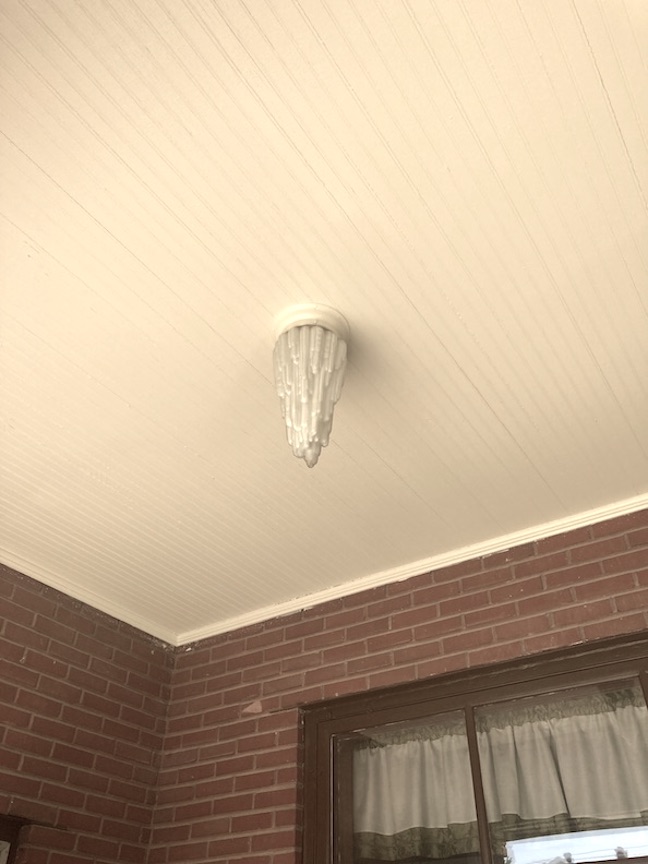
Here is one I took of the same single light, just to show perspective. It is a big girl.
Sadly the Schrat family told me that one day they woke up and the art deco porch sconces were gone. Thieves had removed the two historic torches that graced the entrance to their magical home–literally cut off or pried off of the brick in the middle of the night in a pathetic manner. The poachers left the one on the porch’s ceiling. The family couldn’t recall when it was. My friend, Jimmy, who lives in the neighborhood, said it was a big deal at the time. Because of the amount of historic architectural theft in the last ten years, Jimmy and neighbors suspected the lamps were hanging on some San Francisco home–meaning they were sold off and are long gone. I became obsessed with this theft. Obviously the sconces had been targeted. The question is–were the sconces picked by thieves for their unusual, intrinsic beauty or was this historic theft for hire? There is a black market for magic artifacts and property with a lineage of famous ownership is imbued with higher value. If David Abbott’s porch torches were truly poached for, say, a dark web client, the lamps would bring a pretty price tag and could be in a private collection across the globe.
I wrote to my contact at the Omaha Police Department explaining that “the lights were not only antiques but part of the house when a famous magician lived there. The more I work on this case, I’ve wondered if architectural scavengers were hired to remove them for a Superfan because of their notoriety or for an antiques-obsessed person. It reminded me of the beautiful brass railings taken from the old Omaha library in the middle of the night.”
OPD SYNOPSIS
“On Friday 21 November 2014 at 1753hrs, Svasek,Daniel (C986), while working in TRS spoke to SCHRAT, Lenora about Theft- all other. SCHRAT stated between 1200 hrs on Wednesday 19 November 2014 and 1630 hrs on Friday 21 November 2014. 2 light fixtures were stolen from her porch at 3316 Center St. SCHRAT stated she has an open porch and nothing else appears to be stolen during this incident. SCHRAT stated a couple weeks ago a flower pot was stolen from her porch. SCHRAT stated these light fixtures were attached to brick posts on the porch. SCHRAT stated the fixtures are antiques and she is uncertain what the value of the fixtures are.”
I was grateful that the Omaha Police were able to retrieve this 2014 report for me but it appeared the Abbotts’ porch lamp case was cold. I dream we can find them one day through this article or good fortune.
**Addendum of July 4, 2024. This just in from My Omaha Obsession reader and fellow sleuth, Joseph the Incredible. He found a light for sale at an online auction that we believe is Spot On. From the Holland Arts site:
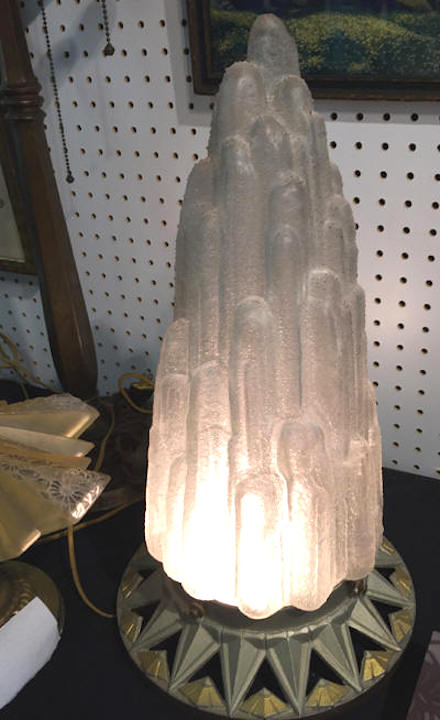
“A 1920’s Icicle stalactite/stalagmite shade on cold painted cast iron base. Made by Lightolier. The frosted glass shade is 19” tall. The base is 8” in diameter. Originally a stalactite ceiling mounted fixture, it can be used as a talbe lamp, as shown in the picture. “The Lightolier lamp company was founded in 1904 and is still in business. In its early years, the company specialized in fancy decorative chandeliers then made a shift to high-end design and architectural lighting in the 1920s.”
This light is very similar. And we’ve got a solid lead on the brand. Now we must find the missing two stolen lights. Thank You, Joseph the Incredible.

Abbott’s Linking Rings
There were so many more fascinating Abbott clues to share—information about the Abbott’s Studebaker with the “special size coach;” Abbott’s later use of an in-house band of musicians and singers for his late night performances; Abbott’s foray into investigating local haunted houses; Abbott’s simple obsession with his blue grass and clover lawn, so much so that he continued to write into the newspapers telling Omahans how to grow such a “good stand of thick unmowed lawn grass;” the Abbotts fascination with their oil burning furnace “ran cheaper than with coal” and later their public announcement of “favoring the introduction of natural gas in Omaha.” Then there was Abbott’s study of and relationship with Albert Einstein. Abbott wrote a well-known article on Thought on Time, Space and Existence published in a magazine and as a pamphlet. He worked to explain Einstein’s theory of relativity in layman’s terms for the local paper.
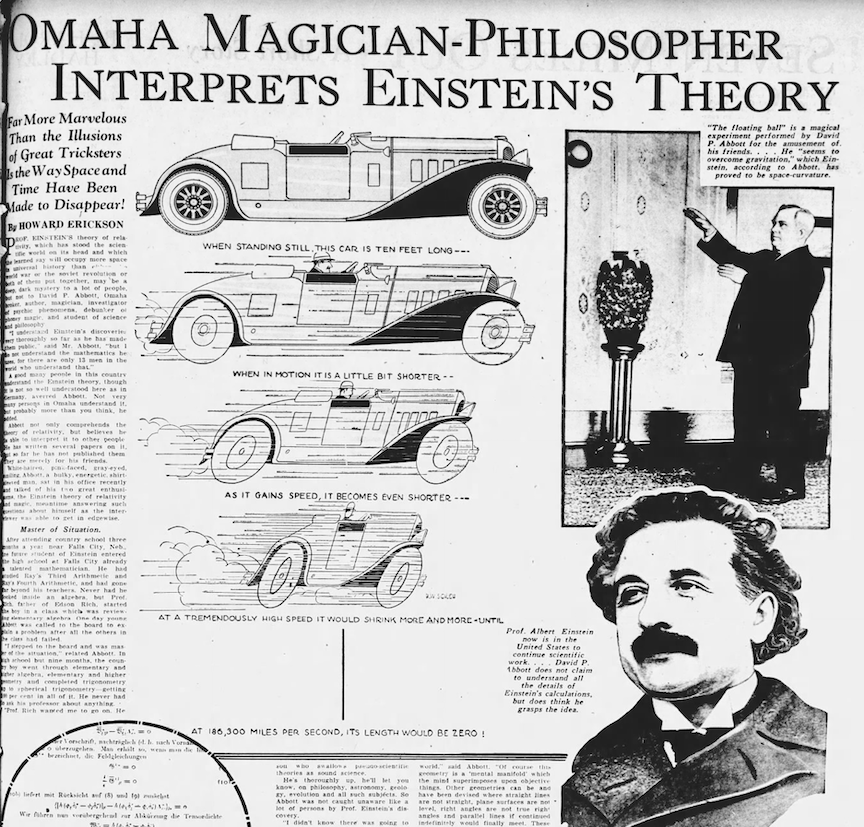
January 1931. Omaha World-Herald.
But there was none more publicized than when David brought the Wonder Girl to his parlor for “testing” for the benefit of the Psychological Research Society. I determined I could not possibly share them all. But if anyone in our audience wants to know more, please ask and I quite probably have the answers here on this very desk.
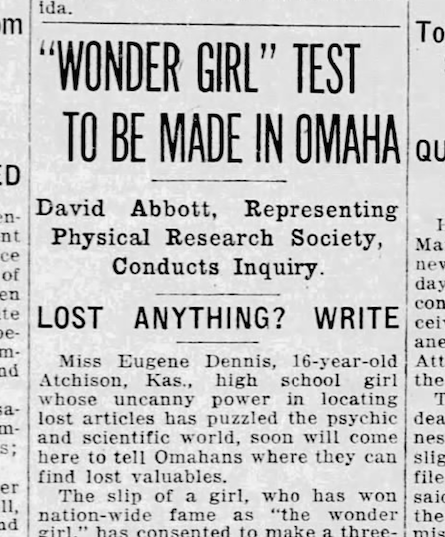

January of 1922. Omaha Daily Bee. Wonder Girl enchanted Omaha and the Midwest. Abbott and the Wonder Girl in the living room. Miss Eugenie Dennis from Atchison, Kansas.“Last night Mr. Abbott gave a private ‘entertainment’ at his home, 3316 Center Street, where Miss Dennis was to demonstrate her abilities to his friends. She will remain in Omaha the greater part of next week.” Mr. Abbott investigated Eugenie “Gene” Dennis and helped to launch her long career. The Wonder Girl was one of Mr. Abbott’s smaller manuscripts, a 32-page depiction of the renowned psychic, Eugenie Dennis, and only had a limited number of editions and copies accessible. According to Fannie Abbott, “Mr. Abbott always was convinced the Dennis girl had a psychic power neither her nor she were able to explain.” They stayed connected through the rest of his life.
There were two more topics of interest that I did want to touch on. Acquisitions and Funerals.
Acquisitions
The Abbotts purchased an unknown property on Center Street, “152 ft E of 35th Street n. s.” for $7,500 in February of 1920. “Marie M. Norris and husband,” who I presume to be of Norris & Norris sold them the land. Then on September 26 of 1921 David and Fannie Abbott sold “Center Street 157 ft E of 35th Street” to “Ono Troxel Bowman” for $11,000. A nice gain.

September 26 of 1921. Omaha World-Herald.
Then in October of 1924, David Abbott bought Lot 17 of Block 2 Fieldcrest and “west ½ of lot 18, block 2.” Odd phrasing, as the Abbotts already owned Lot 17. But this was the point at which they gained the strange western portion of the Lot 18.
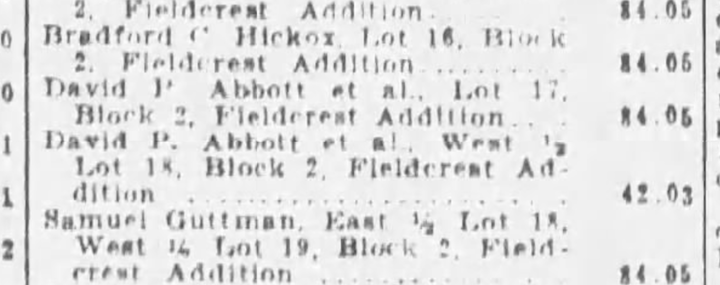
October of 1924, Omaha Evening Bee.
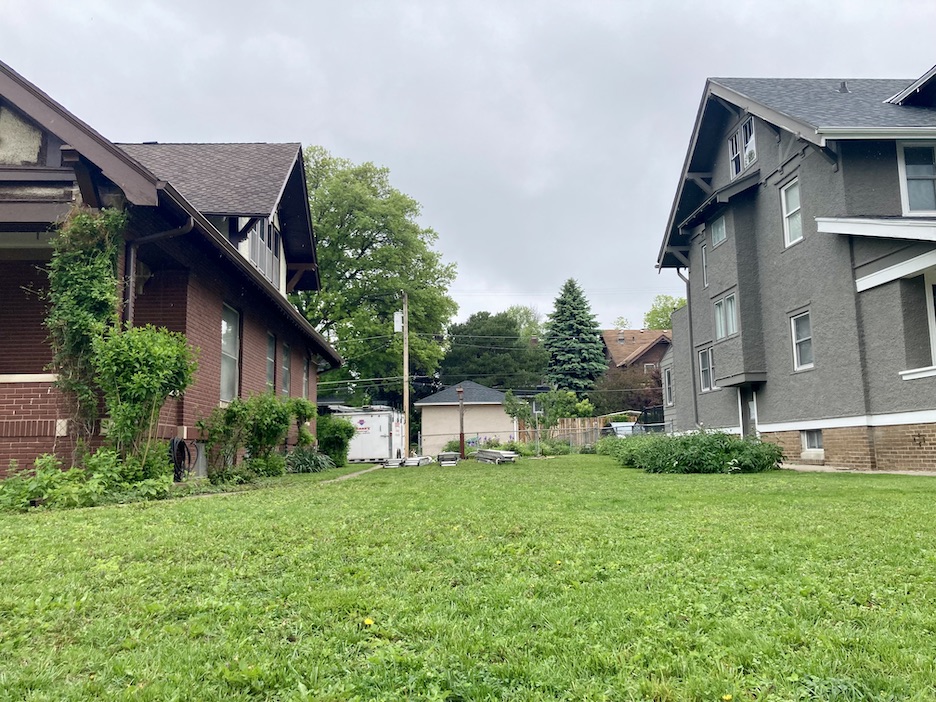
This photograph shows the land gained between the two neighboring homes. A nice green space without fencing. I am going to ask that you file this clue under your hat as this green space will become important in the decades to follow.
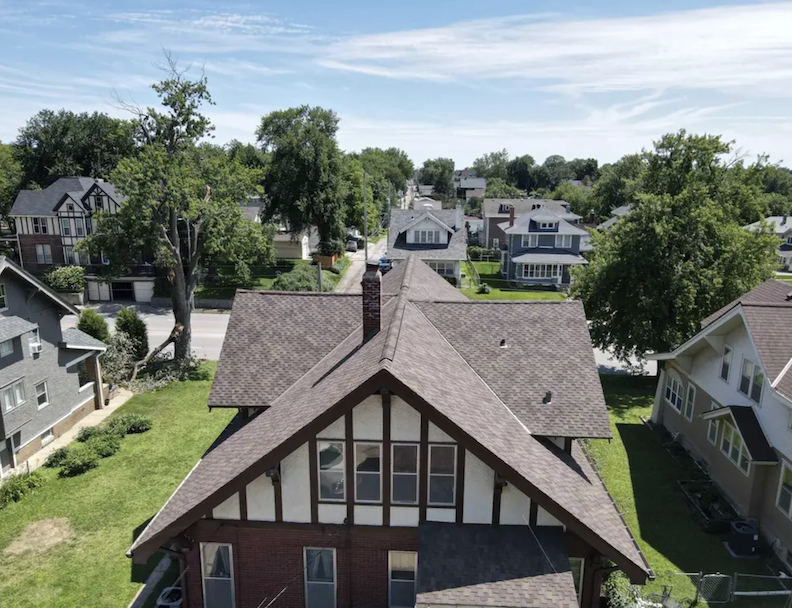
Another angle. Camera faces south. The rear of 3316 Center is shown with a view of the garden space between the two homes.
A Series of Home Funerals
It stands to reason that because of the age of 3316 Center, there would be a number of private home funerals within the residence. It was not unusual in the teens and 1920s to have a private parlor funeral in one’s home. But as someone who researches houses, I can say that 3316 Center had more than her fair share of these gatherings–I believe owing to the large size, and accommodating layout of the 3316 Center parlor and first floor in conjunction with what generous people the Abbotts were. Probably home size and David and Fannie’s personalities within their family roles made their parlor a worthy place to host a funeral. The wide front parlor or perhaps the library would have been where they kept the body, either in a coffin or casket in those days. The friends and family would have sat in the parlor during the formal service.
There were also at least two deaths in the home at the time of the Abbotts’ ownership.
January 22, 1915: Funeral for George Abbott, David’s father, age 77.
August of 1923: Funeral for Mrs. Daisy Abbott Stanton, David’s sister, age 45.
June of 1926: Death of Mrs. Edith Miller Kleppinger, Fannie Abbott’s sister, age 50. Passed away at 3316 Center on June 22. Sister Edith had apparently lived in the Abbott residence for 14 months while in ill health.
1929: Funeral for Thomas B. Clawson, brother in law of David, age 63. Clawson lived at 3316 Center but died unexpectedly at a filling station in Council Bluff, Iowa. I believe the same Clawson involved in the early People’s Loan incorporation. Funeral services were held at 3316 Center and Mr. Clawson was buried in West Lawn.
April 1930: Funeral for Mrs. Tilvia Abbott, wife of David Abbott’s brother, Julian Abbott. Sister in law Tilvia died in Grand Island but was transported to funeral at 3316 Center Street.
December 18, 1934: Funeral for Charles W. Robbins, brother in law of David Abbott, married to his sister, Mabel.
February of 1936: Funeral for Charles G. Humphrey, David’s brother in law, married to his sister, Ada.
There would be one more death in the 3316 Center Street residence and two more parlor funerals during the Abbott’s time in the house. And that’s where the story gets a bit sad for me.
Goodnight Moon
There were some intriguing revisions going on in the Abbott household that might have given clue, if anyone was tracking at the time. In February of 1934, with a capital stock of $15,000, The Daily Record revealed David P., Fannie and Eva I. (misspelling of Ada?) Abbott entered new article of incorporation for the People’s Loan Company. The existence of this corporation was to commence on the first day of March, 1934.
Was it in prediction of David’s or Fannie’s poor health that the couple put their 3316 Center Street House of Mystery on the market? Or were there other reasons? Without any kind of fanfare or Whispers of Magic, the World-Herald announced in April of 1934 that the nameless Abbott house was up for sale.” 7 nice rooms. Oil furnace, oak woodwork and floors. $3,800.”
On June 12, 1934, David Phelps Abbott died at 11:50pm in the Lord Lister hospital “after a long illness of diabetes.” Some reports I found said he died of Bright’s Disease, which we learned previously, had also consumed mother Sarah Frances Abbott. David and Fannie had been married for 47 years and had no children. Their devotion was evident. “Mrs. Abbott remained continuously at her husband’s bedside for eight weeks in a local hospital prior to his death.” David Abbott was buried in the Abbott family plot at Westlawn Hillcrest Memorial Park. Plot: Section 6, Lot 37, Space 5.

The magic community knew that David Abbott had been working on a manuscript for the last twenty years of life. “One of Mr. Abbott’s last requests to be carried out by his wife was to send his last manuscript, an encyclopedia of all feats he was acquainted with, to a publisher.”
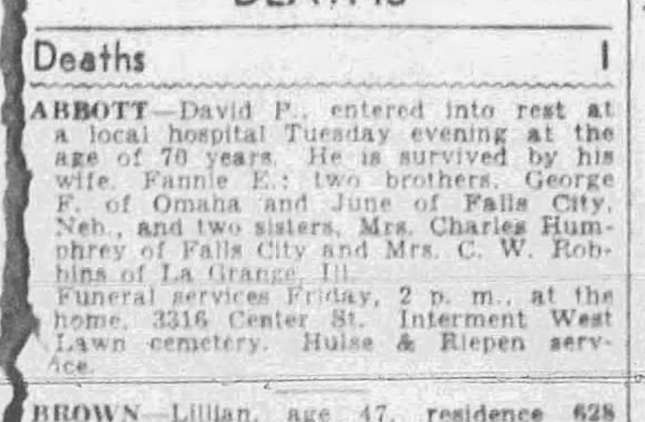
June 13, 1934. Omaha Evening Bee.
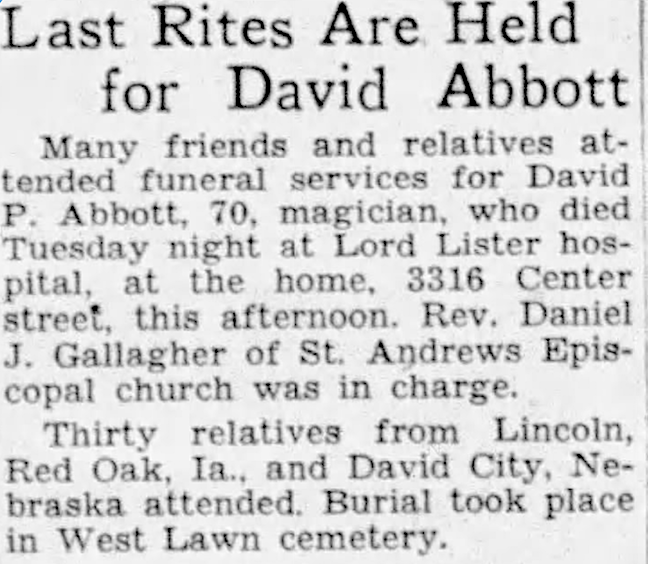
June 15, 1934. Omaha World-Herald.
It is said that David P. Abbott promised his wife: “If there is any way I can come back after I die, I will. Perhaps we should arrange some signal known only to ourselves, so we can be sure I am talking and there is no trickery.” Supposedly no signal was prearranged between Fannie and David. She waited. “Before he died, Dave told me if it were possible for him to return, he would do so,“ said Mrs. Abbott. “And I know that student of life that he was, he would do so, if it were at all possible.”
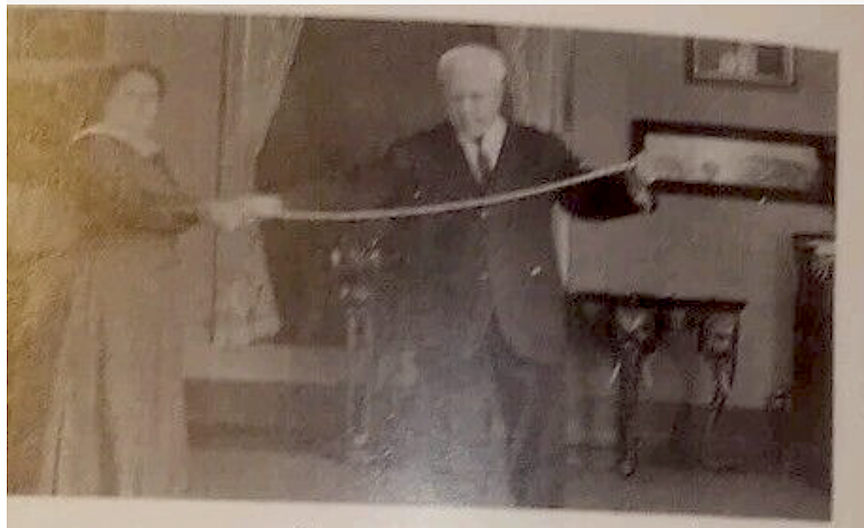
Conjuring the Silver Thread.
But a year after his death, Fannie still had received no communication. “Everything in the Abbott home remained the same as it had been before Mr. Abbott’s death. The phonograph record with played, ‘The Song of Dawn,’ Mr. Abbott’s favorite piece, remained on top of the machine, just as it had been when the magician last played it.” In these desperate days Mrs. Abbott held out for second line of communication, this one from an unlikely source. Mr. Abbott was always convinced “the Dennis girl” aka the Wonder Girl mentioned earlier, had a psychic power neither her nor she were able to explain. Fannie was quoted as saying, “He had a great deal of faith in Gene Dennis and I am convinced if anyone can communicate with him, she can, though she never posed as a medium. She loved him as a father.”
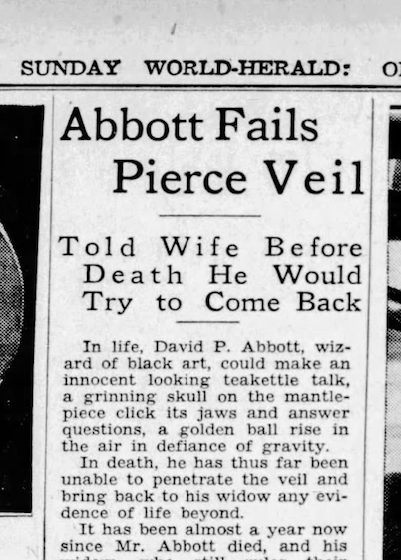
May 19, 1935. Omaha World-Herald headline. Can you imagine an article running this like in this day and age?
Darkness at Noon
There were series of sad articles, outlining David Abbott’s neglect or inability “to penetrate the veil and bring back to his widow any evidence of life beyond.” So painful was it read, that one local woman wrote the newspaper and suggested something to the effect of Mr. Abbott maybe having other things to do or that his message wasn’t being received. The point the newsmen were making was that Fannie could not find the faintest sign and that things were not going well. Tricks were “strewn about the house in the most unlooked for places” and it was there that Fannie grieved continuously. I was saddened to find a fire took place in the Abbott garage in May of 1935. Burning cigarette thrown into some rags. Why did that always seem to happen in the past? Was it code for something or simply an accident?
It was said that Mrs. Abbott slowly failed in health until she died at age 68 at her home at 3316 Center Street on May 4, 1936. There was never a medical cause of death given publicly when they had been so descript about David’s. In my life experience I have seen that a person can suffer and die of a broken heart. “No message ever was received by Mrs. Abbott. She hoped daily for a word from her husband. On her deathbed, only a few days ago, she mentioned the missing message. She said it mattered no more because she would join her husband soon.”
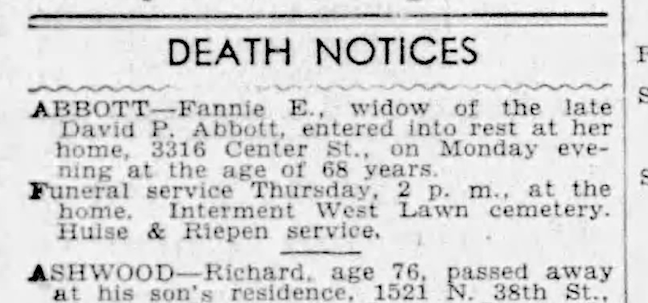
May of 1936. OWH.
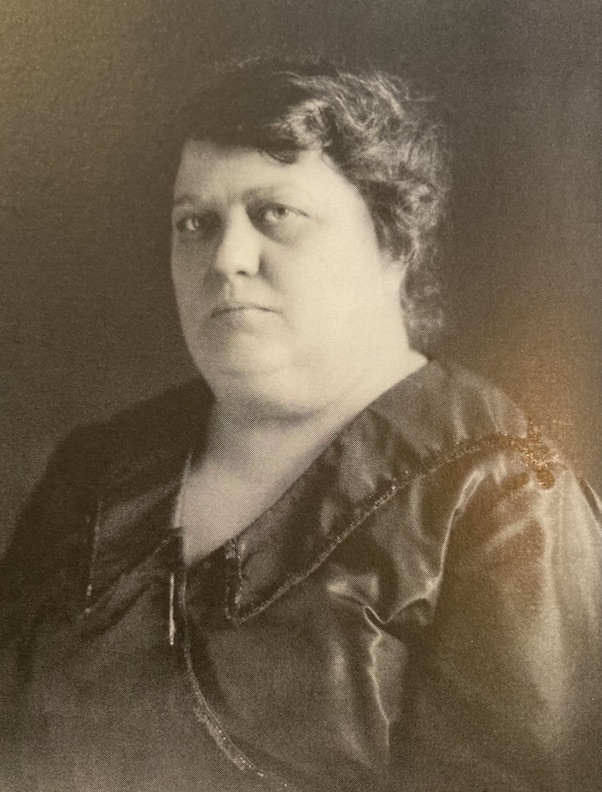
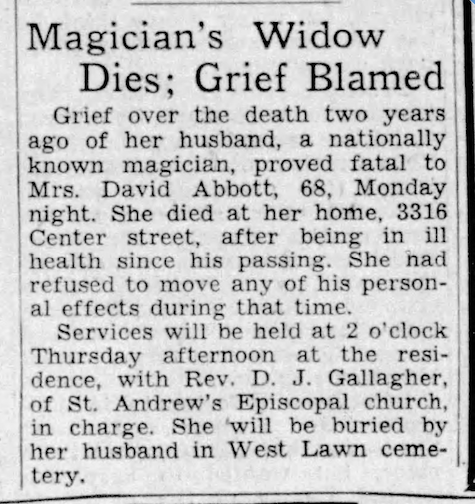
May 6, 1936. OWH.
May 7, 1936. Thursday Omaha Evening Bee-News: “Services for Mrs. David Abbott, 68, held at 2 pm at her home, 3316 Center, were exactly like those held two years ago for her husband, prominent Omaha businessman and magician of wide fame. It was Mrs. Abbott’s wish that the funeral be conducted exactly like that of her husband. She died Monday night. Mr. Rev. D. J. Gallagher, of St. Andrews Episcopal church, officiated. The same music was sung. The caskets were alike. Mrs. Abbott was buried next to her husband’s grave in West Lawn Cemetery.”
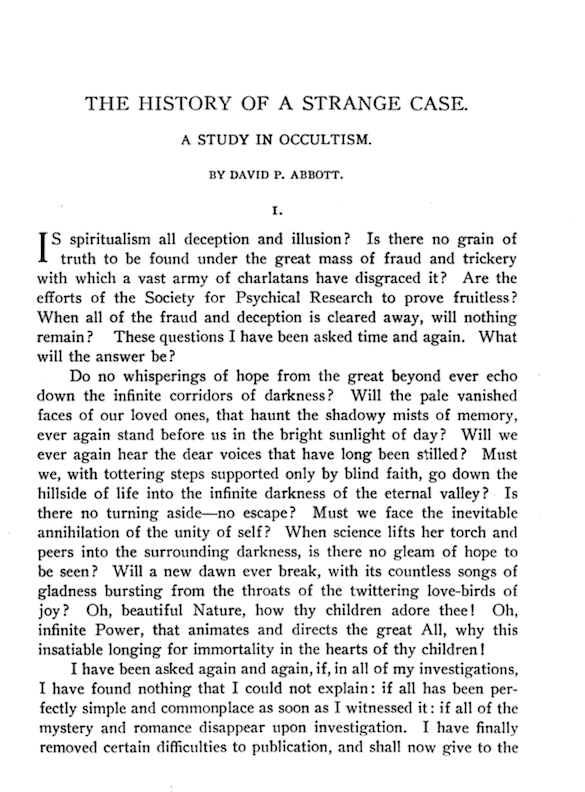
David Abbott’s writing from 1908.
The Secret Weapon
I must drop this in for those diehard obsessives who are interested in matters of historical build up. During this time the Field Club Neighborhood was filling in with its previously described third phase of housing development. Built during the Second World War and shortly after, the Minimal Traditional houses made use of the scarce building materials available at the time. A distinct but brief chapter in American architecture, these petite, practical dwellings and their designers did not cut corners on style. Because of what was achieved “with less” embellishment, they are some of my absolute favorite buildings in our country.
The Walnut Street homes, between 35th and 36th Streets are a delight and make me smile every time I drive down the street. Is This A Movie Set? Some of these structures were credited (from the City Planning Department site) to Architect Charles Stinman, others were not, but there is a harmonious charm all the way down the line. And the people who live here are equally as friendly and can often be found on their porches, in their yards and gardens engaging in the activities of yesteryear like standing around talking to one another, grinning, reading the newspaper on the porch, and manually pulling weeds. Don’t Delay: Everything smiles back at you on this block, even the houses.
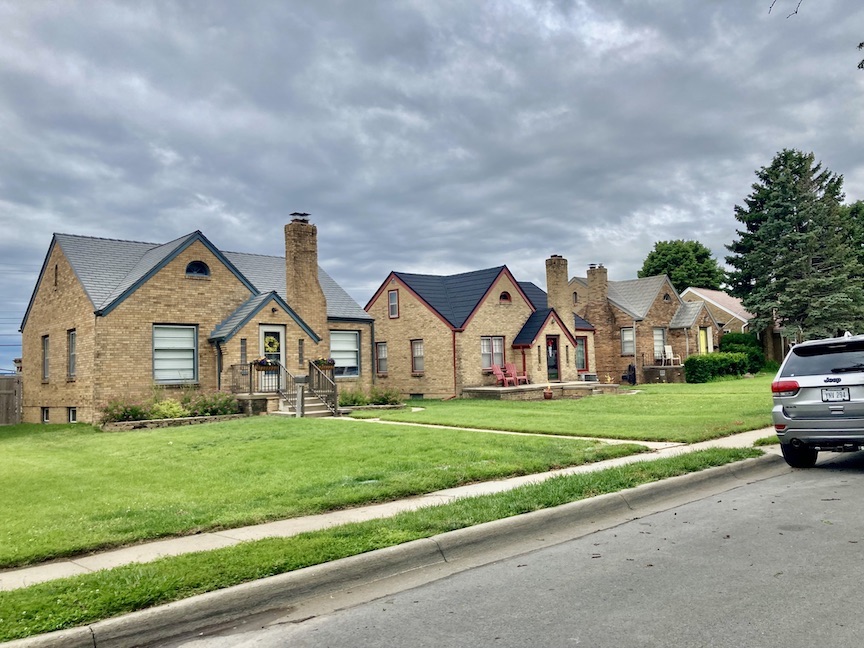
Walnut Street Fascination.
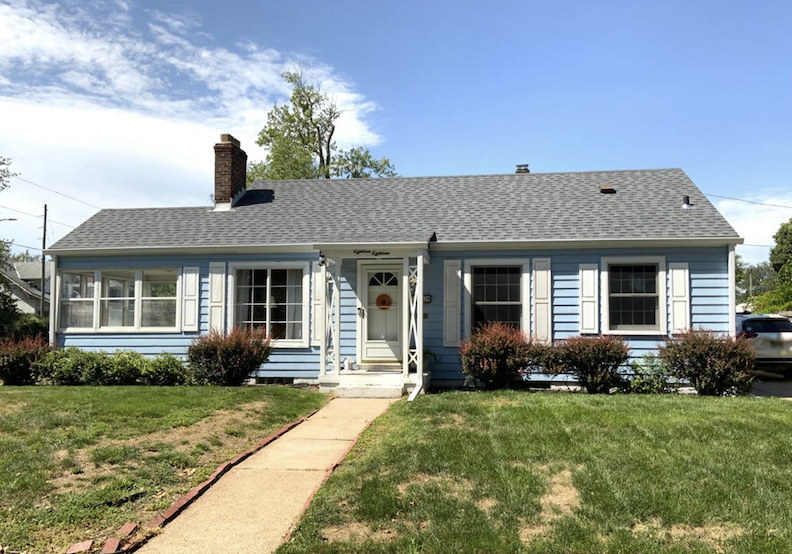
Again, you may ask—“Miss Cassette, is this a movie stage?” Constructed in 1941, 1818 South 33rd Street is within the Field Crest Addition and is located around the very corner from the Abbotts’ home. This house is such a charmer and looks almost exactly like one of those metal 1950’s dollhouses. Please, let’s get back to this type of building ASAP.

Boop! 1950’s metal dollhouse.
If possible, stroll through the blocks of Field Club and see if you can detect more of the Third Wave of construction. You will have fun.
The Mysterious Business of Inheritance
The Abbott last will and testament was opened, directing disposition of personal and real property unofficially estimated at $100,000. Jay Gibbs, attorney, was to open the legal document at the courthouse in the presence of relatives. Real estate was initially valued at $25,000 and personal property at $40,000. These were thought to be very low estimates. Apparently included in the personal property list was “valuable equipment owned by her husband.” When David Abbott died, the People Loan Company, valued at $50,000 was given to her husband’s relatives—David P., Julian A. and George F. Abbott, Ada Abbott Humphrey and Mabel Abbott Robbins. The loan firm was incorporated for $15,000. Fannie Abbott owned the apartment building (the Abbotts’ apartment building at 24thand Landon Court purchased in 1909) that would be willed in equal shared to her and her husband’s relatives. Special bequeaths were thought to include vases, oriental rugs, oil paintings and sculptured articles in the Abbott home. As we know David and Fannie Abbott were the connoisseurs of magical gems. Fannie’s will left a number of art objects, “mostly Oriental to members of both families. Magic equipment owned by her husband will be sold with the estate.”
And like that, on May 12, 1936, the Abbotts’ House of Mystery was up for sale. “Inquire within.” To whom, I wondered? Who was staying in 3316 Center? “One of the finest brick homes in Field Club. Finest of quarter sawed oak. Two baths. Built ins. Garage to match. For sale by the Rasp Brothers.”
Interested in the Rasp Brothers? Check out my earlier investigation: The Mystery Mannequins of Midtown.
In the summer of 1937 the Abbotts’ representative, Miss Edith Beckman, attorney for the Abbott estate, had an auction of David and Fannie Abbott’s possessions that didn’t go directly to family. The auction was held at the Abbotts’ Landon Court Apartments.
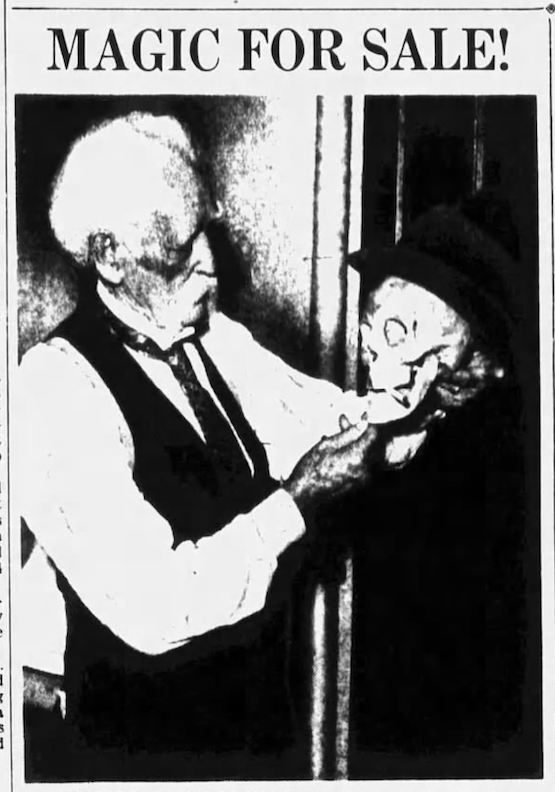
June of 1937. Omaha Bee News.
“Dr. Homer S. Woodworth, 95 , a professional magician for 80 years, poses with Dr. Balsamo (with hat and cigarette) whom Woodworth bought at the auction of the magical paraphernalia of the late David P. Abbott. Dr. Balsamo was papier Mache. Proceeds from the sale amounted to about $50. Two singing teakettles were sold at $5 each.” UGH. It made me feel sick and strange. I was also shocked to find that Dr. Balsamo was papier Mache! Of the teakettles– one went to Dr. Woodworth and another to Frank Gardener. Both men bought these as remembrances of Abbott and many other friends were said to have bought various trick items as keepsakes.“Spirit paintings,” “a fortune in beads”, trick cards, books, “gold coins,” found to be merely pennies and photographs of David and Fannie went to Mrs. Sam Mayer, wife of a Cincinnati magician. David’s possessions are no doubt strewn about the country. Or are these treasures all collected together in the possession of the Icicle Torch Lamp Freak?
In October of 1937 the families of Fannie and David Abbott went into court. William David Atherton was plaintiff, and 17 others were defendants. One of them was Edith Beckman and another was Hazel F. Atherton. Edith Beckman was the Abbott’s estate attorney. Hazel F. Atherton was a relative and legal guardian of the estate. (File away these names.) The Abbotts’ two properties of the 3316 Center Street house and the Lots 9 and 10 of Convent Place would sell at public auction to the highest bidder.
Sold at Auction?
While it was odd to me that the Abbotts’ estate attorney was brought into court as a defendant, I found it even more curious that she was the one to ultimately purchase the Abbotts’ House of Mystery. If we have any estate attorneys in the audience, they might be able to shed light on this, perhaps, common occurrence. There was an in-between step involving another woman of mystery. In February of 1938, the Evening World Herald real estate transfer let on that Hazel F. Atherton, guardian of the Abbott estate, sold to Rose Guggenmos, lot 17 and W ½ of lot 18, block 2, Field Crest addition. 3316 Center Street.
Then on the following September of 1938, Rose Guggenmos sold to “E. K. Beckman et al” lot 17 and w ½ lot 18 block 2 of Fieldcrest Addition. I would find that in 1950 Rose Guggenmos was retiring from 28 years of service as a bank vault custodian at the Omaha National Bank where she worked in the same department.
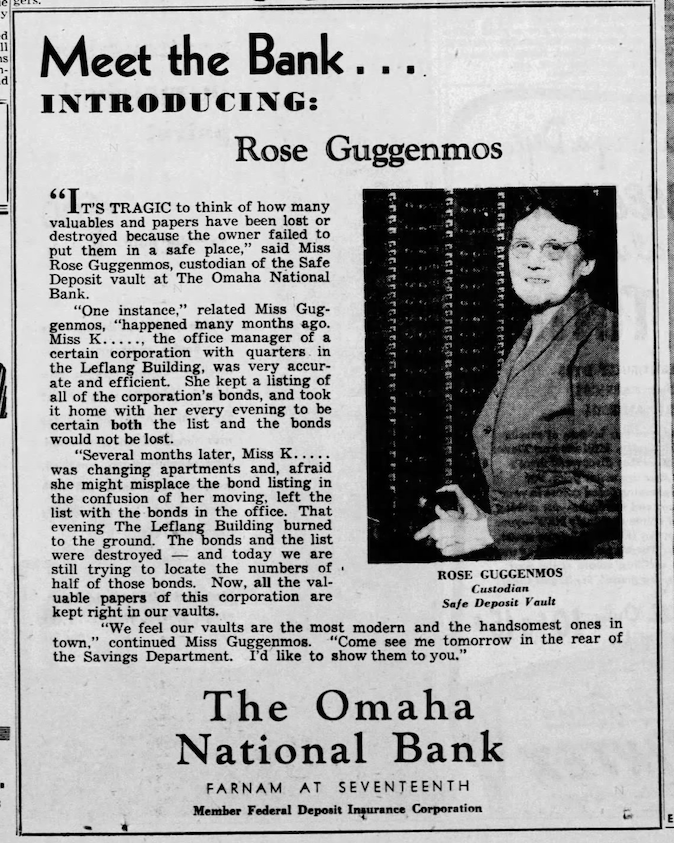
Here she is in 1948.
In the 1920s I found her name attached to “releases” in the all the local newspapers. I believe when people had fulfilled all of their mortgage payments, they would be “released from debt.” Rose’s name was possibly listed as the bank mortgage lender’s representative. Little Rosa Guggenmos, as she was called when she was young, came near the end in a long sibling string of at least eight. Her father was from Germany, her mother from Switzerland. Her father was a brewer when they arrived in Omaha, by way of New York and Iowa. German brewers were something Omaha welcomed and he continued to make a living at this art. Miss Guggenmos never married and continued to live downtown alone. At the time of the 1930 U. S. Census Rose Guggenmos was a 48-year-old woman living at about 19th and Farnam. By the time the 1940 Census rolled around she had gotten younger, perhaps an accident of the census taker… or maybe no accident at all.
Although I discovered that the Abbotts’ attorney bought their house in 1938, she was not too eager to move in initially, for unknown reasons. If you have followed us for a while, you know I will be sharing my suspicions later. Miss Edith Beckman apparently was renting the house for a short while.
The Hall Family
Building contractor Donald Hall was listed as residing at the house in the 1938 City Directory. In the end, I discovered that Don Hall’s parents, Dr. C. C. and Mrs. Leona Hall held the lease at 3316 Center Street.
Born in Villisca, Iowa to Calvin W. Hall and Rebecca M. Overman, Dr. C. C. Hall earned his degree from the Chicago Veterinary College in 1906. This was also the year he was married to Leona “Lona” Spargur in Montgomery County, Iowa. Shortly after the couple moved to Omaha and Dr. C. C. Hall began practicing veterinary medication. His resume reveals a man well connected to the inner circle of Omaha. Before mechanization of the fire and park departments, Dr. Hall was veterinary for the city’s horses. Under the late Mayor Dahlman, he was appointed to the Omaha Health Department staff and remained there until 1930. Dr. Hall was also elected as a member of the board of education in 1936 and a second term followed in 1940. “He had been principally responsible for development of Omaha’s modern meat and slaughterhouse inspection system, which closely parallels federal health regulations.”
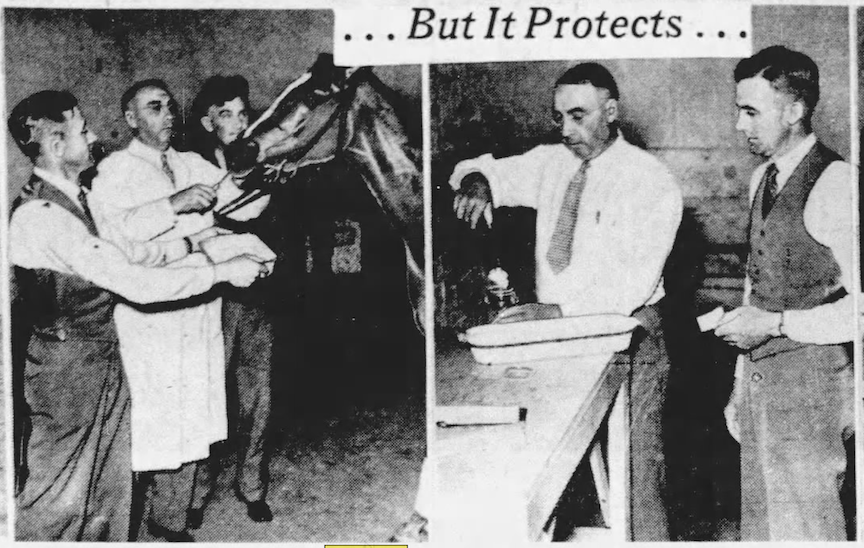
In 1938 Dr. C. C. Hall was the Ak-Sar-Ben track house veterinarian. Here he is testing for doping in the stables. Dr. Hall is the man in white in both photographs.
For Lona Hall’s part, my early 1940s detection nosed out a woman with her own magical obsession. While living in our 3316 Center Street House of Mystery, Mrs. Hall began collecting a variety of soaps, including miniatures and carved animal fat statuettes of Little Red Riding Hood, Ferdinand the Bull, and Mary Pickford. Farm-fresh soap and soaps from every state, nothing got by Mrs. Hall. Additionally, she gathered wishbones from chickens “as sort of side hobby.” We don’t judge, we marvel.
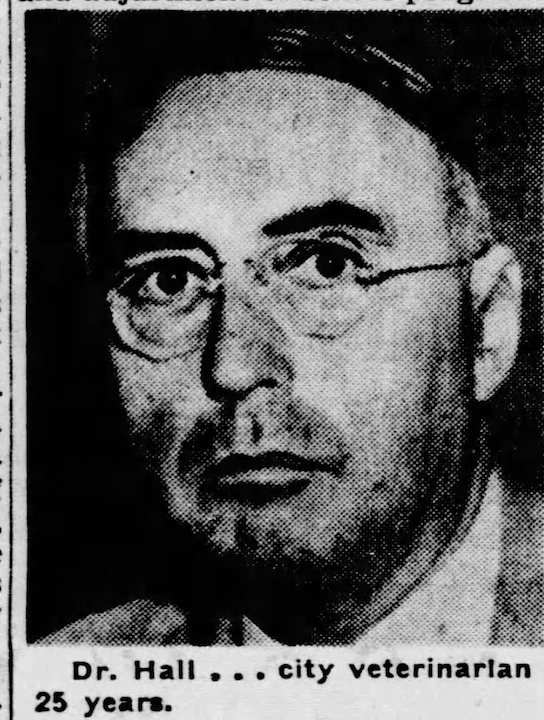
1939. Omaha World-Herald. Dr. C. C. Hall
According to his 1917–1918 World War I Draft Registration Card, the good doctor’s full name was Cushman Calvin Hall; born on December 29 of 1883. “Surgeon veterinarian.” Before renting out 3316 Center from Edith Beckman, the Halls and their two sons, Dennis and Don had lived at 207 South 26th Street for many years. Dennis would go on to serve in the U. S. Army and son, Don, would leave the construction business to become Deputy Sherriff in Douglas County.
Dr. C. C. Hall fell seriously ill in May of 1942. He was taken to Nicholas Senn hospital where he later died May 22 at age 59. If you’d like to learn more about the unusual Nicholas Senn Hospital history, please follow to: The Case of Park Avenue and the Mysterious Hospital.
I was most interested to stumble upon report of Dr. Hall’s remains, which would “lie in state at the 3316 Center Street residence.” Again this formal occasion suggested Dr. Hall’s coffin would be placed in the very parlor where there had been so many Abbott family funerals. In this way the public could come by and pay their respects either before the funeral ceremony or it served as the funeral place itself.
In June 1942, Mrs. Lona Hall relocated from 3316 Center to 4242 Farnam Street. By 1979 the 4242 Farnam Street house and others on the block were demolished, with new building permits turned in for the Clarkson Doctors Building. The area as a whole is now a part of the Nebraska Med Center. I found a person named “Beckman” quickly listed the 3316 Center house as a rental in July of 1942.
Eventually, Edith Beckman, the Abbotts’ lawyer, and her sisters would move into the house. I was back at the library poring through city directories to try to narrow down that date because I couldn’t put a finger on it. Similar to the Abbotts, I had numerous indications that the Beckmans were a real family of characters—bold, gregarious, unapologetic, and unafraid to defy expectations.
Out of the Past
Joseph Beckman was born in Germany in 1850. His mother was Spanish, and his father was German, according to the 1910 U.S. Census. Like so much history lost to time, the Beckman ancestry was altered–either logged erroneously by the census taker or family history was revised. Joseph Beckman immigrated to the United States in 1866. In 1856, Ida Mary Kleffner was born in Dubuque, Iowa. I’m going to take a wild stab at the Kleffners also being of German descent. A year later, the Kleffners relocated to Omaha (according to other histories, 1858.) In 1876, Joe and Ida, also called “Mary” got married. (Some sources state 1875.)
Joe was a well-known “popular Farnam Street cigar man,” willing to take up causes in the local press or on the streets with bold confidence. Considered a pioneer Omaha cigar manufacturer and dealer, Joe Beckman first hung up his cigar business shingle in 1875. His first business location was at 212 South 13th (basically 13th and Farnam), remaining there for two or three years.
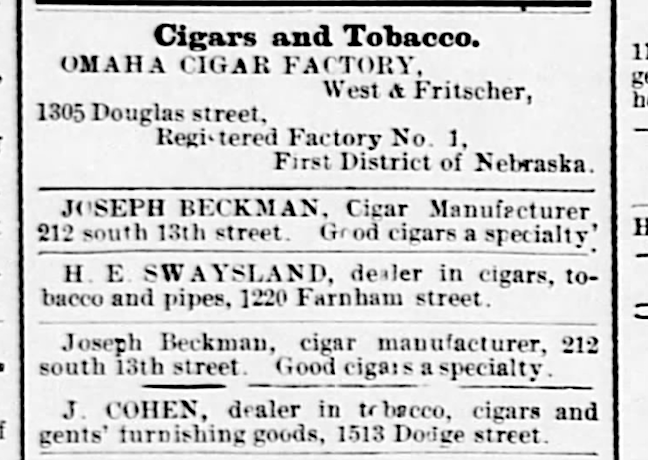
1881. Omaha Daily Bee. So revered, he was listed twice.
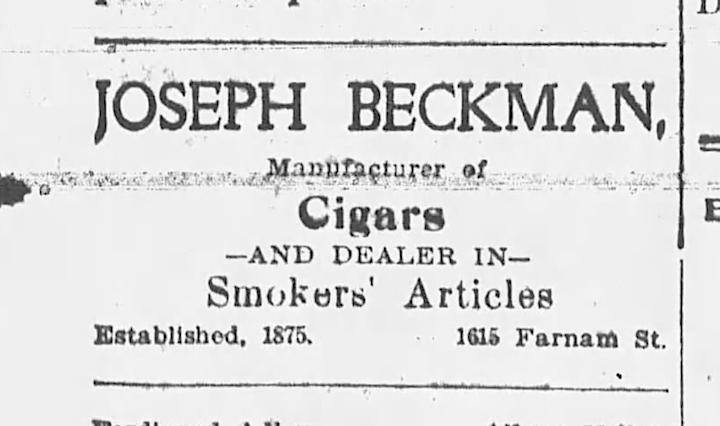
Omaha Daily Bee.
He moved his business to 16th and Howard, three years later relocating on Farnam between 16thand 17th. Joseph Beckman cigar factory was found in the directory at 1607 Farnam Street. 1615 Farnam appeared to be the factory-shop’s final location. Now whether this was Joe’s influence or merely coincidence, Ida’s brother, Fred Kleffner was also a cigarmaker by trade. This was a time of immense popularity for cigars, with many thriving individual, smaller, local brands and I’ve got to think, much less regulatory scrutiny, if any. Cigars really took off in 1860 and seemed to have good run until cigarettes were promoted in the teens and 1920s.
The Beckman couple had six children, four survived to adolescence. Annette “Nettie” was born in 1876. Mary, sometimes “Marie” Josephine born in 1880. Anthony “Tony” Arnold Beckman born in 1884. Much younger Edith was born in 1891 (elsewhere says 1893). The Beckmans had a good-sized home at 814 Georgia Avenue. Due to ever changing of street names, house address later became 814 South 29th Street. We’ve reviewed this bit of Omaha strangeness in our past investigations. The Beckman children were born in this home. Considering their income, size of the family and status of the neighborhood, the Beckmans were very often looking for “a good German or Swedish girl for general housework.”
From what I can put together from aerials, sadly the house was razed in the 1960-1980s time period and became part of the neighboring gas station’s large parcel.
For more about the neighborhood, please follow to: Park Avenue Recollection.
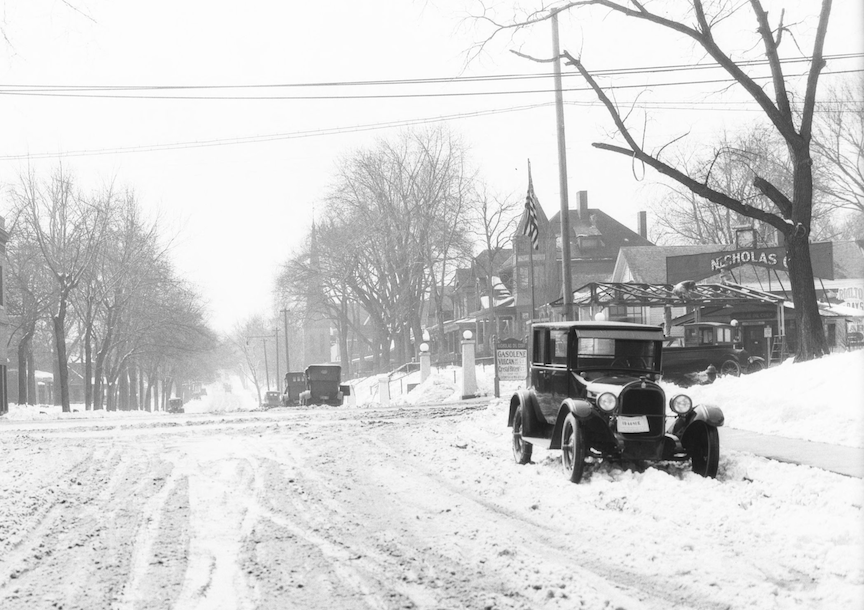
The camera faces south across Leavenworth, showing 29th Street leading down the block. Gas station shown on the southwest corner of 29th and Leavenworth. The Beckman house would have been one of these homes next to the gas station. Bostwick, Louis (1868-1943) and Frohardt, Homer (1885-1972). The Durham Museum. 1924.
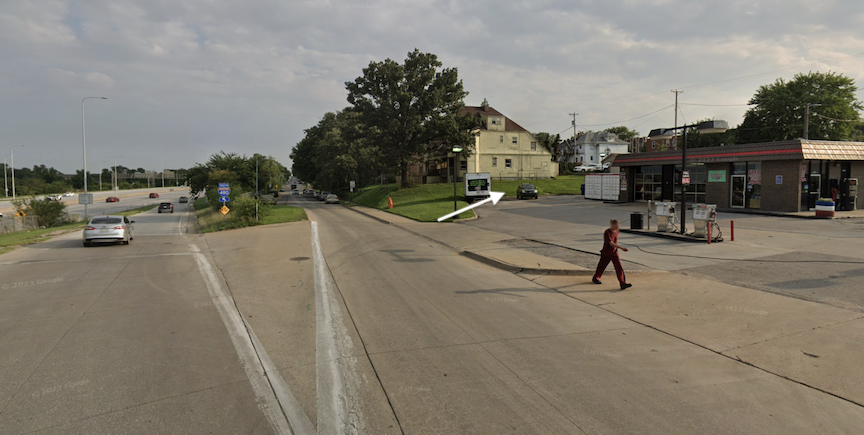
Fred’s Friendly Services auto shop at 2901 Leavenworth Street (RIP), running alongside the Leavenworth-29th Street entrance to the Gerald Ford Expressway (Interstate 480). Not as lovely, is it? The white arrow points to general area that the Beckman house would have stood.

The once 814 South 29th Street house site, to the south of the Fred’s Friendly service station. I am going to miss that place.
I go on and on about this original Beckman home because it was here that lifelong family connections and habits were formed, which were later replicated at our 3316 Center House of Mystery. The Beckmans, much like other families of this time period, were close-knit and seemingly insular by today’s standards. Some siblings moved out, others did not. Sister Marie Josephine Beckman married in 1909 and left the family home for New York City.
**I just now put the pieces together and it resolved an Investigative Itch. Please excuse this abruptness–Marie Josephine Beckman married Mr. John J. Naven. Mr. J. J. Naven was something of a talented peacock, “well known in musical circles.” For good reason–Mr. Naven had been director of Omaha’s Grand Opera and was featured as “the talented Omaha tenor,” showcased in various choirs and musicals in his two years in our town. In case Omahans thought him too haughty, there were inferences to a human grounding. “He hold a responsible position in the government service.” You know how we get around here. Turns out J. J. Naven was formerly an employee of the Omaha Postoffice. Did he meet Annette Beckman there? Regardless, Mary Josephine and J. J. Naven were off to the Big Apple. Mr. Naven worked as a “vaudeville vocalist,” among other things, under the stage name of “Shannon.” Within a short time he became John J. Shannon, a well known singer and actor with the Ziegfeld Follies in the 1920s. He appeared with Fred Stone and later played the lead in a radio series.**
And that is how Mary Josephine Beckman Naven, became Josephine Shannon. I did not find that Josephine and John J. Shannon had children. Brother Tony Beckman, also employed with the Omaha Post Office, would also move out and marry. At the time that Tony Beckman registered for the World War I draft registration in 1918, he listed 2114 South 34th Street as his address. He was 34 years old. He had married Josephine A. Pinault Beckman in 1912; the couple had one daughter. The oldest, Annette, and youngest Edith, never removed from their parents’ home nor one another’s side until death. Annette, fifteen years Edith’s senior, plodded away as a constant bookkeeper at the Omaha post office through her whole working life. It is telling that Edith, raised in Catholic schools by the Sisters of Mercy, dedicated herself to organizing others in honoring the Sisters as a young person.
At the age of 52, Mrs. Ida M. Beckman passed away in the family home at 814 Georgia Avenue (South 29th Street) in May of 1910. Father Joseph, the cigar maker and widower, continued to reside in the same house with his two daughters at the time of the 1920 U.S. Census. Young Edith worked as a lawyer’s secretary, no doubt an influential experience. Father Joseph Beckman then passed away in the family home two years later. The 1940 Census disclosed Annette and Edith still living together, just the two of them, in their parents’ house at 814 Georgia Avenue (South 29th Street). They never married or moved out, until packing up for the Abbott’s 3316 Center Street home. Let it be known, Miss Cassette recognizes it is not everyone’s goal in life to marry or have children.
The Real Edith Beckman
While Edith Katherine Beckman worked as a stenographer in John C. Wharton’s law firm, she graduated from the Omaha University Law School and was admitted to the bar. After passing the state bar examination in Lincoln, Edith K. Beckman became the “only woman admitted to the practice of law” (presumably in Nebraska) in November of 1925. Beckman again made history as “the first time a woman lawyer appeared in district court against (male) lawyers”—the year was 1927.
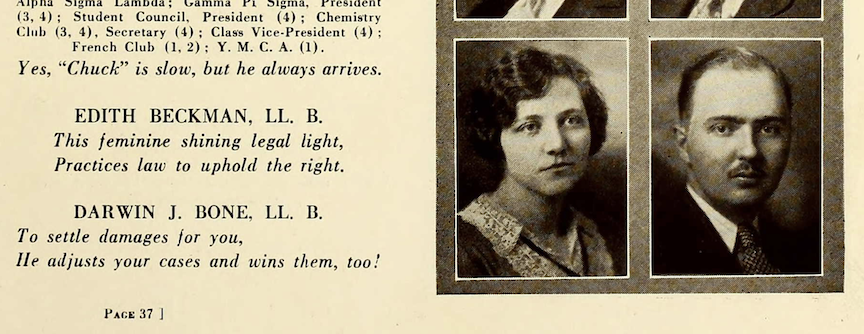
University of Omaha Tomahawk Yearbook.
By 1928 Miss Edith was elected president of the Women’s Division of the Chamber of Commerce. It was during this time period that Edith was also a performing musician and like David Abbott, played several instruments. Goggle-eyed, I chanced upon evidence she performed in Blackface with a group of musical women in the late 1920s, as part of a “Darktown” Minstrel Show. I didn’t include that photograph.
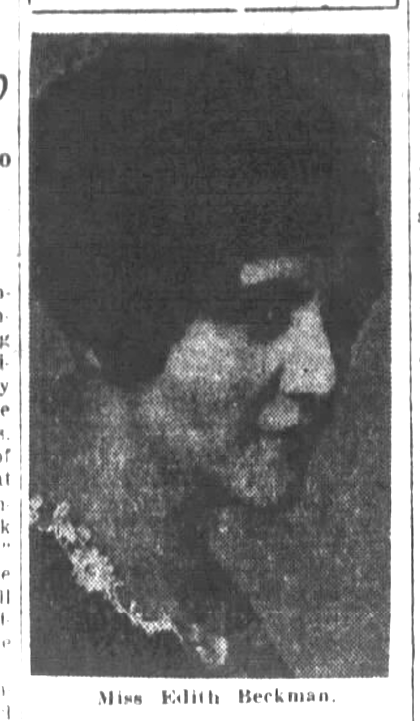
1928. Omaha Daily Bee.
In the late 1920s Edith was one of three active women lawyers in Omaha. For perspective, by 1963 there were only four women in private practice in Nebraska. A Democrat, she was appointed to the Nebraska House of Representatives in the special session in 1935. She was an unsuccessful candidate for election the Legislature in 1936 and 1938.

October of 1935. The Omaha Evening Bee News.
Edith Beckman found her niche of practice specializing in titles, real property, and estates but she also seemed to handle more than her fair share of divorces. Perhaps due to these fields of interest, Edith’s name was discovered on many Omaha deeds, where properties were moved into her name. I would understand if Miss Edith was drafting a new deed or correcting a deed or preparing one for a client in some way. It seemed unusual to me but maybe someone with a law background can shed light. Of note, I found her “re-applying” for license to sell real estate in a civil suit dated January of 1952. I would pore over this event for a bit too long. It appeared that Edith, in her role as legal guardian of Joseph E. McCabe, previously deemed “incompetent,” wanted to sell some of McCabe’s real estate. Why she needed a license to do so was not something I ever found out.
Richard J. Beckman, Edith’s nephew and fellow lawyer, would join his aunt in her law practice in 1939. In addition, Mr. Beckman was a bonded abstractor. They formally established their partnership in 1942 and named it the Beckman & Beckman company. The 1951 City Directory listed 203 Keeline Building as Edith Beckman’s legal office. The same Keeline Building saw several Beckman moves in the years that followed.
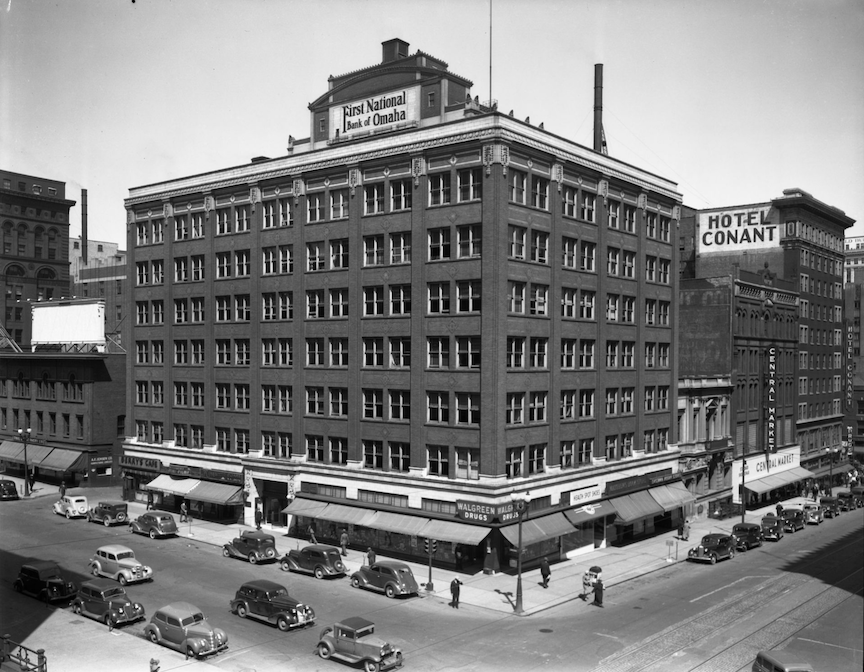
View of the northeast corner of the Keeline Building located on 17th Street and Harney Street. Wentworth, William (1892-1982). The Durham Museum. 1938.

April 5, 1940. Our Sunday Visitor. I enjoy the “political advertisement” warning, meanwhile “(Non-Political)” notice in the same pronouncement. In 1940 at the age of 43, Edith Beckman ran for Douglas County Judge. She was the youngest candidate and the only female. I found no evidence that she became a judge but would be glad to no otherwise or to include others’ findings
The Beckman Sisters Arrive
Since the City Directories from the research library are missing a few years, I was unable to locate any concrete evidence that the Beckman Sisters moved directly into David Abbott’s 3316 Center Street house after Mrs. Lona Hall moved out. Clues: Person named “Beckman” listed the 3316 Center house as a rental in July of 1942. The Beckmans, in turn, put their family home at 814 S 29th Avenue up for rent in October of 1942. There is a high probability they moved in straightaway. The sisters’ original family home would become a source of income like the 3316 Center house had been beforehand. Furthermore, Edith and Annette also owned additional properties in the town that they might have rented out for income. The more I studied them, the Beckman Sisters possessed intelligence and knew how to preserve and increase their family wealth. The next available City Directory of 1945 displayed Annette and Edith living in the 3316 Center house. Also of note, when Mr. J. J. Naven “Shannon,” the New York City vocalist, suddenly died in 1940 in Queens, New York, Sister Josephine Beckman Naven “Shannon” joined her sisters in living at the 3316 Center house. (John J. Naven Shannon is also buried in Omaha with the Beckmans.)
The 3316 Beckman home was filled with fine furniture. A Chickering and Son concert grand piano, a walnut and marble-top bedroom set, mahogany beds and endless bookcases. Because of the variety of décor options for the regular American home from the subdued minimalism to the finery of earlier decades, I believe the 1940s were a particularly fascinating period for interior design. I would love to see photographs from when the sisters all lived there to compare to the Abbotts’ exotic decor.
Mysteriously, at some point Edith Beckman began telling the neighborhood children that her Craftsman Bungalow was haunted by the ghost of a magician. The specifics of this haunting are unknown. As David Abbott didn’t die in the home, my first thought was of Fannie Abbott or the other deceased relatives. But then I questioned if maybe Miss Edith made this story up to keep the local kiddies out of her garden or to have a bit of fun with them. I daydreamed that Miss Edith was hinting at a deeper concept and one that I tried to describe earlier—that of hauntology—that the Craftsman was a continuous “return,” filled with the persistence of elements from the past. Perhaps her and the house’s everyday was a steady stream of all things Abbott?
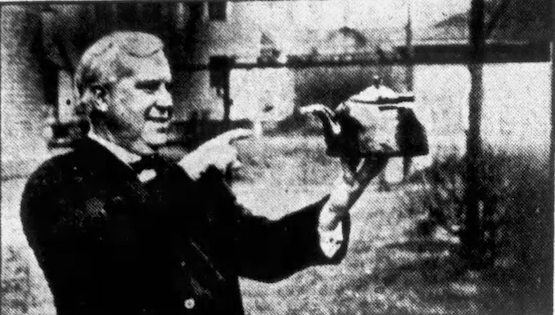
The Moonlighter
Pardon, as I take you on yet another Nancy Drew excursion. During my younger years, I was enrolled in a sequence of theater courses at a facility located very near 3316 Center Street filled with such fond memories. I needed to indulge myself and find out more about this very special place.
In the autumn of 1930, Mr. W. S. Wilkinson constructed a one-story frame bungalow and a business at 3504 Center Street in the Field Club Place addition. Winfield “Scott” Wilkinson and his wife, Anna Schrempp Wilkinson, lived in this 3504 Center house. They also operated an adjacent filling station called the Wilkinson Service Station. Following their highly publicized divorce in 1934, prompted by Anna’s allegations of verbal abuse, physical assault, and death threats from her husband, she began residing alone at 3504 Center Street. Unfortunately, she found it necessary to file a second protection order years later. Oddly when Anna Wilkinson died in May of 1948, Winfield was listed as her husband. Perhaps a formal custom in an obituary or did the couple reunite? Regardless, W. S. Wilkinson sold the large parcel to a Mr. J. C. Travis in 1949. John C. Travis, Sr. was an attorney and one time president of the Omaha Bar Association. Much like Edith Beckman, Mr. Travis kept an office in the Keeline Building.
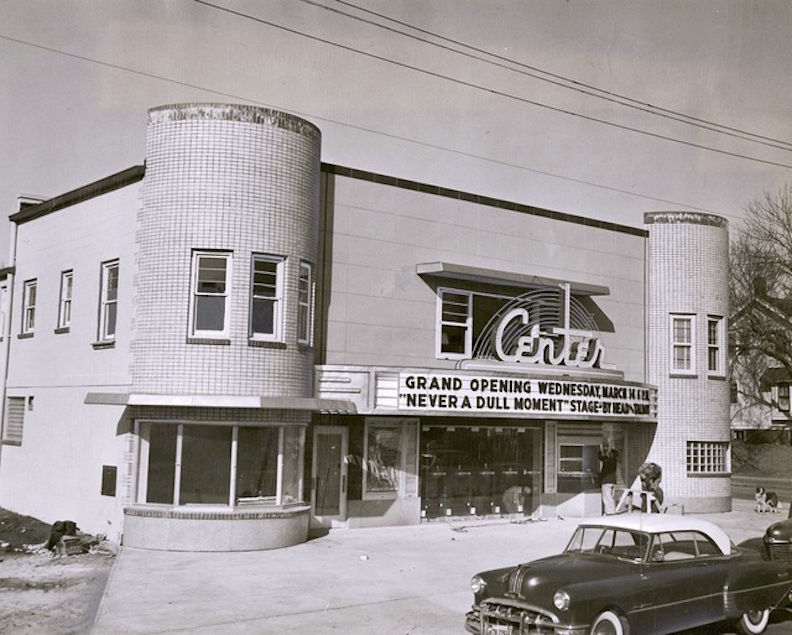
1951 image of 3504 Center Street borrowed from Cinema Treasures website.
All traces of the Wilkinsons were removed when in March of 1951, Omaha was introduced to the Center Theatre, one of the many wonderful little neighborhood movie houses that used to be sprinkled about. I found the Sunshine Laundry and Dry Cleaners in the “new Center Theatre Building,” as it was being advertised a few weeks later. By 1968 Bonnie’s Bridal Shop was renting on the second floor.
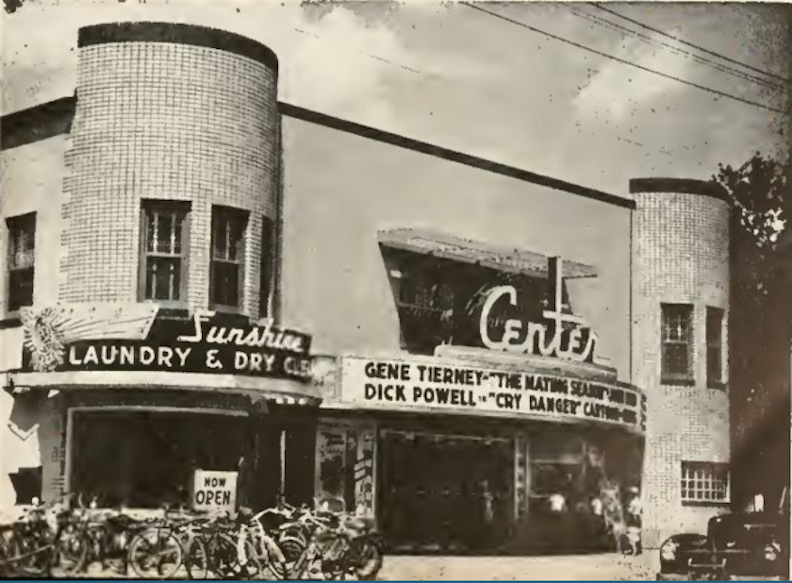
So glad to find a photograph that included the Sunshine Laundry and Dry Cleaning as well. Curious pairing of businesses but we like curious. Photo borrowed from Cinema Treasures website.
In the mid-1970s, the Center Theatre was shut down and subsequently transformed into the Omaha Junior Theater. The Omaha Children’s Theater was established in 1949 at another location by Omaha Famous, Mary Elizabeth “Emmy” Gifford, a noted painter, sculptor, sketch artist, and theater-set and costume designer. I recall that it was referred to by that name at least in my early time attending classes, however it is possible that this was amidst the transition to the Emmy Gifford Children’s Theater. In 1993, the program relocated to the Astro Theater, later renamed the Rose Blumkin Performing Arts Center, usually referred to as “The Rose.” After its time as Collector’s Choice estate/consignment sales business, the little theater was purchased in 2021 by Milt Schneider and his wife, Leah Moreno Schneider, who are said to be transforming it into a dancing studio, event venue, and community center.
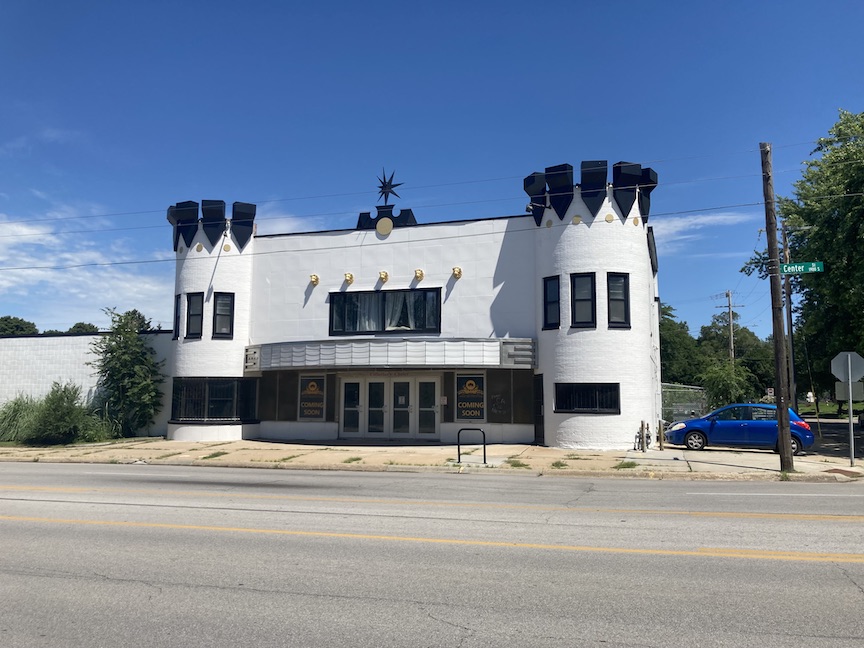
3504 Center Street, as it looks today. Crisp and dynamic, the wonderful neighborhood theater now is hostess to the Hispanic Art Center of Omaha. The dream worthy structure is at the west end of the 3316 Center Street alley and adds a bit of drama to the surroundings.
Shadow of a Doubt
In August of 1952 the City Council received a shocking recommendation from the Omaha Improvement Commission (OIC) designating Center Street as the new route for the proposed “Southwest Radial Highway.” According to preliminary plans, the new highway would traverse down Center Street to the east, swing north on 32nd Avenue and cut across the northwest corner of Hanscom Park. It also called for 32nd Avenue and Center Street to be widened, cutting into the park for the route. Rather than widening Center Street for the route, Edith Beckman proposed widening Q and 24th Streets “This would be better than using the money for this cow path with all its turns.” Yes, she called it a Cow Path. The Board of Education also requested more time, noting there were five schools “within one block or right on the route.” Locals drew attention to Andrew Hanscom and James Megeath’s restrictive covenants that allowed only park use, when they gave their land to the city for Hanscom Park.” It was determined that under the terms of the bequest, the Hanscom Park land would revert to the Hanscom and Megeath heirs if the city used it for anything but the stated purpose. In agreement were nearly one hundred neighborhood residents who came out in objection to this OIC route choice, forcing Mayor Cunningham and the Council to delay vote in order to study the OIC recommendation. This plan would get turned down again and again with Center Street neighbors charging that the thoroughfare through the residential area would reduce home values.
According to the Carl Schrat family, who later bought the 3316 Center Street house, they heard Edith Beckman was also involved in another tiff with the City of Omaha. Ahem…the old meaning of tiff with the city and not the new Tax Increment Financing “TIF” financing tool used by the City of Omaha. Older neighbors had told the Schrats that in the distant past the city wanted to continue an alley across the 3316 Center property. They were unsure of the time period. The alley currently runs north and south and is located across Center, where it extends southward. Connecting the alley to outstretch to the north side of Center would have cut along the east side of the Beckman house, on the very land that the Abbotts adjoined to their parcel years after they built the home.
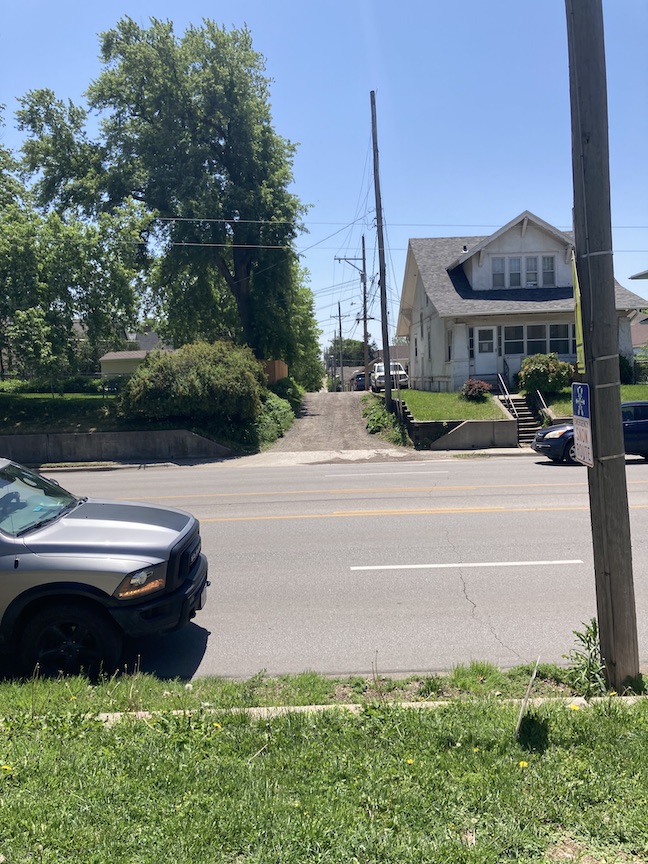
Looking south across Center Street, you will find an unpaved alley that leads to the south. Apparently the proposal and subsequent fight brought by Edith Beckman, was to keep this alley from plowing across her yard on the north side of Center Street.
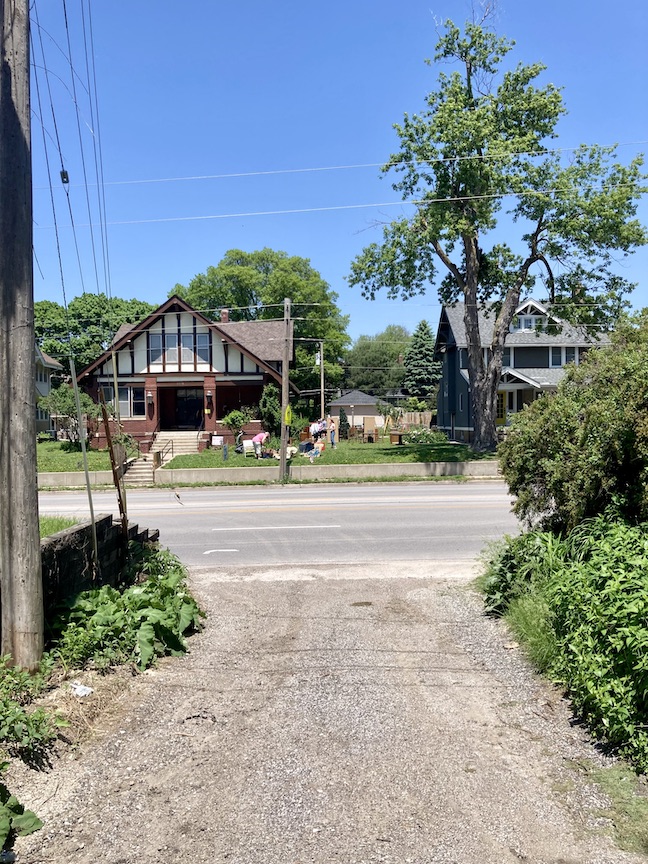
View of 3316 Center from the alley to the south. One can see how the continuation of the alley would have cut straight through the green space between 3316 Center and 3310 Center, directly to the east. This photo was taken during the estate sale in May.
This alley pathway never happened, according to lore, because of the efforts of Edith Beckman. It is unknown what benefit this short drive of alley could have served the city. This plan would have meant the northward alley would connect with the east-west alley than runs parallel to Center behind 3316. That alley has easy access entrances off of 33rd Street and 35th Street for both homeowners and truckers of yesteryear–coal delivery, trash pick up, dairy and ice delivery. Much of the Field Club Neighborhood is laid out in that manner. It is hard to understand how this proposal would have been easier for a utilities truck… or perhaps the storyline was a game of Whisper Down the Lane that got jumbled with the previously mentioned Cow Path advocacy effort.
Death of a Sister
It’s interesting to note that Annette Beckman and Edith Beckman were listed as the homeowners of 3316 Center in different years. Annette continued working at the post office long past the age that many retire and Josephine Shannon didn’t appear to work since her return to Omaha. But like her sisters, it did seem that she bought and sold real estate, possibly renting out properties for money. In November of 1956 Josephine Beckman (Naven) Shannon died in an Omaha hospital. As the clues have shown so many times before, there was something about that Abbott House of Mystery main floor that extended itself to funeral proceedings. Sister Josephine would lie in state at the 3316 Center residence, with a later funeral service around the corner at Our Lady of Lourdes. With more space in the house, a month later Edith Beckman would announce the big move of her law office into 3316 Center. She would start 1957 working out of her house. Beckman & Beckman were officially operating in the Craftsman Bungalow. Again, I would have liked to have seen the professional lay out or interior photos. Maybe we will find them in the future.

Brief Encounter
Carl Schrat was summoned to the Beckman residence to install a modern furnace in 1960. Like so many older houses in the area, the old oil heater was securely embedded in the cement floor of the full-length cement basement. Back in those days, Carl Schrat was one of only 25 people in Nebraska that installed home air conditioning and he’d been in the heating industry a while. When he stepped into the home, Carl Schrat didn’t know of the house’s history or anything about it. Struck with the beauty of the home, the sheer volume, and the gorgeous woodwork, young Schrat bravely told Miss Edith Beckman of his desire to purchase the house someday. He still remembers the way Edith informed him that he would never be able to afford it.
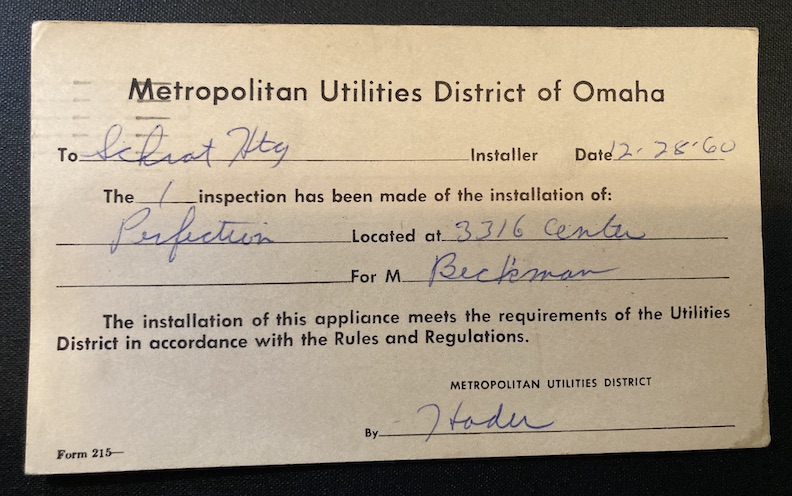
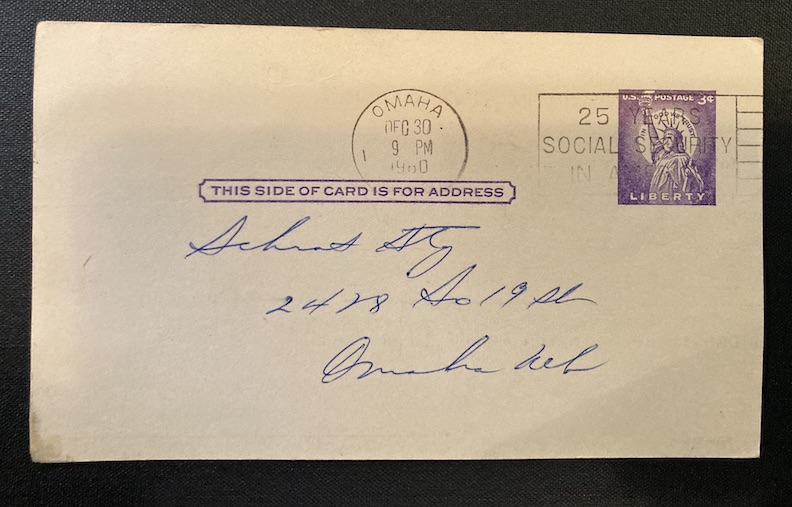
December 28, 1960. Subsequent to a heating installation, a Metropolitan Utilities District inspector would pop by the job to make sure it was completed correctly and to MUD standards. This card was sent to Schrat Heating after Carl’s installation at 3316 Center Street met approval with MUD. Carl kept the card all these years and I just love that. It would later emerge that this wasn’t the only treasure that the Schrats held onto as keepsake.
Beyond the Law
Edith Katherine Beckman died February 10, 1966 in a local hospital. A rosary wake was held at the 3316 Center House of Mystery—it stands to reason, in the large parlor room. Mass was held the next day at Our Lady of Lourdes and Edith was buried at Saint Mary Magdalene Cemetery. Annette Beckman, the oldest and lone Beckman sibling, lived on to see the age of 85. She died in November of 1968. Brother Tony had passed in 1961.
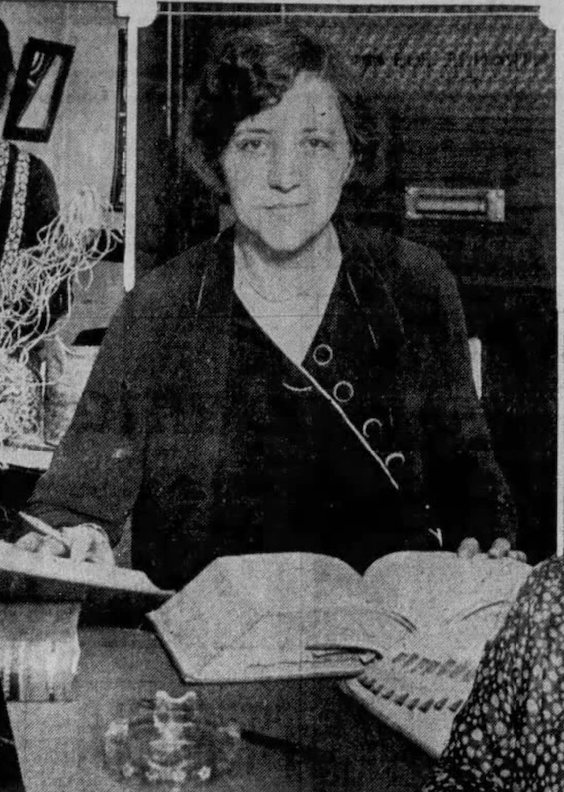
Miss Beckman in 1929.
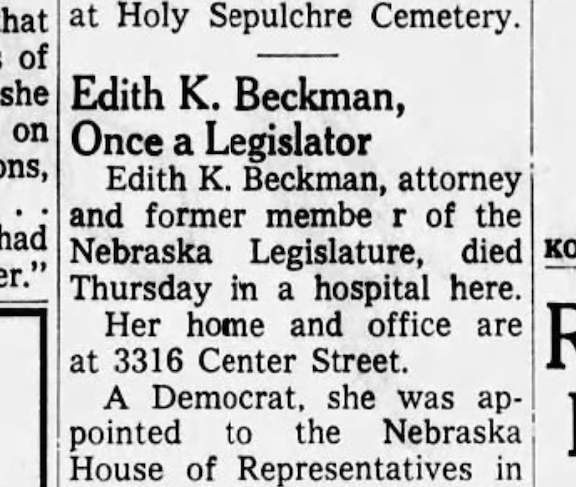
1966. Evening World-Herald.
The Brick Show Place
After Edith’s death, the 3316 Center Street home and office went on the market in April of 1966. It was called a Brick Show Place. Rightfully so. The advertisements boasted of a “magnificent living room and large formal dining room.” These were wonderful compliments, but we already knew her to be The Silent Star.
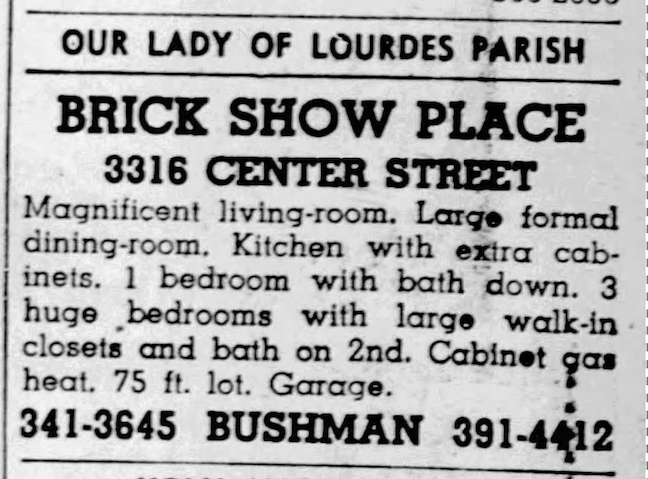
April 1966. The True Voice. When Sister Annette, a sister in law and nephew put the house on the market, they had no way of knowing that David Abbott’s long lost manuscript and treasured writings were kept within the home. Or perhaps they knew and didn’t care. What all was tucked into those glass shelves or in the little door hideaways upstairs?
Carl Schrat must have kept his eye on his dream home because soon after, he purchased the 3316 Center Street house in 1966 for $16,000. When I met with him recently, he confirmed the home was beautiful and suited his large family. “We liked how big it was.” He also let on he had long held the mindset of getting his wife, Lenora, whatever she wanted. I don’t often write about current owners of the homes that I am investigating for privacy reasons, but because I had the opportunity to meet with Carl and some of his family members, I will share brief snapshots of their life just to help everyone see the beauty of what transpired in the following decades of this home.
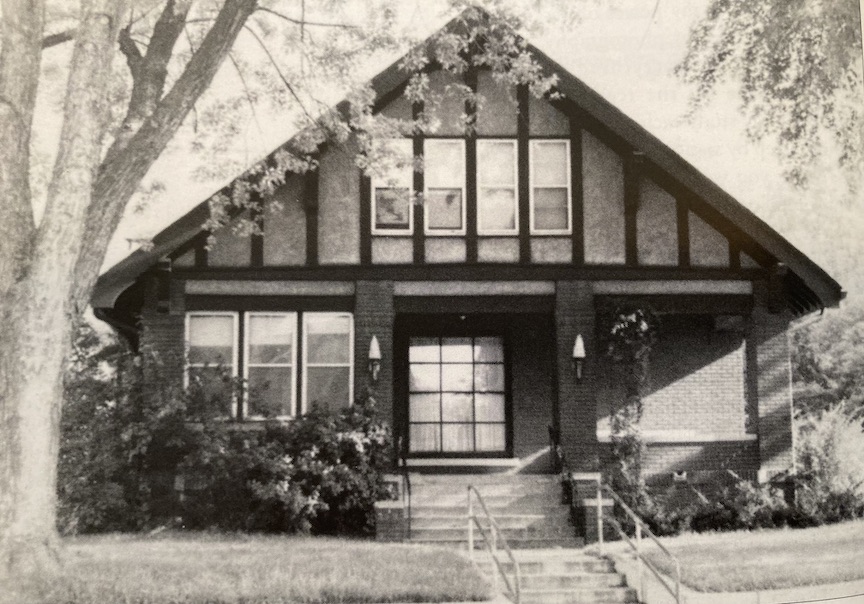
The Schrat Family
Karl Ludwig Schrattenberger was born in Vitshofen, Germany in 1905. The Schrattenbergers were Bavarian. At the age of seventeen, he traveled to New York in January of 1924 and according to his Petition for Naturalization paperwork, became a citizen of the United States in November of 1939. Karl became Carl, and his surname was abbreviated to Schrat. But before his citizenship, I did find references to Carl Schrattenberger tied to his employment, where he worked as the janitor-engineer of the St. Peter’s Church and School (709 South 28th Street) in the early 1930s.
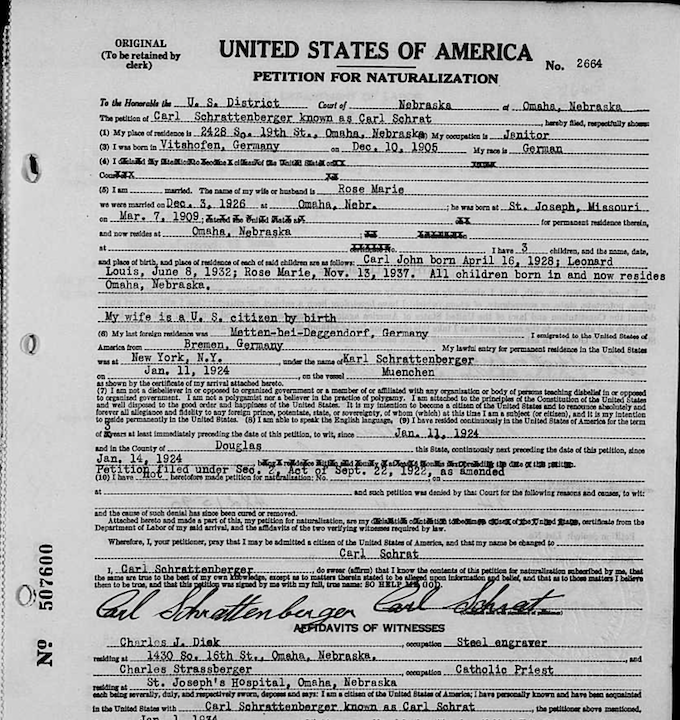
Carl Schrattenberger Nebraska, U.S., Federal Naturalization Records. 1939
Carl L., Sr., worked with furnaces and was considered an engineer. This is potentially where his son, Carl J., Jr. learned his trade. Carl L. Sr., would become infamous city-wide when he was blown 15 feet across his boiler room in the St. Peter’s Church in March of 1936.
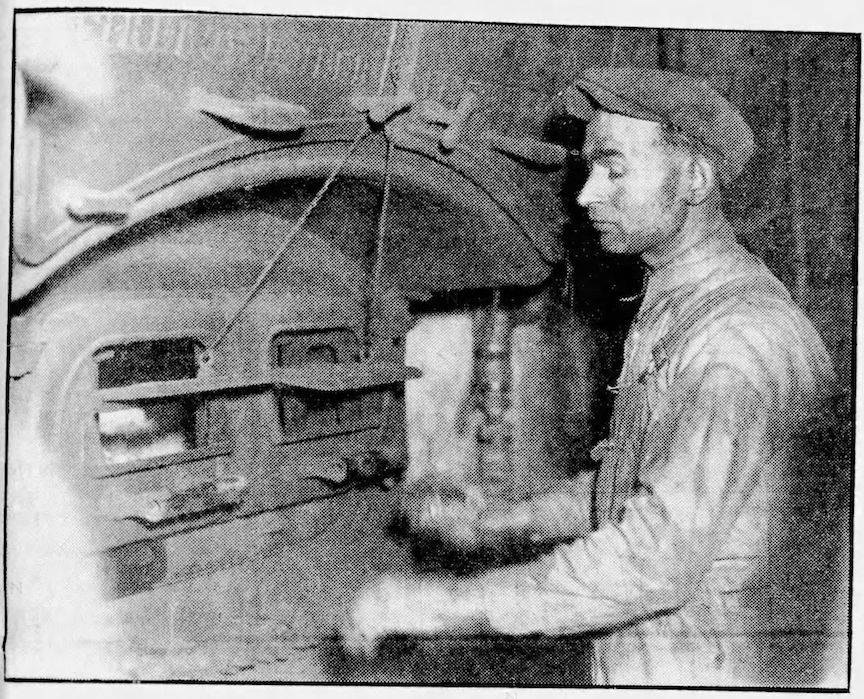
March of 1936. Omaha World-Herald.
Carl L., Sr. was engineer and janitor at the St. Peter’s Church and School at 27th and Leavenworth street. “Was blown 15 feet across the boiler room by the force of an explosion in the flue.” Firemen would come to believe that gas accumulated in the flue, ignited and then exploded. Amazingly no damage was done to the furnace or boiler; initial reports denied that Carl was injured. I’ve got to think that didn’t know to look for unseen injuries in those days. The force of the blast was felt up to six blocks away, a number of people were knocked off of their feet, and neighboring buildings’ windows were shattered.
Carl L. Schrat married Rose Marie DeKorsey in December of 1926. The DeKorsey family were originally from Austria, although Rose Marie was an American citizen, born in St. Joseph, Missouri in 1909. The Schrat couple had three children. Sons Carl John (who purchased the Abbott-Beckman house) was born in 1928, Leonard Louis born in 1932, and daughter Rose Marie “Rosie” Schrat Gerch born in 1937. They made 2428 South 19th Street their home.
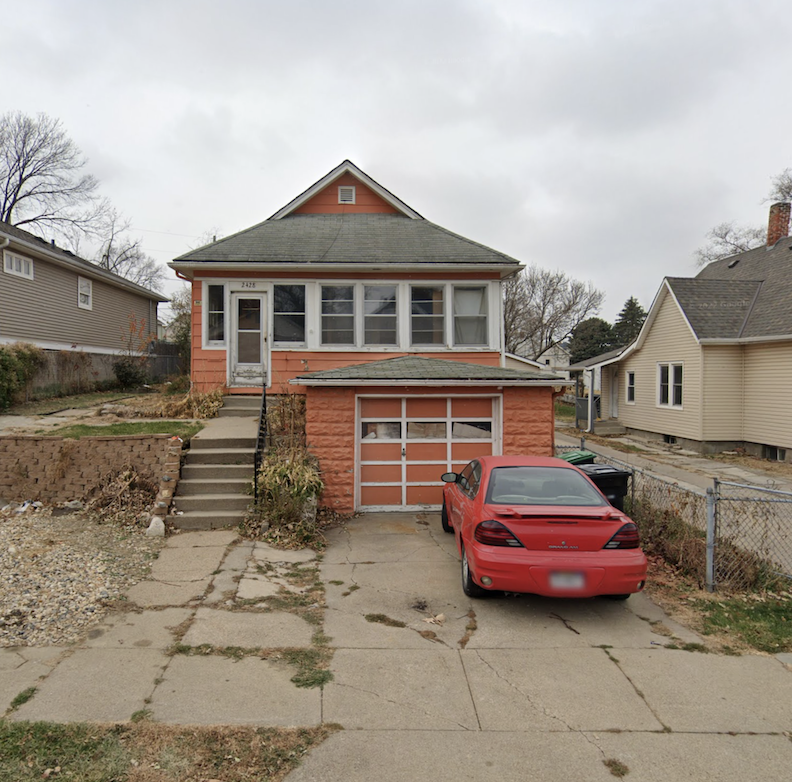
The 2428 South 19th Street, on paper, appeared to begin its long life in 1900, as a three-room cottage. It was altered by several owners over time to become the home it is now. Father Carl L. Schrat, for instance, constructed the garage in 1939. The house was a hive of activity, and Grandmother Marian DeKorsey resided there as well.
Carl John Schrat
Our Carl J. Schrat, Jr., who would come to purchase the Abbott House of Mystery, grew up in South Omaha in this 2428 South 19th Street home. The brief mention in The South High Tooter (love the newspaper name) announcing young Carl Schrat had paid up and was “an early signer” for the January 1945 South High Prom touched my heart, because not long after, Carl was on a naval ship on the ocean. Schrat was one of the younger World War II veterans, enlisting at age 17 and serving with the U. S. Navy–so young that “he received his South High School diploma on a naval ship in the Pacific Ocean.”
I pinpointed the U.S., World War II Navy Muster Roll of 1945 where they logged young Carl John Schrat on the U. S. S. Salerno Bay, on May 19, 1945. When I consider what I was up in May of my senior year of high school, it is hard to fathom the strength and mindset of Carl. In looking for photos of Salerno Bay, I discovered during its construction, the ship was renamed Salerno Bay, after the invasion of Salerno in Sicily the previous year. On May 19, 1945, the ship was commissioned into active service, the very day 17-year-old Carl J. was “first received on board,” according to the crew roll. Toward the end of June of 1945, Marine Carrier Group 5, which consisted of fighter squadron VMF-514 and torpedo bomber squadron VTMB-144, boarded Salerno Bay. After training exercises off southern California, the ship deployed to combat in the western Pacific. The last muster roll of the crew that I could find including Carl J. Schat’s name was April of 1946. (I do not have Carl’s military record and this is in no way representative of his complete service—just what I was able to find.)

Broad on, port bow view of the recently commissioned USS Salerno Bay (CVE-110) underway, June 3, 1945. Photograph borrowed from Navy Source Online website. Photograph by David Buell.
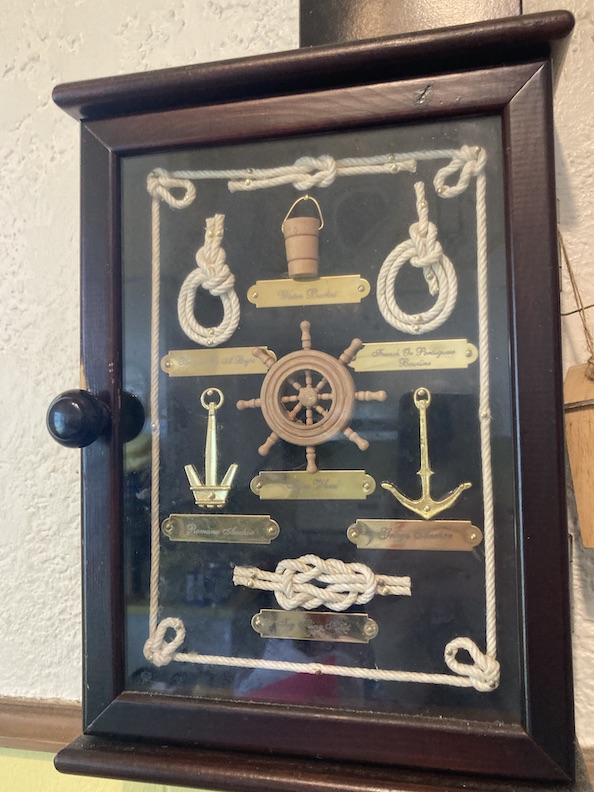
Side Note: One item I really lit on when I first went to the David Abbott-Edith Beckman-Carl Schrat home was this tiny cabinet of bowlines, miniature anchors, and all things Navy, labeled with small engraved plates, hanging in the family kitchen. After discovering of Carl’s service it all makes sense. There are a number of things happening within this wooden box that I adore. I am drawn to anything small scale, obsessively attentive, touching on the academic–pinning and preserving of specimens, maximalist, while delighting because the theme is rooted in practicality. Although knot tying is an art, isn’t it?
According to the Nebraska Index to Marriages, Carl J. Jr., and wife Lenora “Tiny” married November 18, 1948, in Douglas County. When I asked Carl why they called his wife “Tiny,” he spelled out that she was a twin, the second born and the smaller of the two. He went on to explain, “My wife had grown up poor. Her mother died when she was young and her father raised ten children alone, taking whatever job he could. I wanted Lenora to have whatever she wanted.” I understand this pattern of loving indulgence extended to household items, furnishings, décor, clothing, jewelry… “The best of everything,” said one extended family member.
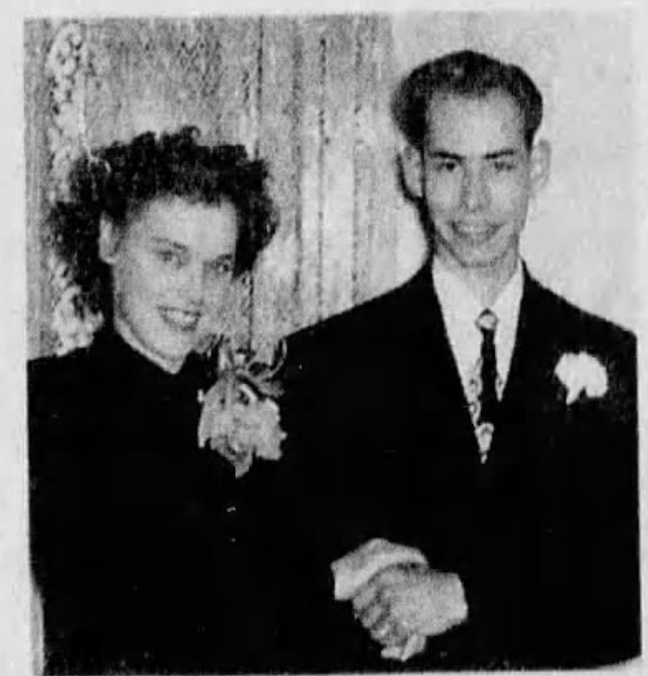
Tiny grew up in Lebanon, Missouri and Tekamah, Nebraska. She worked in the Mead bomb factory during the war. Situated 35 miles northeast of Lincoln, Nebraska, in Mead, a rural area of Saunders County, the former Nebraska Ordnance Plant previously covered more than 17,000 acres. The plant’s main purpose from 1942 to 1956 was to produce weapons at four bomb loading lines for World War II and the Korean War. Tiny met her future husband when they later worked together at Blue Star foods.

Carl and Lenora Schrat had five children: Susan, Steve, Kim, Kevin and Carl “Daren.” Lenora volunteered for the literacy council and loved to read and write. From my digging, the family lived in various early homes in North Omaha, settling at 2475 South 19th Street, down the street from Carl Sr’s home. I also found evidence that Carl Jr. would operate his furnace and air business out of this 2475 South 19th Street address for a time.
Open City
Father Carl L. Schrat had left the janitorial field and began operating a home-based business, providing “Winter Air Conditioning,” out of the garage he had constructed at 2428 South 19th Street. This I gained from a 1948 advertisement but he had possibly made the transition earlier.
At 1714 Vinton Street, I saw an advertisement for Carl Schrat Gas and Oil Installation in 1950. This was most likely a short-lived rental. Was this the business of Carl J. or Carl L., because no one in the family could recall Father Carl L renting out the 1714 Vinton space before Carl J. transitioned into the heating business himself. According to the Schrat family, by 1957 Father Carl L. had become a machinist at Falstaff and Son Carl J. assumed control of the Carl Schrat Furnace Company.

1950. One of a number of local German newspapers.
One thing was for certain: Son Carl J. subsequently changed his business’ name to Carl Schrat Heating and Air Conditioning. He described his move to 1714 Vinton not occurring until 1958. He made this South Omaha location his until he retired not too long ago. At 90 years of age, Carl J. Schrat was still installing furnaces and air conditioning units. (!!!)
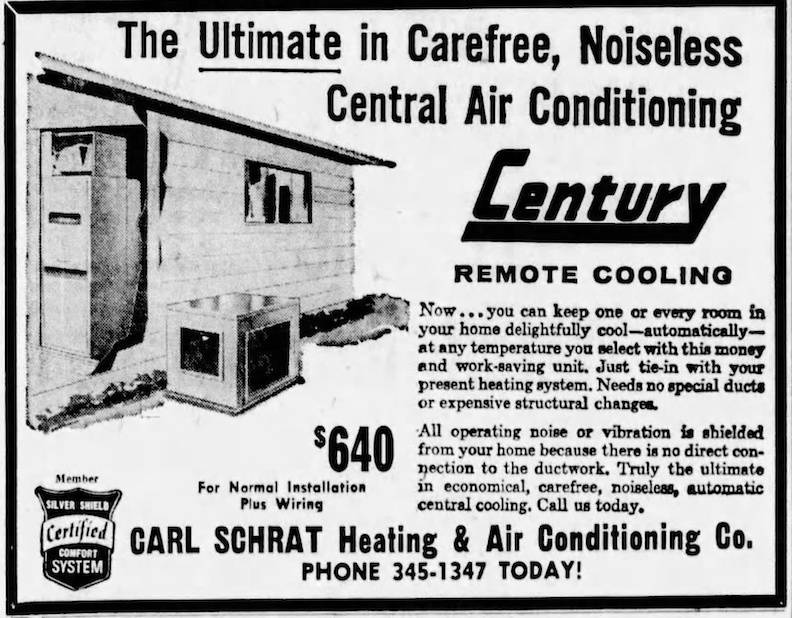
1962. The modern Carl Schrat Heating and Air Conditioning Co. advertisement.
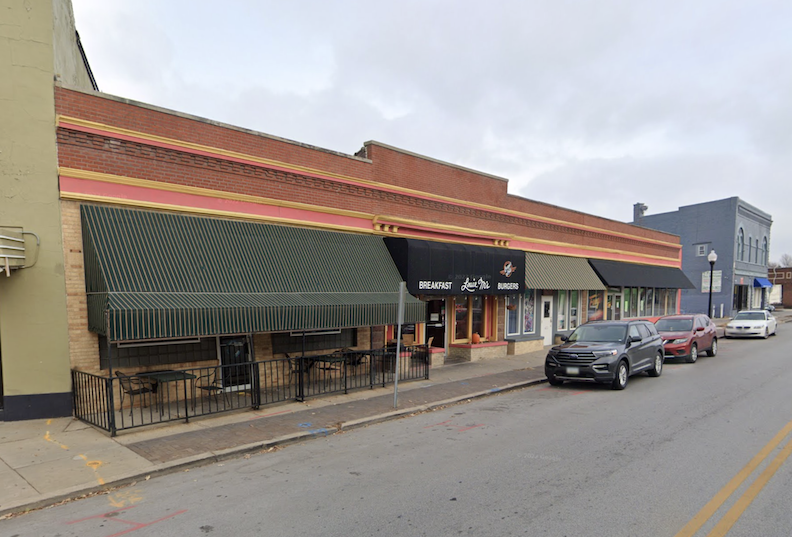
Louie M’s owns this block of connected buildings and it is made up of a number of addresses. 1720, 1718, 1714 and 1710.
Back in 1894, Fritz Miller’s bar was located at 1714 Vinton. The address functioned as the Vinton Toggery by 1912. In 1929, Henningsen Electric Co. was up to bat. The Radio Clinic by 1937 (great name) and The Ideal Potato Chip Company by 1938. As to my neurotic pursuit, the current 1714 Vinton was hard to track. It was within the Vinton Street Historic Commercial District but it’s address had disappeared. 1714 appeared to be a bay in the string of shops now owned by the Louie M’s empire (1718 Vinton Street), potentially with a side door into a parking lot. The Schrats gave explanation that Carl J. would move to the spot next door to the current Louie M’s Burger Lust in 1960. The location appeared to most recently host Elva’s Gallery, potentially defunct.
Return to 1966
Soon after the Schrats bought the Abbott-Beckman 3316 Center Street house in 1966, the Beckman family organized an estate sale to assist in removing the belongings from the house.
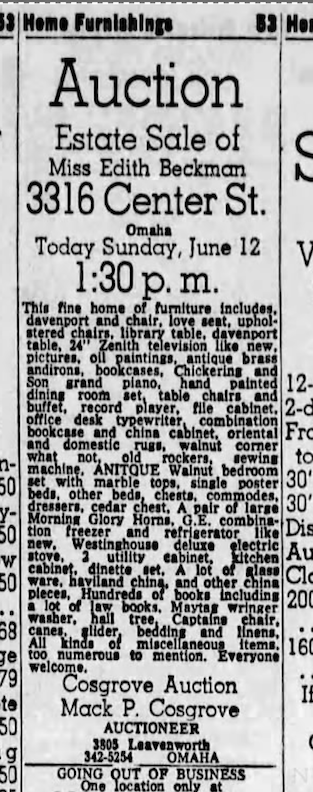
June 12, 1966. Omaha World-Herald. Reading of Edith Beckman’s treasures helped me to envision her household at 3316 Center Street.
Carl recalled a remarkable story that included a younger man, whom I speculated could have been Edith Beckman’s legal associate nephew. Carl witnessed this member of the Beckman family disposing of photographs, old documents, and other miscellaneous items that were not sold during the estate sale by burning them in a bonfire on the 3316 Center property. Carl reportedly instructed the man to leave the remaining pieces since he was confident his wife would like whatever was in the Beckman collection. Many years later, wife Lenora was quoted in the Omaha World-Herald as saying, “I found all sorts of interesting things. It amounted to the life’s work and legacy of a man relatively unknown to most of the world but whose fans spanned the globe.” These Salvaged Artifacts From the Flames were that of David and Fannie Abbott. Lenore discovered letters written by Sir Arthur Conan Doyle and Harry Houdini in addition to the highly detailed magical instructions to include tutorial photographs of David Phelps Abbott. Lenora Schrat wisely filed these treasures away, knowing and enjoying that the home’s original owners were something very special. She very possibly did not know that David P. Abbott had been working on a manuscript and that one day a true fan would come knocking.
**Addendum of July 7, 2024** Son Daren Schrat was going through his father’s paperwork and found a receipt in recent days from his parents’ purchases from the Edith Beckman auction back in 1966. Amazingly they kept this and it is in perfect condition.
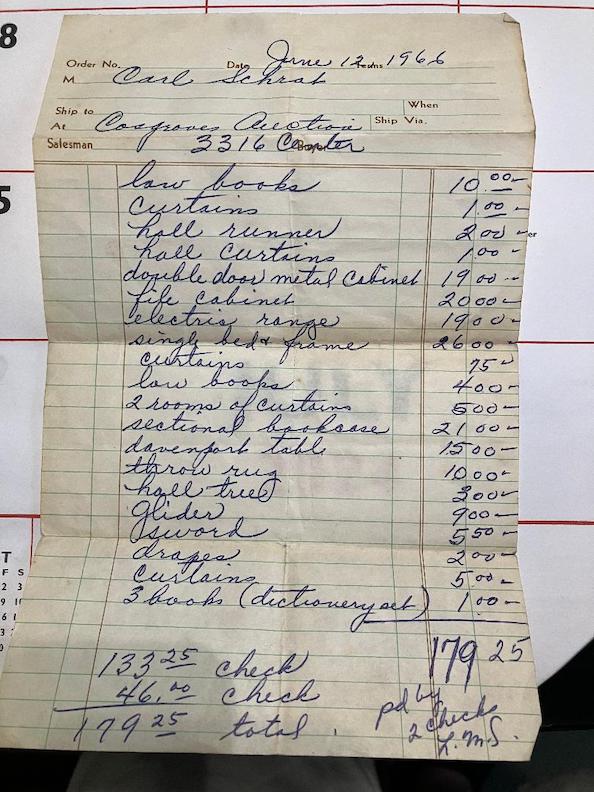
Cosgrove’s Auction. June 12, 1966. Remarkable. One can see that the Schrats bought many things from Edith Beckman’s in-house law office. I want to know more about the sword! Also I love a good glider.
The notion of the Schrat children growing up in this vast House of Mystery gave me pause. The individuals who had resided at 3316 Center to date were exclusively older, bookish, academic, and reserved. I imagined a slight clicking of leather soled shoes on the floorboards, the pantry door whooshing open and closed, a vintage 1940s telephone ringing on a small accent table, the ticking of a pendulum or was it the silence of an hourglass? Otherwise, those late-night magical performances, ghostly whispers, clinking and sipping of liquors and the houseguests’ babble of disbelief and nervous giggles, mingled with the occasional uproar of the playing of musical instruments and classical recordings might have been the only din 3316 Center knew. Oh yes, and Beckman & Beckman’s clients ringing off the door. The simple, sometimes, chaotic sounds of kids running across wood floors, arguing, laughing, fighting over bedrooms, pots and pans sloshing in the kitchen sink, launching miniature cars down the stairwell, a far-off television set, a hi-fi stereo. These are the reverberations of a family home and dare I speculate, or even try to speak for 3316 Center, but I am guessing she liked the chatter and crashes of young family life. In that recognition, I am sure the children didn’t reciprocate or care much about the history of their house because children have other demanding business to attend to. On that note, Daren Schrat, the youngest of the kids explained that the house is not haunted, although they used to joke that it was. From 1966 to 2024 the family has called 3316 Center their home and to view it up close and personal, one can see that she was held dear.

The upstairs’ hall.
City of Chance
The well told story goes that in 1974, Omaha magician and businessman, Walter B. Graham, dialed up the Schrats. He had intended to locate some of Abbott’s belongings in an effort to publish his book, a feat that David Abbott (and Fannie Abbott) was unable to accomplish during his lifetime. Walter Graham dedicated many years to uncovering the secrets behind Abbott’s illusions, specifically the writings and images that were thought to be contained in his unpublished manuscript. He had an inkling they must have remained contained in the house in all the decades. Imagine Mr. Graham’s happiness to find that Lenora Schrat did have these lost items. The Abbott collection consisted of photographs, letters, newspaper clippings, and written works, all organized in four green binders. I wondered if Lenora neatly filed the four binders?
As with all good magicians, I am told, Mr. Graham had a fascinating history himself and lived in the perfect suburban home at 1010 South 91st Circle. I have crept near this slice of the celestial sphere in a previous article, for Graham’s cul de sac acreage was once a piece of the sprawling Gene Melady estate. For more on that investigation: The Ballad of Balla Machree.
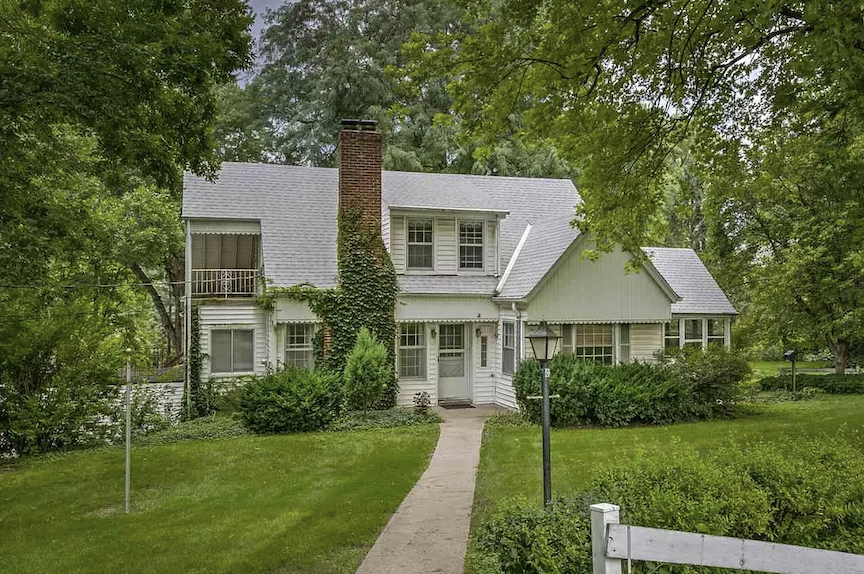
1940’s dreaming at 1010 South 91st Circle–complete with a knotty pine study.
As I won’t be delving into Mr. Graham’s contributions or history due to time and space constraints, and the plain fact that we are very near our closing, please read this lovely homage to him: https://omaha.com/life-entertainment/omaha-magician-walter-graham-known-for-work-as-magical-historian/article_bcc8d9c4-f25a-11e7-ae7d-5fd289a8df61.html
For our purposes, in 1977, Walter Graham, a magician, magic historian and serious Abbott Fan, privately published David Abbott’s authored book through his own company, Modern Litho, Inc. The Book of Mysteries by David P. Abbott was finally released after his death by Walter Graham. The book had a limited edition of 700 copies. Not everyone is suited for the deep, obsessive detective work that “Walt” Graham did in hunting down the archival works of David P. Abbott but at this juncture we must give this man full credit for our very gathering today. And while we are at it, Carl J. Schrat for saving the heap from the bonfire. And another round of applause for Lenora, for organizing and keeping the Abbott collection in tip top shape.
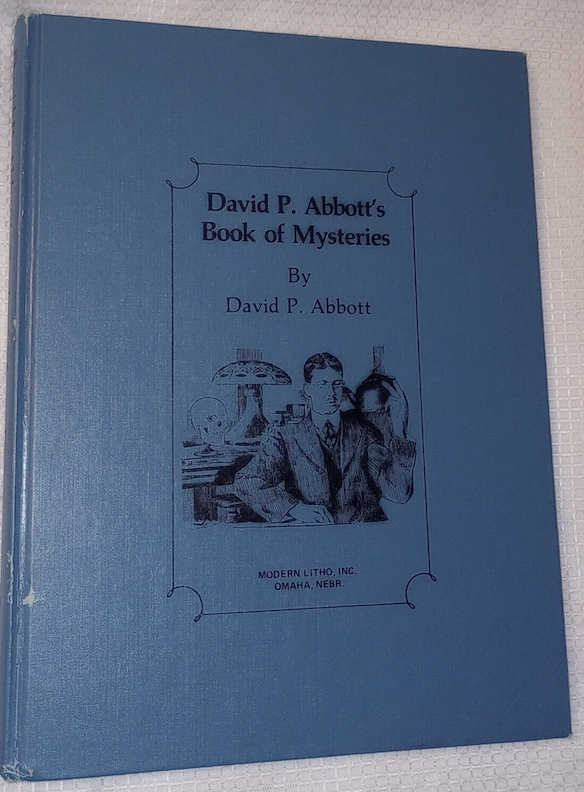
In 2003, Teller from the renowned duo Penn and Teller visited Omaha with the purpose of meeting Walter Graham. The two would remain friends. Teller acquired the rights to the book authored by Abbott, published by Graham in 1977. The doorbell at 3316 Center again rang but this time Walter Graham had brought Mr. Teller. He was able to ask the Schrats questions and tour the 3316 Center Street home. Teller released his two-volume book of David Abbott’s writings in 2005.

House of Mystery: The Magic Science of David P. Abbott Volumes One and Two edited and compiled by Teller and Todd Karr (2005) is a breathtaking tome. Much sought after in the magic realm, the book is out of print and fetches a pretty penny these days. Teller and Karr were able to assemble Abbott’s five previously mentioned books and pamphlets, in addition to Abbott’s material from notebooks that had not been published and from periodicals that had been published but not accessible. It is a glorious accomplishment. Hardbound w/dust jacket, two volumes, over 900 pages total, more than 700 illustrations. The image shown above is the Deluxe version.
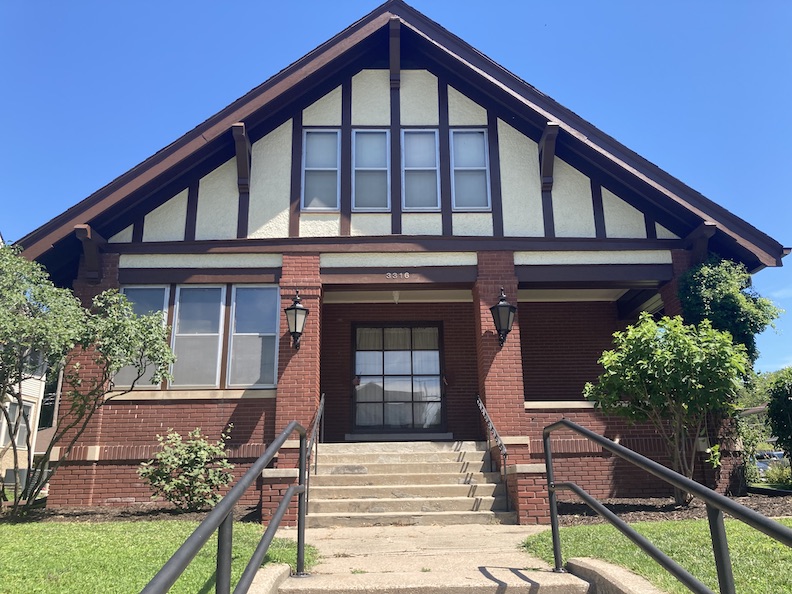
The Very End
Ladies and gentlemen, there are two kinds of architectural investigations: those that you can take to bed with you and they relax you and put your mind at ease and then – there is the other kind. The kind that invigorates the imagination. The stirring kind. Have you decided for yourself?
I wouldn’t be me if I didn’t get a wee bit teary at this part. Because of this, we will luckily all duck away without much fanfare or goodbyes. Maybe some fell asleep long ago. There are just a few assignments I’d like to leave you with. This beautiful, big, rich home is for sale. We must find her the perfect new owners who understand her past and love her for it. See below. Also we must find her stolen art deco fire or ice porch lamps. Someone knows the truth.
This July 4th there will be an open house and I welcome you all to come have a peek around. Just as I have every time I come face to face with the House of Mystery at 3316 Center Street, this is your chance to say, “Well now, let’s have a look at you!”
Real estate listing agent: Barb Zorn
Her phone number: 402-378-2976.
Email: barb@rogauthentic.com.
3316 Center will have an Open House on Thursday, July 4th at 11 am to 12:30 pm.
Here is the link to the real estate listing: 3316 Center Street, Omaha, NE 68105-BHGRE
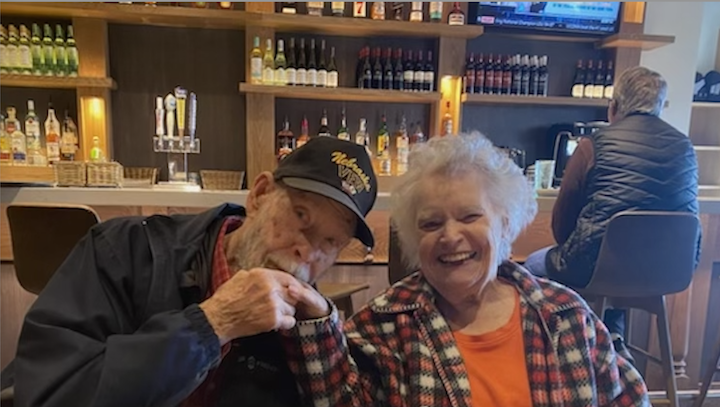
Carl and Tiny.
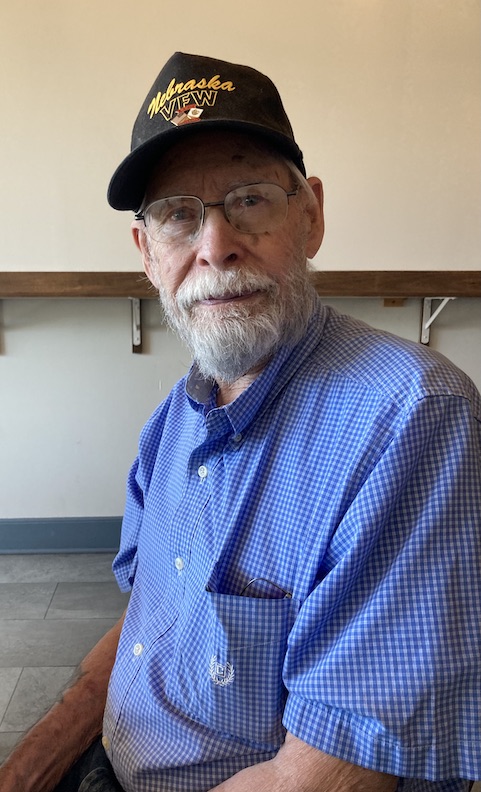
This article is dedicated to Carl and Tiny Schrat and their family. Working on this article was such a powerful experience for me and I was honored to meet Carl in May of this year. Special thanks also goes out to Barb Zorn for her constant communication and good cheer.
“MYSTERY IN THE AIR” THEME TO SHIMMER…THEN DOWN AND OUT
This is Miss Cassette from the Cassette Detective Agency wishing you all a pleasant – goodnight – for Camels.
**Addendum of September 17, 2024:
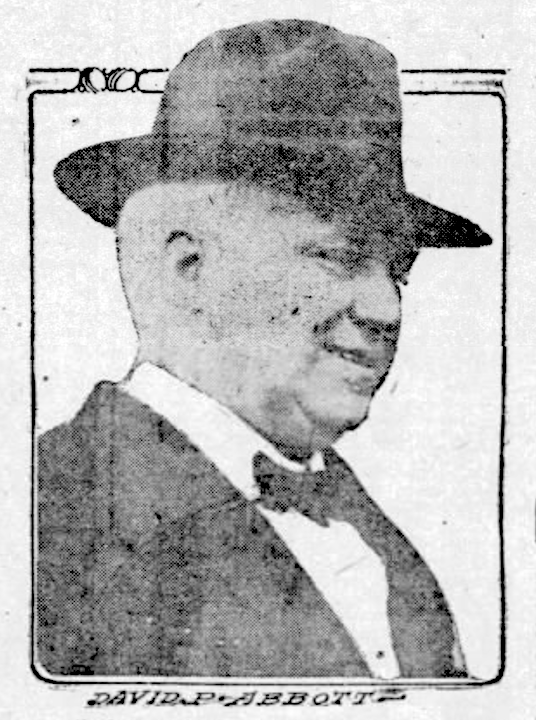
I welcome your feedback and comments on this fascinating Omaha landmark. Let’s hear it for 3316 Center Street and David P. Abbott. Please share your additional clues to the story in the “Comments,” as we know more together. Everyone would love to read what you have to say and it makes the sharing of Omaha history more fun. You can use an anonymous smokescreen name if need be. We want to hear from you.

I was lying earlier. This is my real detective’s office.
You can keep up with my latest investigations by joining my email group. Click on “Contact” then look for “Sign me up for the Newsletter!” Enter your email address. You will get sent email updates every time I have written a new article. Also feel free to join My Omaha Obsession on Facebook. Thank you, Omaha friends. Miss Cassette
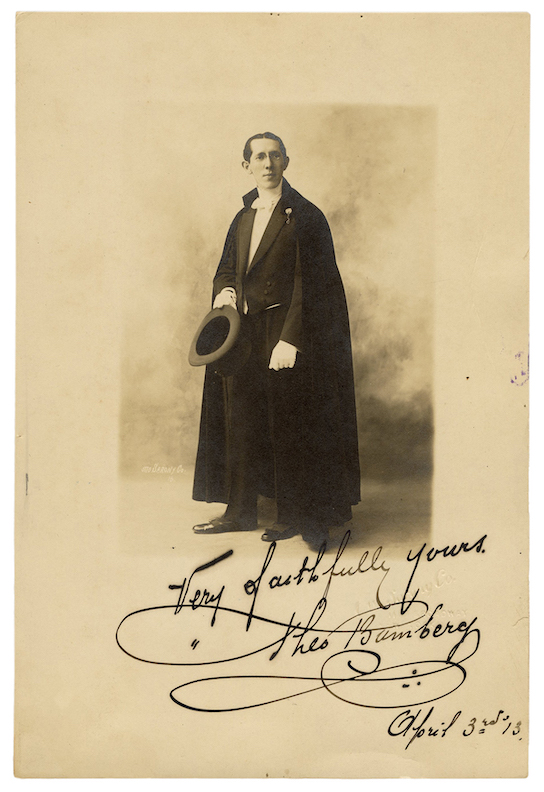
“Okito”-Tobias Bamberg.1913.
© Miss Cassette and myomahaobsession, 2024. Unauthorized use and/or duplication of this material without express and written permission from this site’s author and/or owner is strictly prohibited. Excerpts and links may be used, provided that full and clear credit is given to Miss Cassette and myomahaobsession with appropriate and specific direction to the original content.
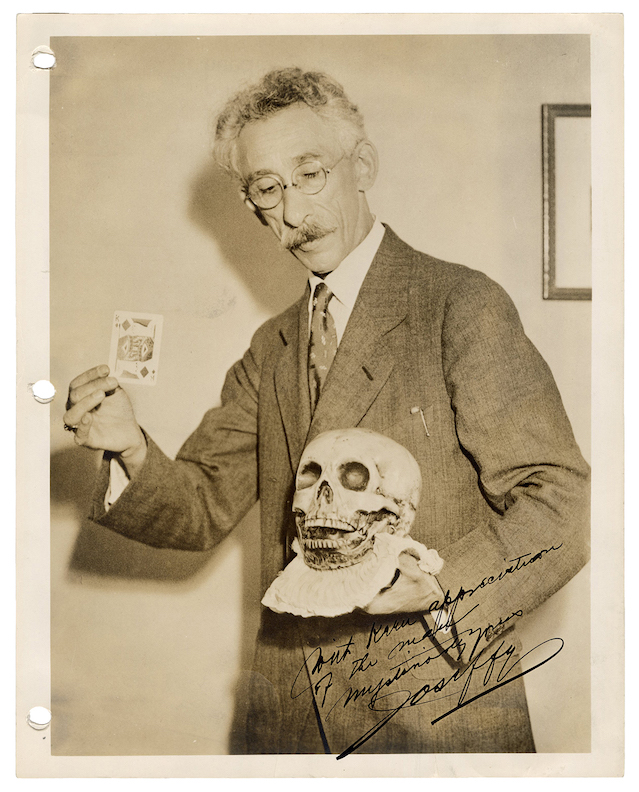
Beautiful Joseffy in 1932.
If you are looking for more architectural and Omaha history sleuthing fun, ask your local or bigbox bookseller for my book: My Omaha Obsession: Searching for the City. Also available everywhere online. Thank you.
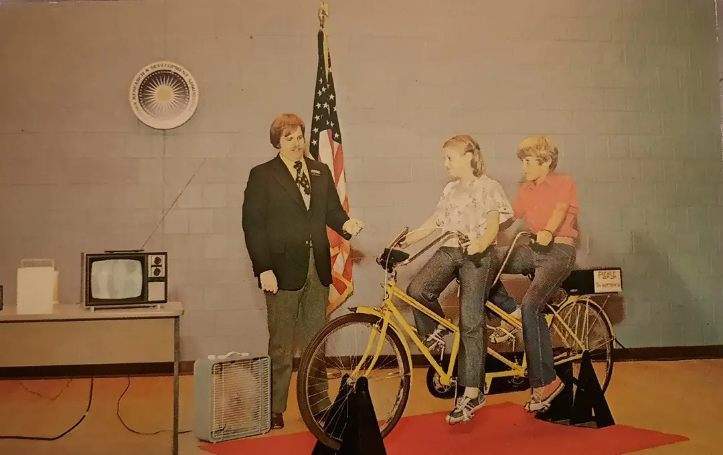
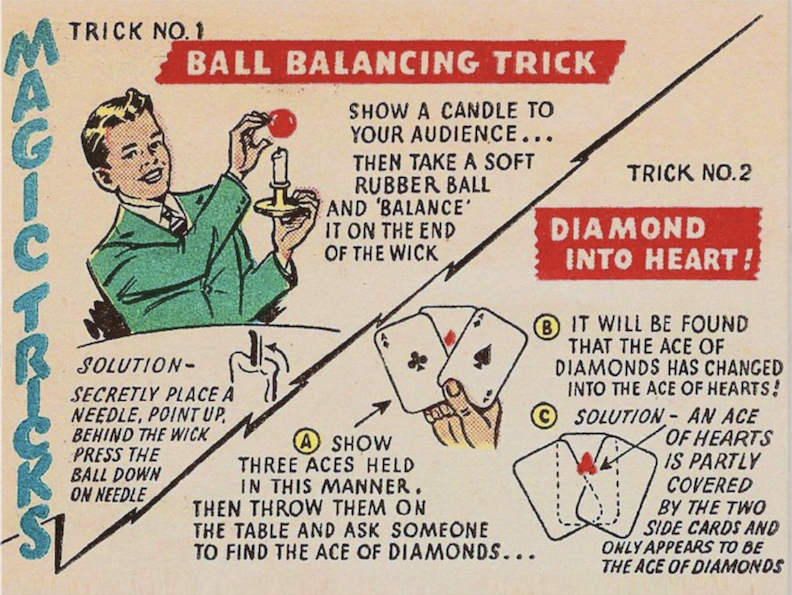
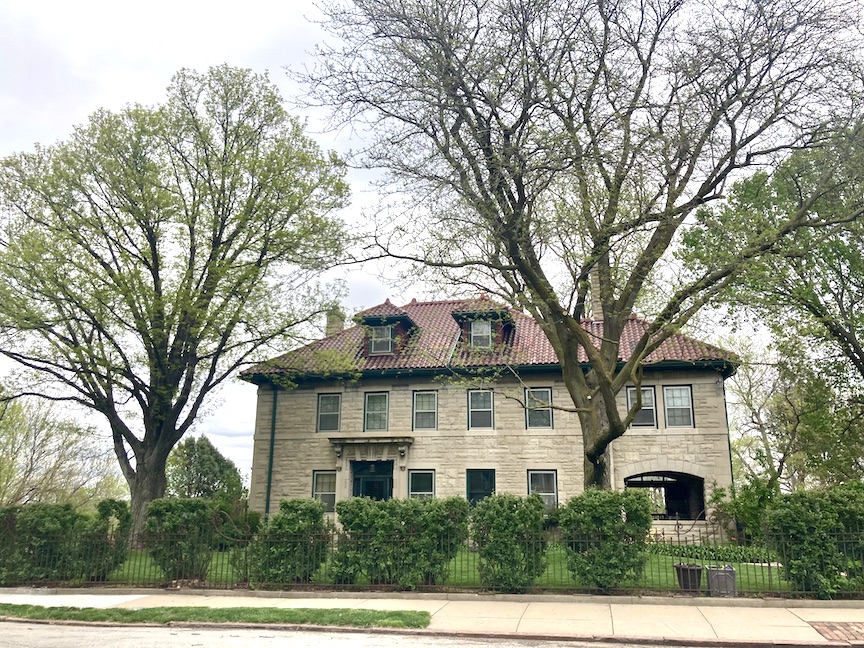
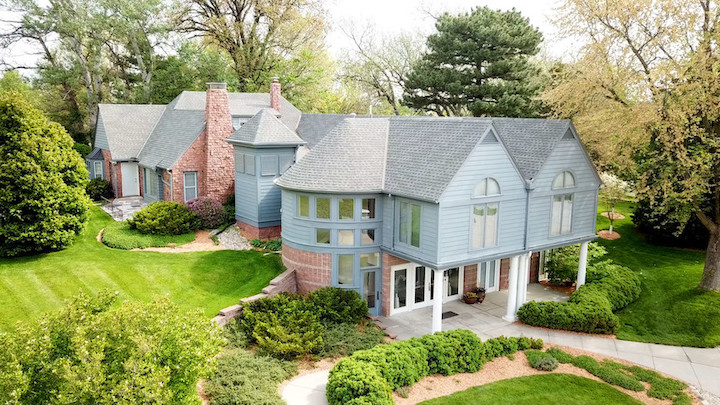
As a public library specialist and lifelong lover of research and history, this article is fabulous (and so is your book, which I read in one sitting)! I grew up on 32nd St and currently live on 32nd Avenue. I am a descendant of Nick Dargaczewski, the unofficial “Mayor” of Sheeleytown, and granddaughter of Max Neneman as in South “O’s” Neneman’s Bakery. So the Hanscom Park/Field Club neighborhood has always meant a lot to me and my family since the 1800’s. Anytime you write an article about our neighborhood I am reading it.
I have gone past this house my entire life and only knew it was “The Magician’s House” because my dad who grew up in the neighborhood on 31st St told me that. I forgot about the fire/icicle lights, but now I totally remember them! Such a shame that they were stolen. I hope someone tracks them down.
This is a truly beautiful home and I appreciate all the research you put into uncovering its history for us. I love how you lined up those original photos of the interior with the current ones, and how you honored the recent homeowner and their family. I just had to leave a comment because the amount of research you are doing is staggering and deserves HUGE props! Thank you for sharing this bit of history with us!
???? staggering indeed
Thank you, Melissa for taking the time to send this lovely. note. You have made me smile. I am glad to hear of your family. You must have grown up with the best stories!
Abbott performed for Harry Houdini here in Omaha. The Omaha Magical Society gives out the David P. Abbott award at their annual Wizards Banquet.
Thank you, Robert. It was all just here. And then, poof!
Brava! what a fascinating journey. Thank you! Before you happened to say it I was right there with you – the vestibule alone made my jaw drop (I’d looked at the current real estate web pages before reaching your photos). The custom millwork and lovely doors make me want to weep. Adding the remarkably rich layers of inhabitant history was just enormously satisfying icing on the cake. (Actually, now I can’t tell which is the cake and which is the icing).
Thank you, David. Thank you! The cake and the icing. I see it all in dreams.
What a wonderful magical story Miss Cassette!
One of your best!
I keep wanting to know what Abbott found in Wonder Girl that he so believed she wasn’t a crackpot.
I feel a screenplay in this one. Let’s team up and write a screenplay Miss Cassette! And take it to Netflix or HBO!
Thank you, Joseph. This makes me feel so good. There are many unanswered questions and I hope we continue to learn more!
Check out this link:
http://www.hollandarts.com/ArtNouveauItems.htm
I believe it’s the same glass shade
This is it! You are a genius. I’m going to include this in the story with the appropriate labeling. Thank you so much! Now that we’ve got the name, we need to find those two lamps!
Thank you for this story. The Vinton St info is close to my heart. I have a lot of family history there. As a young child I remember knowing Daren Schrat but it has been about 50 years since I last saw him. I am not exactly sure if we attended Sunday school together or if he went to my school for a year or two. We attended Cross Lutheran. It could have been that the Schrat family were acquaintances with my grandparents. My grandparents and uncles worked at South Side Turner Hall from the 50’s to the late 70s. This address is right next to Louie M’s. It is a unique art deco building. You may want to do a story on this building and the history of Turner Halls. According to my mom, my grandparents even had a restaurant at the front of Turner Hall for a time in the 50s. I imagine they interacted with the Schrat’s back in the day being so close together on Vinton St. When I was a child, my dad would sometimes take me to JK’s Bar or Goodman’s Bar (owned by the family of Johnny Goodman the great golfer) that also were nearby on Vinton St. When I was very young my dad worked at Ferd’s Bakery which was also there on Vinton. I was amazed that Carl was still working after being there for so many decades. Sorry if I rambled here.
Thank you for writing in Byron. I will make sure to get your comment over to Daren and the Schrats in case it jogs a memory. Thanks for the great details. Miss Cassette
This is amazing, Miss Cassette! Thank you for all the countless hours you spent providing your fans with
something for everyone! You are really a talented detective!
I add my hope for the sconces to be found, too…
Thank you, Victoria! This house still enters my dreams at night.
Thank you for doing what you do! You told this history so thoroughly and beautifully that I didn’t want it to end. We attended the open house. Stunningly preserved. I wonder what happened to the silk night sky curtain? Disintegrated with time probably. My mom worked at the ordnance plant in Mead, too. I wonder if she knew Tiny. Thank you again for the loving and careful work that you put in to everything you investigate. You’re an inspiration.
Thank you, Jules. This is so nice of you. I am glad that you were able to attend the Open House. I wonder what happened to that phonograph!
I really enjoyed really this article. My grandparents built the first business on that part of Center Street in 1912. If you enlarge the photo taken at 36 and Center looking east you can see the store. My dad and his three brothers were born it here. At first it was called L. Clanton and later it was called Clanton’s Foods. It was a grocery store and they delivered them. I remember going on delivery’s in the neighborhood with my dad in those Field Club alleys. They took all their family photos in front of the story since they lived there. I have a photo of part of the Wilkinson gas station. My dad sold the building in 1989. Now it’s Vis Major. Also Daren Schrat worked for my dad when he was a teenager. I lived at the store until I was five. After that I was there every day after school growing up. I love the neighborhood.
I loved reading this article and was so excited to read so many details about a house that was such a part of my personal history. My great aunts, then grandparents, (after they had both passed) lived next door at 3320 Center, the beige stucco with the enclosed porch pictured toward the end of your article. I spent many days playing with Daren when I visited my grandparents and remember the Shrat’s fondly.
I never knew the Abbott history of the home and look forward to a tour in the future when it reopens with the Magic Society. If the opportunity arises please let the Shrat family know that Annie Crawford sends her love. And thank you again for such a lovely detailed story.
Have you ever come across this gallery. very interesting, nice picture of the Clearview Home included
https://www.historicomaha.com/omhaair3.htm
Daren and I were friends in college and worked together at the NAPA store on Grover St back in the late 1980’s. I spent many hours in their garage working on Daren’s 1965 Pontiac GTO convertible. I was only in the house once and remember the long hallway on the 2nd floor. I had no idea of the homes history, and Daren never mentioned it all those years ago. Great article.